[BM] 03
IDENTITY IN CRISIS: ON HOW FASHION IS VALUED AND THE ALTERED MEANING OF LUXURY
POSTED ON 11.07.2020
IN CONVERSATION—
KAMONNART ONGWANDEE
SHONE PUIPIA
LAUREN YATES

When luxury goods are challenged and questioned from people with more awareness of the world’s problems and from those who hold onto different values in objects, luxury and exclusiveness in owning something may not be the key qualities that consumers are searching for anymore. How fashion luxuries are valued by the contemporary crowd? How today designers and producers relate their production and outcomes to those values? And what are fashion brands’s opinions toward the altered meanings of luxury affected by the environment, society or culture?
In this conversation, Kamonnart Ongwandee, textile designer and co-founder of the Fashion Revolution Thailand, has invited Lauren Yates of Ponytail Journal and a founder of W’menswear, a workwear clothing brand for women to talk with Shone Puipia, designer and owner of Shone Puipia, a contemporary wear brand offering a made-to-order service to its clientele in this era where fast fashion is heavily dominating the fashion market. They all share their branding philosophy, backgrounds and past experiences that led them into fashion as well as their common interests in history as a reflection of what is happening in the world today and a base for their reinterpretations. This conversation is about their views on gender, about its fluidity mirrored in structures and details of their feminine-masculine clothes. It talks about all things that matter in today’s fashion, from the urban context to local wisdom and technology as the driving forces to sustainability in design and quality and how fashion brands should concern themselves with current social issues and how to express them out, whether they be about the environment or race, through their production process or their communication strategy.
เมื่อสินค้าลักซ์ชัวรี่ ถูกท้าทายด้วยคำถามจากผู้คนที่เริ่มตระหนักถึงปัญหาที่เกิดขึ้นในโลก และจากการที่ผู้คนให้คุณค่ากับสิ่งของเปลี่ยนไป ความหรูหราและสิทธิพิเศษในการครอบครอง อาจไม่ใช่คุณสมบัติหลักของสินค้าที่ผู้บริโภคมองหา สินค้าที่เรียกได้ว่าฟุ่มเฟือยอย่างแฟชั่น ถูกให้คุณค่าอย่างไรโดยผู้บริโภคในปัจจุบัน แล้วในฝั่งของผู้ผลิต มองกระบวนการและผลลัพธ์สัมพันธ์กับคุณค่าของผู้คนร่วมสมัยอย่างไร ความคิดเห็นของแบรนด์เสื้อผ้าต่อความหมายของลักซ์ชัวรี่ต่างจากเดิมเพราะปัจจัยด้านสิ่งแวดล้อม สังคม และวัฒนธรรมอย่างไร
บทสนทนาชิ้นนี้ กมลนาถ องค์วรรณดี นักออกแบบสิ่งทอ และตัวแทนของกลุ่มขับเคลื่อนทางสังคม Fashion Revolution ประเทศไทย ได้ชวนลอเรน เยทส์ เจ้าของไดอารี่ออนไลน์ Ponytail Journal และเจ้าของแบรนด์ W’menswear เสื้อผ้าสำหรับผู้หญิงในแพทเทิร์นเสื้อผ้าแบบเวิร์คแวร์ กับ โชน ปุยเปีย เจ้าของแบรนด์ Shone Puipia เสื้อผ้าร่วมสมัยที่ผลิตตามสั่งสวนกระแสเสื้อผ้าฟาสต์แฟชั่น ร่วมพูดคุยถึงปรัชญาเบื้องหลังของแบรนด์ บริบทแวดล้อมและประสบการณ์ที่พาทั้งคู่มาสู่การทำเสื้อผ้า ความสนใจร่วมกันในการมองไปที่ประวัติศาสตร์ ในฐานะที่เป็นเสียงสะท้อนของปัจจุบัน และเป็นรากฐานของการตีความใหม่ มุมมองต่อเรื่องของเพศสภาพที่เข้ามาอยู่ในการถ่ายโอนของโครงสร้างเสื้อผ้าระหว่างกันของหญิงและชาย ความคิดเกี่ยวกับบริบทของเมือง ภูมิปัญญา เทคโนโลยีของแต่ละท้องถิ่นที่เป็นปัจจัยที่ผลักดันวิธีคิดถึงการออกแบบอย่างยั่งยืนและมีคุณภาพ แบรนด์เสื้อผ้าควรต้องตอบสนองต่อประเด็นทางสังคม ไม่ว่าจะเป็นเรื่องสิ่งแวดล้อม ผ่านกระบวนการผลิต หรือประเด็นทางสังคมเรื่องของเชื้อชาติ ผ่านวิธีการสื่อสารแบบใด
Kamonnart Ongwandee (Ung) — First, I would like you guys to introduce yourself and the beginning of your brand. Could you tell me a little bit about your background, your upbringing and what brought you to fashion?
Shone Puipia (Shone) — I was born and based in Bangkok. I grew up in an artistic atmosphere, both of my parents are artists. I knew that I wanted to go into fashion when I was in my last two years of high school. Back then I was taking French class at the Alliance Français and got a chance to try taking pattern making classes there. I really fell in love with the practical, crafted side of it, turning something two dimensional to three dimensional in a way like making sculpture with fabric. That’s the kind of starting point. Then I researched where I could do my study and discovered Dries Van Noten from reading a book. It opened my eyes to the Antwerp school and the Belgian designers. I fell in love with their works and their ways of thinking. That was how I decided to apply to the fashion department at Antwerp Academy (Royal Academy of Fine Arts Antwerp). It has an art school atmosphere. It is quite small, like a community. And its works are different from other places. I was there for four years from 2012 until I graduated in 2016. I stayed for a year afterward to do some projects with friends. I moved back to Bangkok in 2017 and really started the Shone Puipia brand.
กมลนาถ องค์วรรณดี (อุ้ง) — อยากให้ช่วยแนะนำตัวและเล่าจุดเริ่มต้นของแบรนด์ให้ฟังหน่อย โชนมีแบ็คกราวด์และการเติบโตยังไง อะไรทำให้สนใจทำแฟชั่น?
โชน ปุยเปีย (โชน) — เราเกิดและโตที่กรุงเทพฯ ในบ้านที่มีบรรยากาศของศิลปะ ทั้งพ่อและแม่เป็นศิลปิน เรารู้ว่าตัวเองอยากทำแฟชั่นช่วงสองปีสุดท้ายตอนเรียนม.ปลาย ตอนนั้นกำลังเรียนภาษาฝรั่งเศสที่สมาคมฝรั่งเศสกรุงเทพ แล้วมีโอกาสได้ลองเรียนคลาสสร้างแพทเทิร์นเสื้อผ้าที่นั่น เราตกหลุมรักการทำแพทเทิร์นตรงที่มันมีความเป็นงานฝีมือ เป็นการเปลี่ยนงานสองมิติให้เป็นงานสามมิติ เหมือนสร้างงานประติมากรรมด้วยผ้า นั่นน่าจะเป็นจุดเริ่มต้น หลักจากนั้น เราเริ่มทำรีเสิร์ชว่าจะไปเรียนต่อที่ไหน แล้วได้รู้จักชื่อ ดรีส ฟาน โนเทน (Dries Van Noten) จากหนังสือเล่มนึงที่อ่าน มันเปิดโลกเราให้รู้จักโรงเรียนที่อันท์เวิร์ป ให้รู้จักดีไซเนอร์เบลเยี่ยม เราตกหลุมรักงานและวิธีการคิดงานของพวกเขา เลยตัดสินใจสมัครเรียนแผนกแฟชั่นที่อันท์เวิร์ปอะคาเดมี่ (Royal Academy of Fine Arts Antwerp) ที่โรงเรียนมีบรรยากาศของโรงเรียนศิลปะ เป็นโรงเรียนเล็กๆ เหมือนเป็นคอมมูนิตี้ แล้วงานที่นั่นก็ต่างจากที่อื่นๆ เราอยู่ที่นั่นสี่ปีตั้งแต่ปี 2555 จนถึงตอนเรียนจบเมื่อปี 2559 แล้วอยู่ต่ออีกปีเพื่อทำโปรเจกต์กับเพื่อน เราย้ายกลับมากรุงเทพฯ ตอนปี 2560 แล้วถึงเริ่มแบรนด์ โชน ปุยเปีย แบบจริงจัง
Ung — What about you Lauren?
Lauren Yates (Lauren) — I never learned fashion design in any formal sense. I was born in Hong Kong and when I was two I moved to Thailand and when I was eight my family relocated to Australia. After I graduated from high school, I decided I wanted to be an artist. So, I went to Sydney College of the Arts and I studied photography. For me, it was a very confusing time because I thought I would learn a technical profession and I could use that in a real world. But the art school that I went to was a postmodern system where they threw technique out the window and they burnt down all understanding or the meaning I had in my head, it left me just in complete confusion. Without problem solving skills, framework of your art practice, and your techniques, you have no tools to solve any questions. After a year of trying to work as an artist from the time I graduated, I decided I wanted to move back to Bangkok, retrace my steps and figure out who I am. Moving back to Bangkok, I fell into modelling as some people might do when they are lost (laughter). I had a lot of time in waiting rooms to think about being and that’s when I started Ponytail Journal to write and explore things I was interested in. So, I committed myself to making a framework to write at least one article every single day. I did that for three years straight. I’d been contacted by a bunch of magazines to write for them like Vogue Australia. I wrote about style and culture for them for about three years. I was very fortunate to explore the world in different ways, to have a platform that allowed me to interview people that I felt really important. I got an opportunity to interview Nigel Cabourn, a British menswear designer whose practice I really respected. When we had the interview, we got along straight away and we became great friends. He’s the person who told me to think about starting my own fashion line, selling it on my own site. So, I partnered up with a guy called Ben Viapiana, a Canadian denim tailor who was based in Bangkok. We started on a really tight small collection, like, only six styles in three colorways that were all very small-batch, and tailor made on vintage denim machines. Nigel taught me everything about fashion design, creating, and running a business. For some reason he was kind enough to introduce me to his business partner, a distributor in Japan. The first collection we launched in Japan only, doing wholesale with my random, small collection of canvas like workwear. From then on, I sold in Japan for four seasons and decided I wanted to be more independent so I started the wholesale circuit independently in Paris and in New York. That’s how I got where I got to now.
อุ้ง — แล้วลอเรนล่ะ มีจุดเริ่มต้นยังไง?
ลอเรน เยทส์ (ลอเรน) — เราไม่เคยเรียนออกแบบแฟชั่นแบบจริงๆ จังๆ เลย เราเกิดที่ฮ่องกง ตอนสองขวบก็ย้ายมาอยู่เมืองไทยก่อนจะย้ายไปอยู่ที่ออสเตรเลียตอนแปดขวบ หลังจบไฮสกูล เราอยากเป็นศิลปิน เลยไปเรียนที่วิทยาลัยศิลปะซิดนีย์ (Sydney College of the Arts) ตอนนั้นเป็นช่วงที่สับสนมาก เพราะคิดว่าเราจะได้เรียนเทคนิคในการทำงานที่เอาไปใช้ได้ในชีวิตจริง แต่โรงเรียนศิลปะที่เราเรียนเป็นระบบโพสต์โมเดิร์นที่โยนเทคนิคทิ้งนอกหน้าต่าง เผาทุกอย่างที่เราเข้าใจหรือความหมายที่เราคิดว่าเรารู้ไปหมด เหมือนทิ้งเราไว้แบบมืดแปดด้าน พอคุณไม่มีทักษะในการแก้ปัญหา ไม่มีกรอบการทำงานศิลปะ ไม่รู้เทคนิค คุณก็ไม่มีเครื่องมือในการแก้ปัญหาเลย หลังพยายามเป็นศิลปินหลังเรียนจบอยู่ปีนึง เราตัดสินใจย้ายกลับมากรุงเทพฯ ย้อนดูว่าเราเป็นใครและอยากทำอะไร พอย้ายกลับมาอยู่กรุงเทพฯ ก็มีโอกาสได้ทำงานเป็นนางแบบ คือตอนนั้นมันเป็นงานที่คนที่กลับมาจากเมืองนอกจะลองทำดูเวลาไม่รู้ว่าจะทำอะไรดี (หัวเราะ) ทีนี้ ระหว่างที่ต้องนั่งรอทำงาน ซึ่งมีเวลาค่อนข้างเยอะ เราก็เริ่มคิดถึงชีวิตตัวเอง ตอนนั้นเลยเริ่มทำไดอารี่ออนไลน์ชื่อ Ponytail Journal เขียนถึงเรื่องที่สนใจ ตั้งใจวางกรอบให้ตัวเองว่าจะเขียนอย่างน้อยวันละบทความทุกวัน ตอนนั้นทำติดต่อกันสามปีเต็ม มีนิตยสารติดต่อเข้ามาให้เขียนบทความให้เยอะ อย่างโว้ก ออสเตรเลีย ก็มาให้เราเขียน เราเขียนเกี่ยวกับสไตล์และคัลเจอร์ประมาณสามปี โชคดีที่มีโอกาสได้เดินทางไปที่ต่างๆ มีแพลตฟอร์มที่เปิดโอกาสให้ได้สัมภาษณ์คนที่เราคิดว่าสำคัญ ครั้งนึงเรามีโอกาสสัมภาษณ์ ไนเจล คาร์บอร์น (Nigel Cabourn) ดีไซเนอร์อังกฤษที่เราเคารพในแนวคิดการทำงานของเขามาก หลังสัมภาษณ์ก็กลายมาเป็นเพื่อนกัน เขาเป็นคนบอกให้เราลองคิดเรื่องทำไลน์แฟชั่นแบรนด์ขายในเว็บของเราเอง เราเลยเข้าหุ้นกับ เบน เวียเปียน่า (Ben Viapiana) ช่างตัดกางเกงเดนิมจากแคนาดาที่อยู่ที่กรุงเทพฯ พวกเราเริ่มจากการทำคอลเลกชั่นเล็กๆ มีกางเกงแค่หกทรงสามสี เป็นเดนิมวินเทจที่ผลิตจำนวนไม่มาก ไนเจลเป็นคนสอนเราทุกอย่างเกี่ยวกับการออกแบบแฟชั่น การสร้างและทำธุรกิจ ด้วยเหตุผลบางอย่าง เขาใจดีแนะนำเรากับหุ้นส่วนทางธุรกิจของเขาซึ่งเป็นผู้จัดจำหน่ายในญี่ปุ่น จากนั้น เราทำคอลเลกชั่นแรกที่มีวางเฉพาะที่ญี่ปุ่นเป็นแบบขายส่ง เป็นงานสไตล์เวิร์กแวร์ตัดเย็บจากผ้าแคนวาส หลังจากนั้น เราทำงานขายที่ญี่ปุ่นอยู่สี่ซีซั่น ก่อนตัดสินใจว่าอยากทำแบรนด์ขายส่งของตัวเองแบบอิสระที่ปารีสกับนิวยอร์ก นั่นทำให้เรามาถึงจุดที่อยู่ตอนนี้
Ung — For your concept and inspiration of your brand Shone Puipia where did you get your inspiration or your creative sources? Where does it flow from?
Shone — It’s very hard to pinpoint on one thing. I really loved doing collages. Before I started designing collections I like to think of what atmosphere or stories I have been moved by. I always went for the medium of collage, collecting source images, chopping them up, making new images out of it. It helps me a lot with my thinking process. In a way, a cloth is like a collage of things, from art, from film, from music, from historical periods. Everything is matched up to tell my own story. Collection 2020 Cloudbusting was initially going to be a collaborative performance with Barcelona-based singer-songwriter, Uma Bunnag. Her music and the notion of ‘the performer’ was integral to the design process. We were also looking a lot at female Baroque artists, such as Artemisia Gentileschi and Elisabetta Sirani, and worked to capture the gestures from those paintings into a sophisticated wardrobe for today.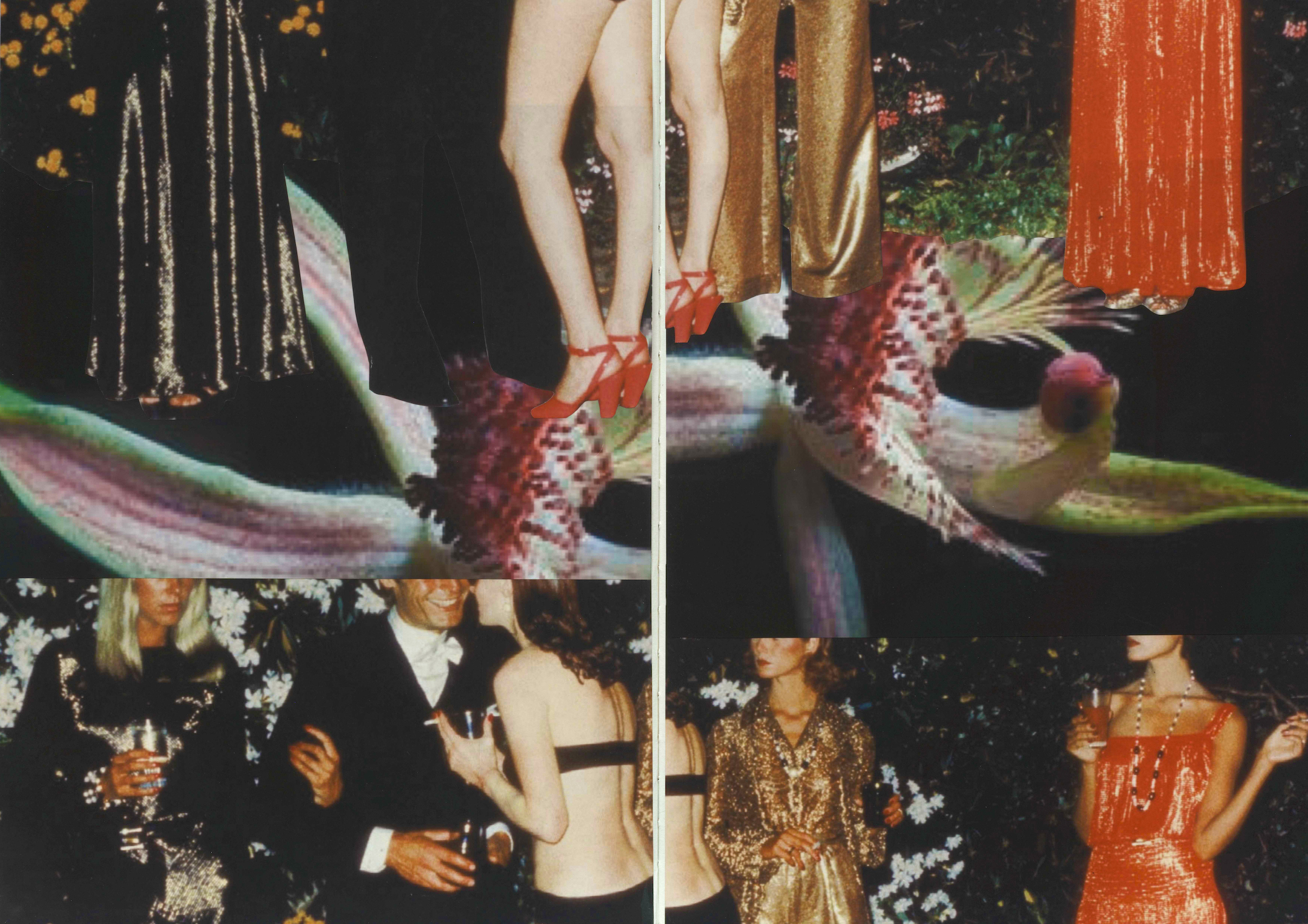
pic. 1 — The Wild Bunch Collage Book © Shone Puipia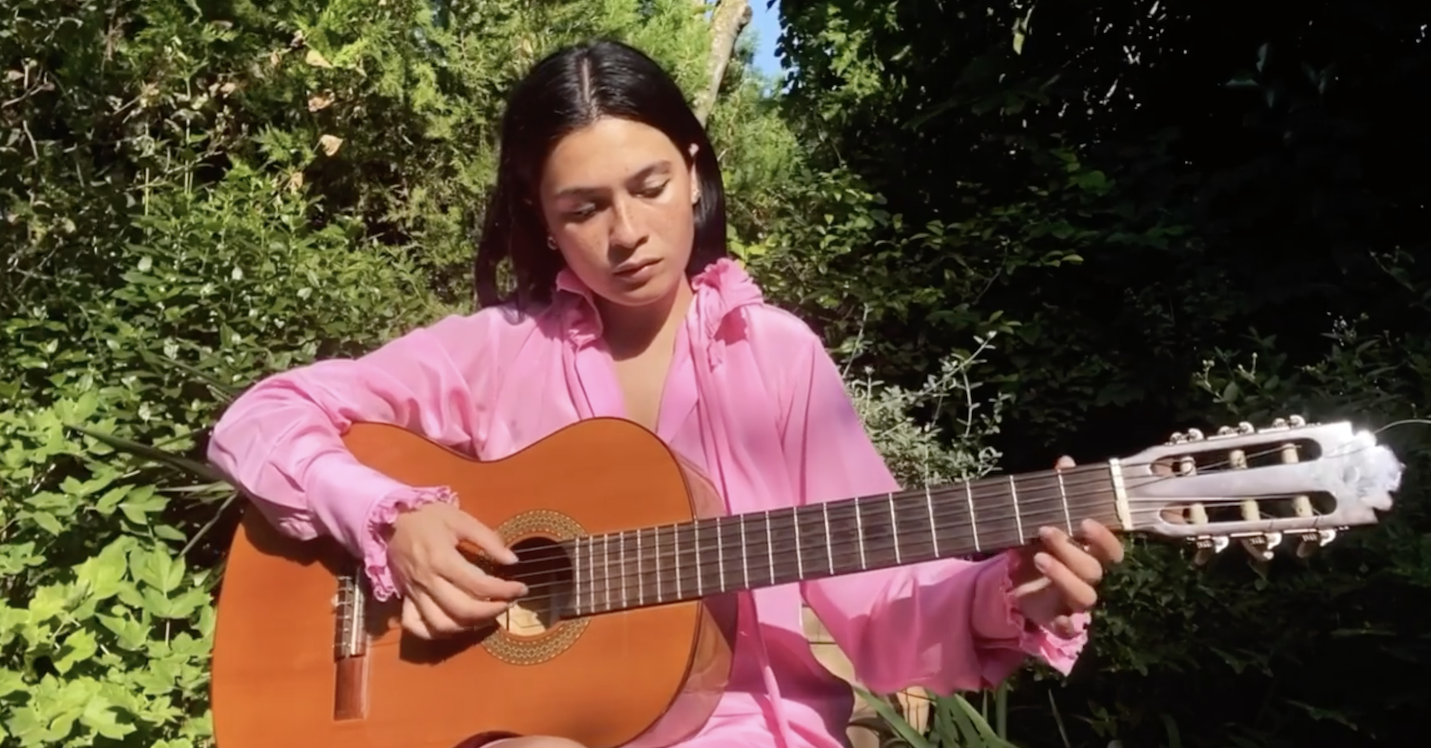
pic. 2 — “Mockingbird” by Uma Bunnag © Shone Puipia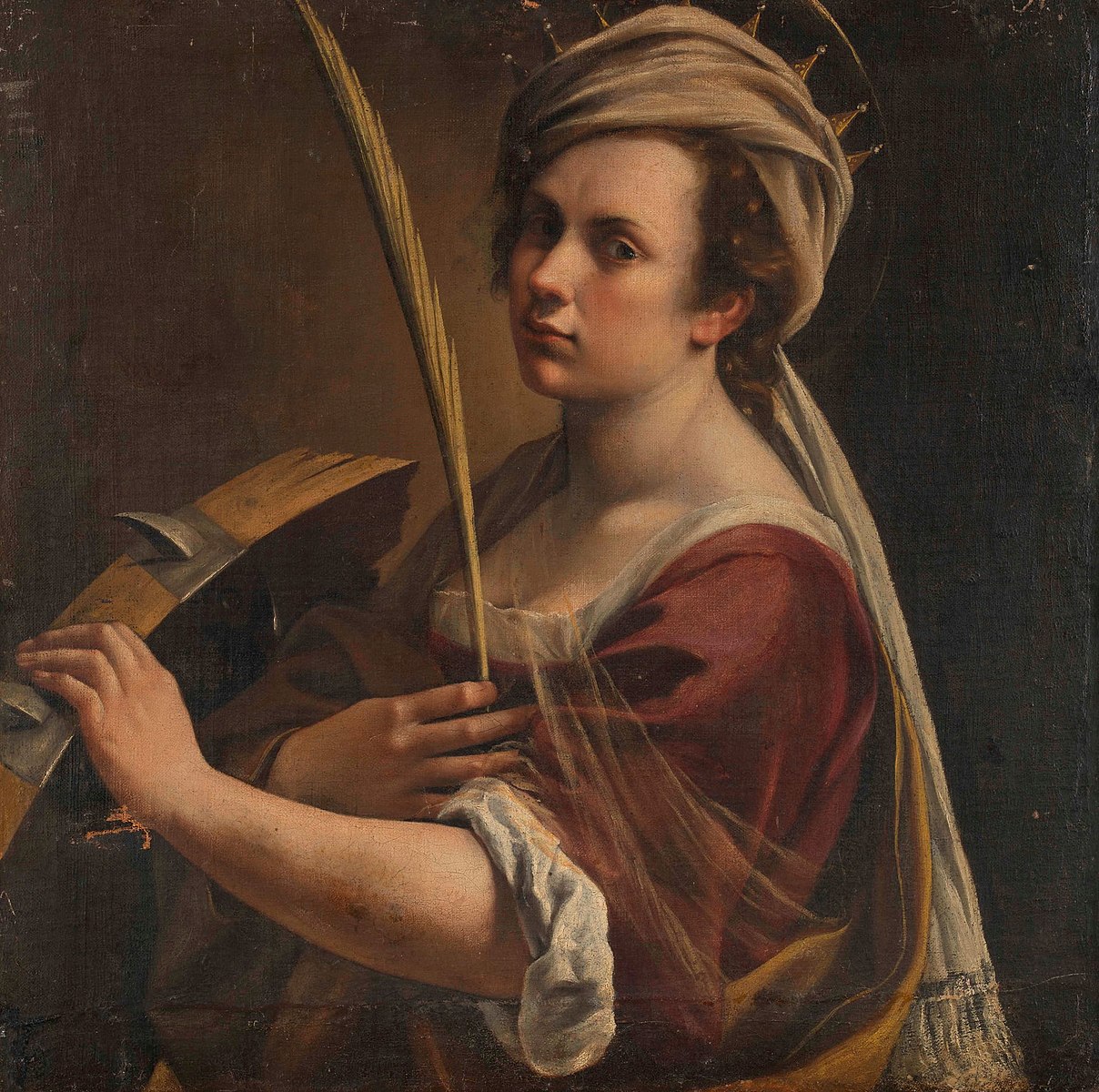
pic. 3 — Self-Portrait as Saint Catherine of Alexandria by Artemisia Gentileschi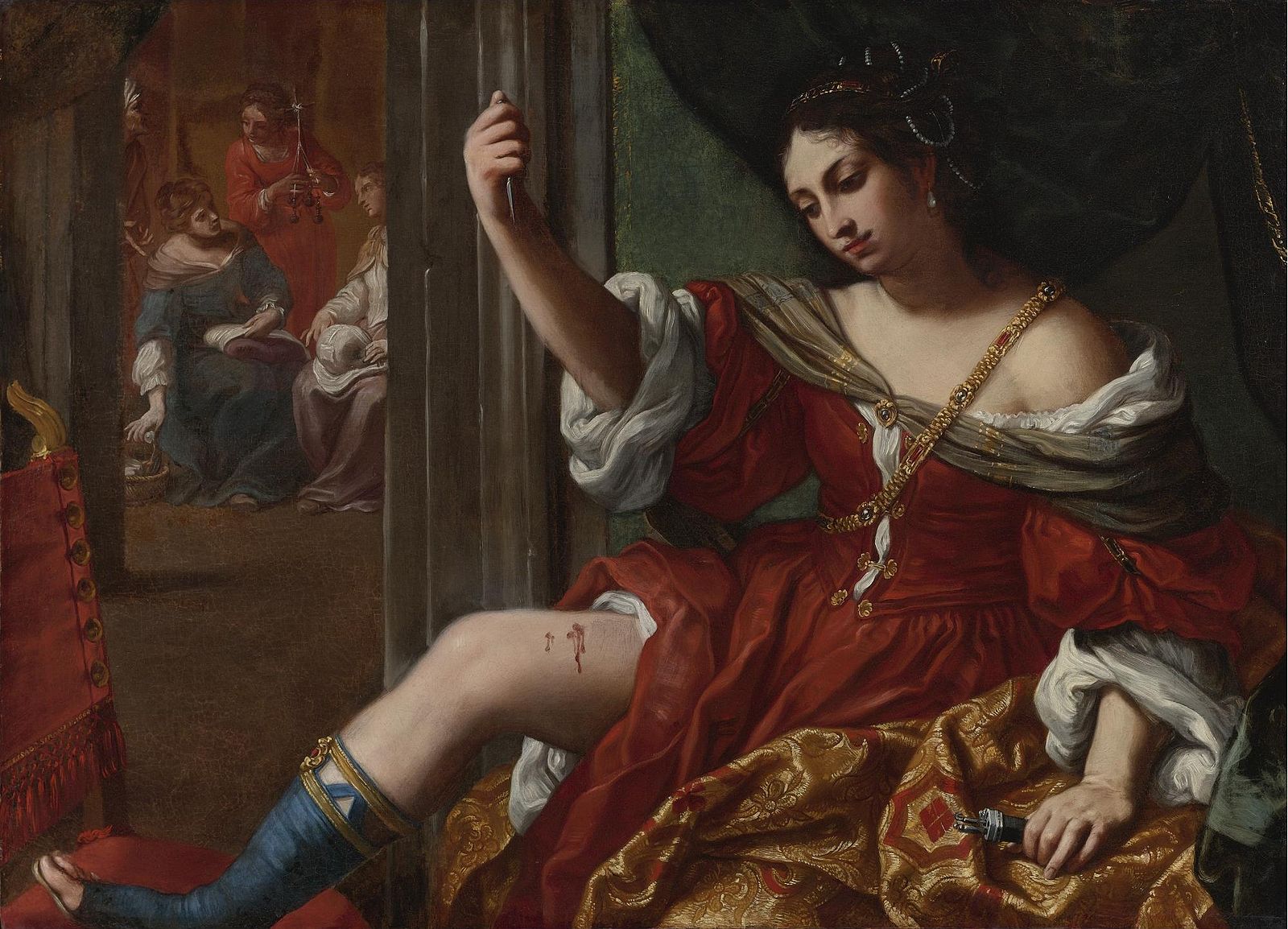
pic. 4 — Portia Wounding Her Thigh (is a scene from Roman history) by Elisabetta Siran
I spent a lot of time with my family at museums, going to art shows and exhibitions, and going to the movies a lot, watching all kinds of films. For the historical aspect in my work I think it started from my second year in school. There was a historical costume project that we had to pick up a costume from source painting and research on how everything was made, from undergarments like corset to the haute couture layer. I had a great time working on that. There are a lot of details in structure, the way things were made historically that you can play with in a new way now, apply them to modern day clothing. Most recently for Collection 2020 Cloudbusting, I wanted to explore new ideas in tailoring and looked a lot into the construction and patterns of 18th-century cutaway court coats. Not only was I intrigued by the architectural aspects of these pieces, but also how their elegant sweeping lines can subvert traditionally masculine aspects of the ‘suit’.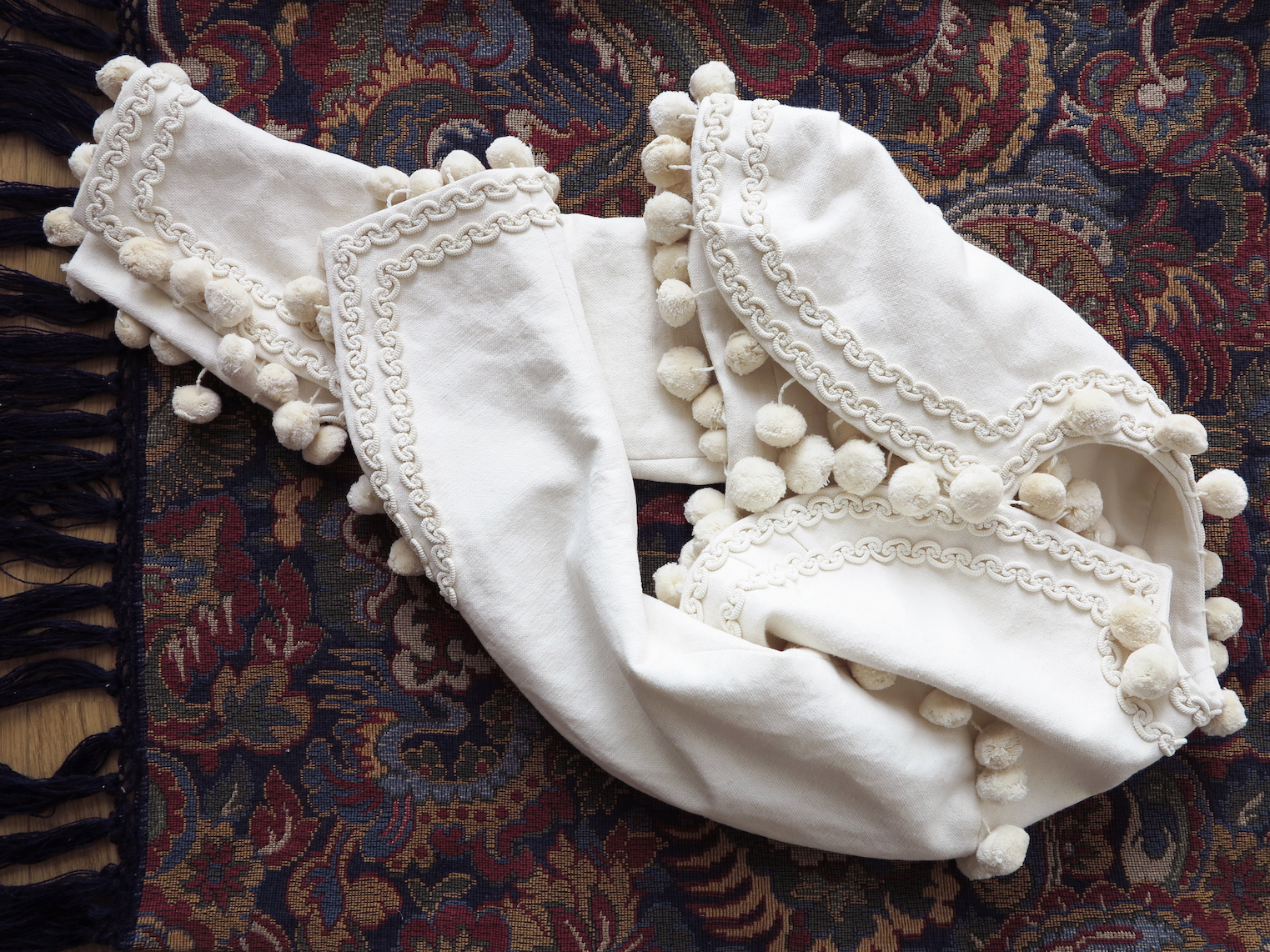
pic. 5 — Zouave jacket is a historical costume that is popular in America in the 19th Century © Shone Puipia
pic. 6 — A corset inspired costume. © Shone Puipia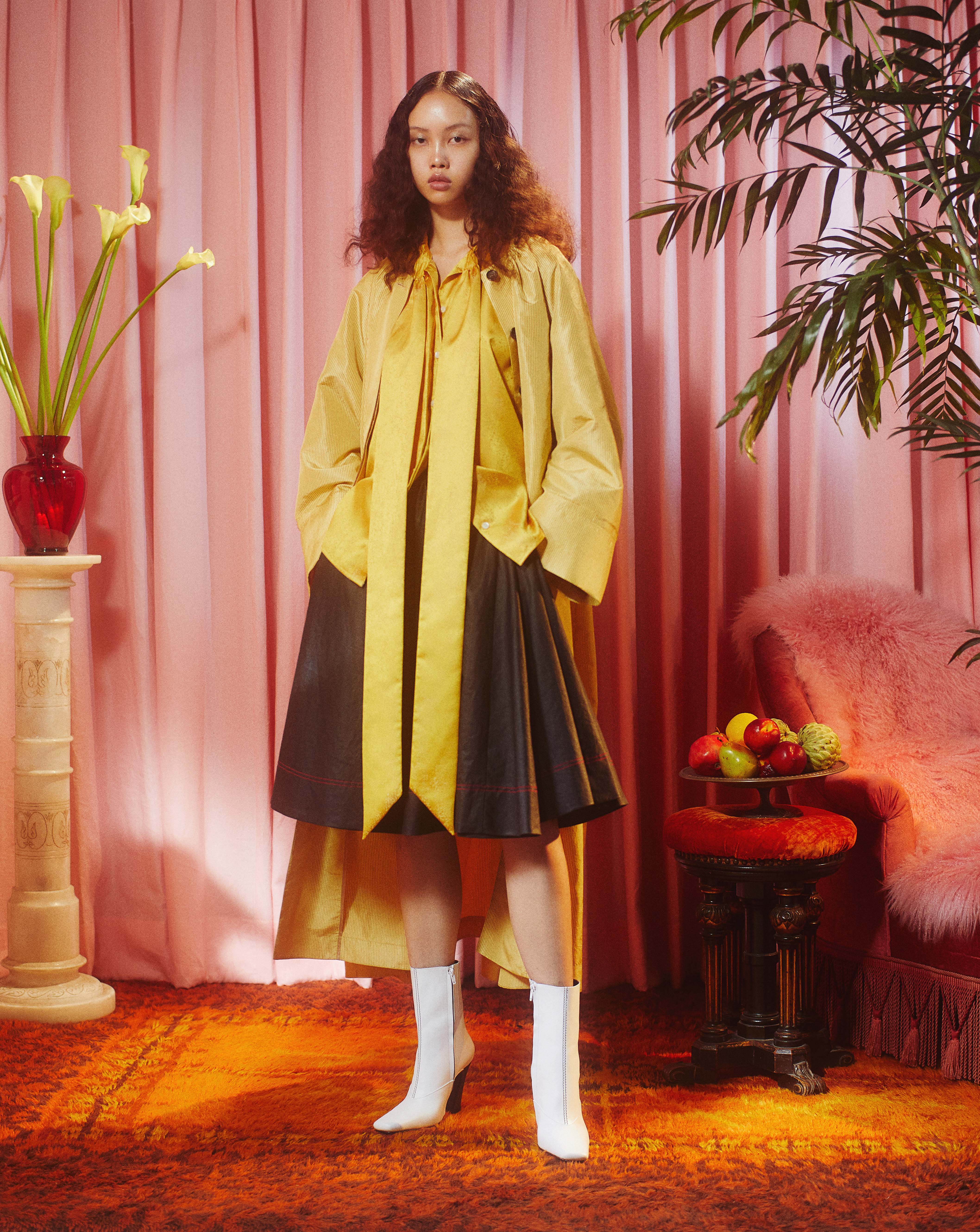
pic. 7 — Shone Puipia Cloudbusting Collection 2020 lookbook © Shone Puipia
pic. 8 — Shone Puipia Cloudbusting Collection 2020 lookbook © Shone Puipia
อุ้ง — สำหรับโชน แนวคิดและแรงบันดาลใจในการทำแบรนด์โชน ปุยเปียมาจากไหน มีที่มาจากอะไร
โชน — สรุปออกมาเป็นอย่างเดียวยากอยู่ เราชอบทำคอลลาจ ก่อนจะทำคอลเลกชั่น เราจะคิดถึงบรรยากาศหรือเรื่องราวที่เรารู้สึกไปกับมัน เราเลือกสื่อความรู้สึกผ่านงานคอลลาจเสมอ สะสมภาพต่างๆ ตัดเป็นรูปทรง แล้วมาสร้างเป็นภาพใหม่ๆ ขึ้นมา ซึ่งช่วยในกระบวนการคิดงานของเรามาก ในแง่หนึ่ง เสื้อผ้าเป็นเหมือนคอลลาจของสิ่งต่างๆ ตัดแปะขึ้นมาจากศิลปะ จากภาพยนตร์ จากดนตรี หรือช่วงเวลาในประวัติศาสตร์ แต่ละสิ่งถูกจับคู่เข้าด้วยกันเพื่อเล่าเรื่องในแบบของเราเอง อย่าง Cloudbusting คอลเลกชั่นปี 2563 เดิมทีจะออกมาเป็นการแสดงที่เราทำร่วมกับอุมา บุนนาค นักร้องและนักแต่งเพลงที่อยู่ที่บาร์เซโลน่า เพลงและแนวคิดเกี่ยวกับ ‘นักแสดง’ ของอุมาได้ถูกนำมาใช้ในกระบวนการออกแบบคอลเลกชั่นนี้ พวกเรายังกลับไปดูงานศิลปินบาโรกหญิงอย่าง อาร์เตมิเซีย เจนทิเลสคิ (Artemisia Gentileschi) และเอลิซาเบตต้า ซิรานิ (Elisabetta Sirani) และจับเอาท่าทีในภาพวาดเหล่านั้นมาสร้างเครื่องแต่งกายที่มีรายละเอียดซับซ้อนที่เหมาะกับปัจจุบัน 
รูป 1 — The Wild Bunch Collage Book © Shone Puipia
รูป 2 — “Mockingbird” โดย อุมา บุนนาค © Shone Puipia
รูป 3 — ภาพแคทเทอรีนแห่งอเล็กซานเดรีย วาดขึ้นจากภาพวาดเหมือนตนเอง โดย อาร์เตมิเซีย เจนทิเลสคิ
รูป 4 — ปอเตียร์แทงต้นขาตนเอง (ภาพวาดจากประวัติศาสตร์โรมัน) โดย เอลิซาเบตต้า ซิรานิ
เราใช้เวลาส่วนใหญ่กับครอบครัว ไปพิพิธภัณฑ์ ไปชมงานศิลปะ ไปดูนิทรรศการ แล้วก็ได้ดูหนังเยอะมาก ดูทุกแนว ส่วนแง่มุมที่มาจากประวัติศาสตร์ในงานออกแบบของเราน่าจะมาจากตอนเรียนปีสอง มีโปรเจกต์ทำคอสตูมจากภาพวาดที่ต้องให้เราศึกษาว่าชุดที่เห็นในภาพนั้นตัดเย็บขึ้นมาได้อย่างไร ตั้งแต่ชุดชั้นในอย่างคอร์เซ็ต ไปจนถึงชั้นนอกเป็นงานโอต คูตูร์ เราสนุกมากตอนทำโปรเจกต์นั้น มีรายละเอียดเยอะแยะในโครงสร้างของเสื้อผ้า วิธีที่สิ่งต่างๆ ถูกสร้างขึ้นในประวัติศาสตร์ ที่คุณสามารถเล่นกับมันด้วยวิธีการใหม่ๆ ได้ในตอนนี้ แล้วประยุกต์ใช้มันทำเสื้อผ้าสมัยใหม่ กลับมาที่คอลเลกชั่นปี 2563 Cloudbusting เราอยากทดลองการตัดเย็บใหม่ๆ และกลับไปดูการขึ้นโครงสร้างของเสื้อผ้าและแพทเทิร์นของเสื้อโค้ตหางยาวแบบราชสำนัก (cutaway court coat) ในศตวรรษที่ 18 นอกจากเราจะตื่นเต้นกับแง่มุมเชิงสถาปัตยกรรมในเสื้อโค้ตพวกนี้ เรายังสนใจเส้นสายที่ดูสวยสง่า ที่สามารถทำลายแง่มุมความเป็นชายของ ‘เสื้อสูท’ ลงได้
รูป 5 — เสื้อแจคเก็ตที่ได้แรงบันดาลใจจากเครื่องแต่งกายในประวัติศาสตร์ที่เรียกว่า Zouave jacket เป็นที่นิยมในช่วงคริศตศตวรรษที่ 19 ในอเมริกา © Shone Puipia
รูป 6 — ชุดที่ได้แรงบันดาลใจจากโครงเสื้อคอร์เซ็ต © Shone Puipia
รูป 7 — ลุคบุ๊ค Shone Puipia Cloudbusting Collection 2020 © Shone Puipia
รูป 8 — ลุคบุ๊ค Shone Puipia Cloudbusting Collection 2020 © Shone Puipia
Ung — What about you, Lauren?
Lauren — W’menswear’s slogan is ‘hard-hitting garments for hard-hitting women’. I think the brand is about finding meaning, and understanding what it means to exist today. I find it helpful to look at history and to understand what paved the way to where we are now. Every collection we look into a specific point of time in history that might mirror something that is happening now. And just like Shone, we use ‘collage’ to put together our research. For example, Spring 20 that’s out now is called Tektite IV. So we looked into the post Cold War period. We looked into war technology that was developed in the Cold War, and how it was actually used for scientific research after the Cold War ended. These technologies were used to map the ocean floor, which we’d never mapped beforehand. Then we found the deepest point on earth, the Mariana Trench, using sonar technology and deep sea submarines. We discovered a lot about our planet and we were able to advance science due to this chaotic thing that was war. That’s a way I explore the forces of order and chaos, and how we kind of always exist on this fine line between the two. If you sway too far on either end of the scale it can lead to being out of balance. For example, you lean too far to order, you have Marxism or Stalin’s regime in Russia and that became a form of oppression. Millions of people died. That led to the Cold War. And from that chaos, order forms. It’s like the Yin and Yang symbol, or the really old symbol of a dragon eating its tail. It’s like a repeating cycle that you see in nature, science, and the universe in itself. When we do the research, we gather information on a big coakboard in the studio. We look at the materials and the colours which Shone probably relates to, seeing all the pieces together in one place. You see new patterns forming, you see colours that keep repeating themselves and you see technology. For me, the creative process comes from looking into yourself and the context you’re in.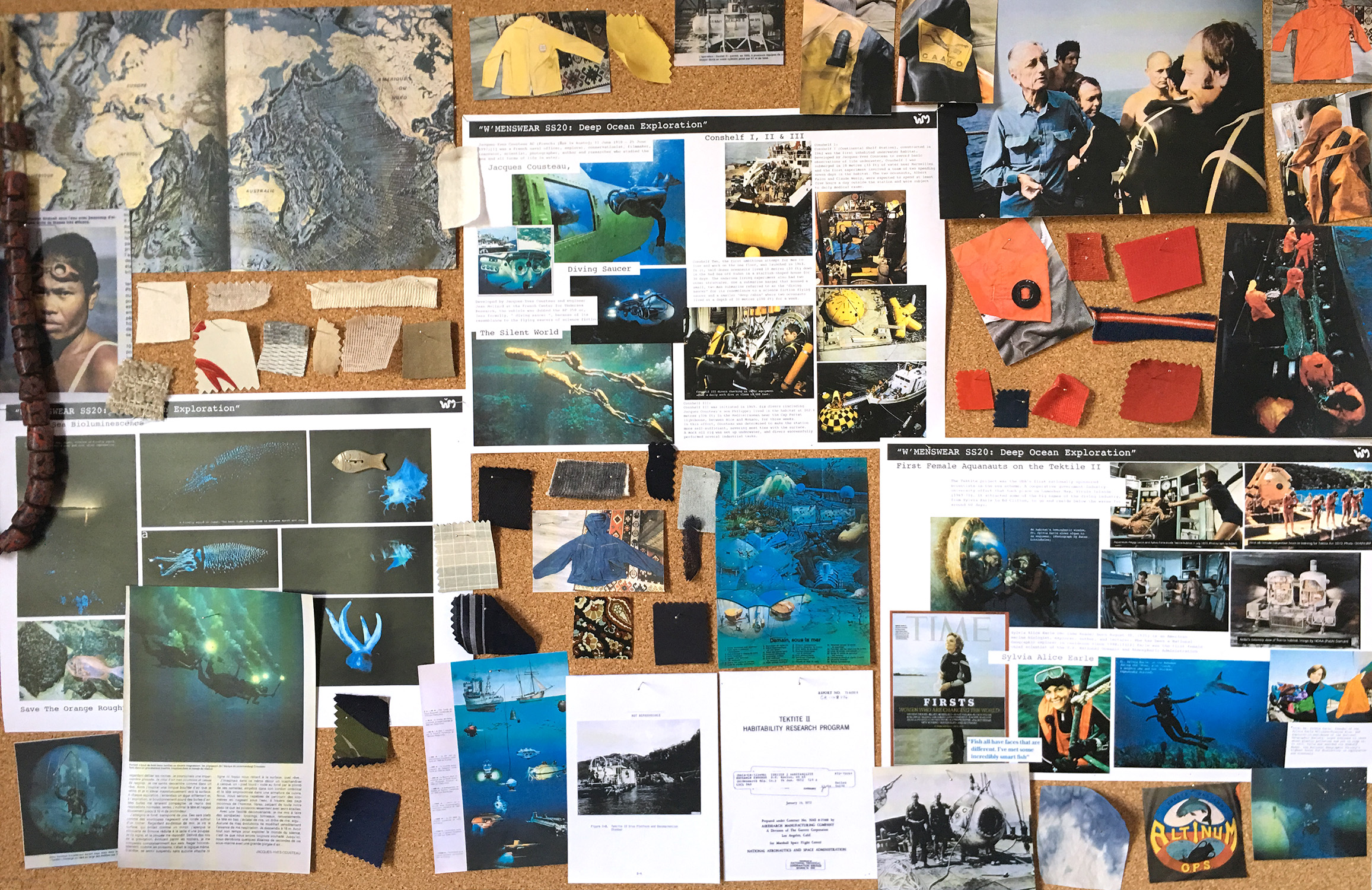
pic. 7 — A collage board for W’menswear Tektite IV Spring/Summer 2020 © Lauren Yates
pic. 8 — Sylvia Earle displays samples to aquanaut inside Tektite. The Tektite habitat was an underwater laboratory which was the home to divers during Tektite I and II programs, exploring the deep ocean. Tektite II ran by the first all-female team of aquanauts, led by Sylvia Earle.
pic. 9 — Tektite II ran by the first all-female team of aquanauts, led by Sylvia Earle.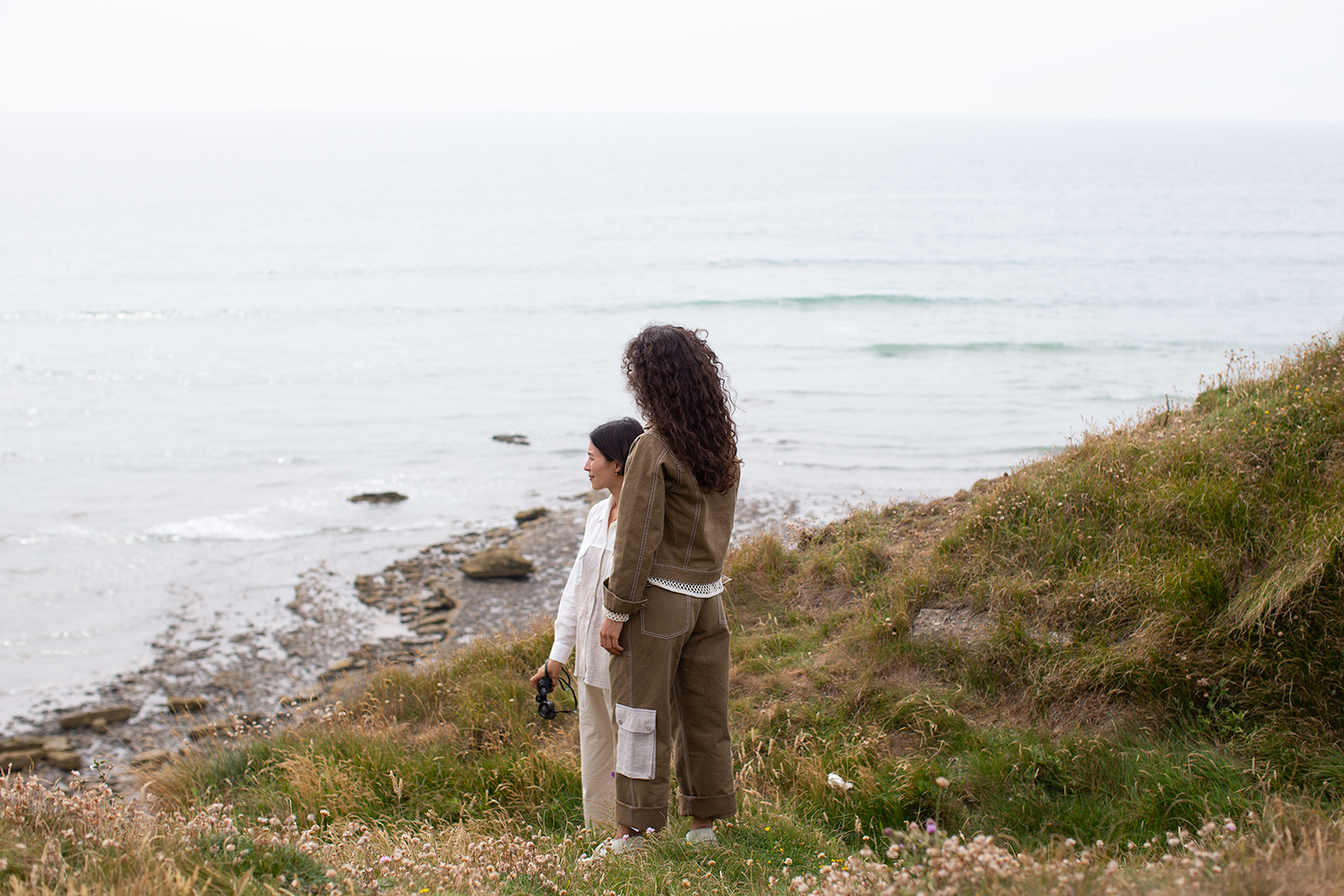
pic. 10 — W’menswear Tektite IV Spring/Summer 2020 lookbook © Lauren Yates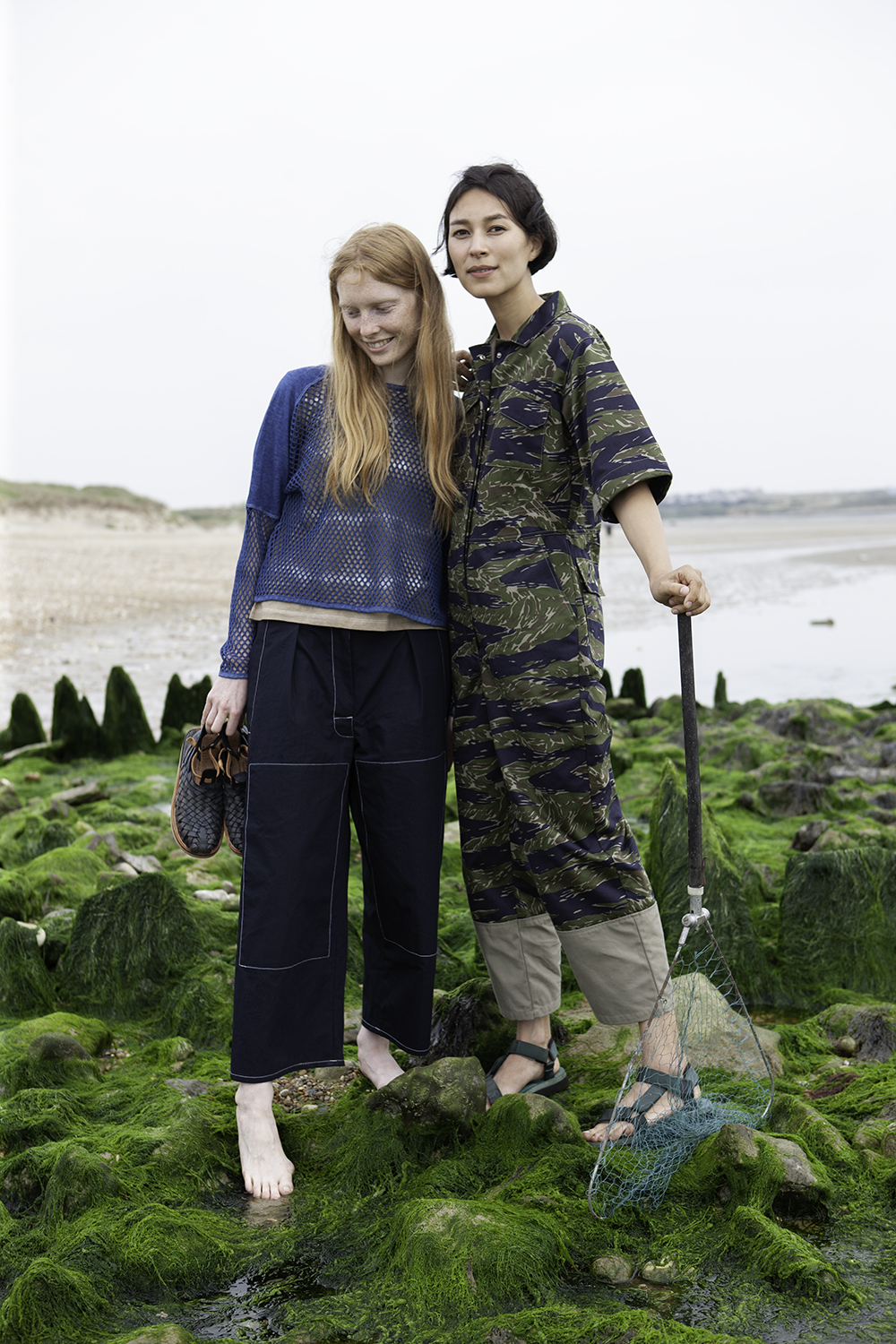
pic. 11 — W’menswear Tektite IV Spring/Summer 2020 lookbook © Lauren Yates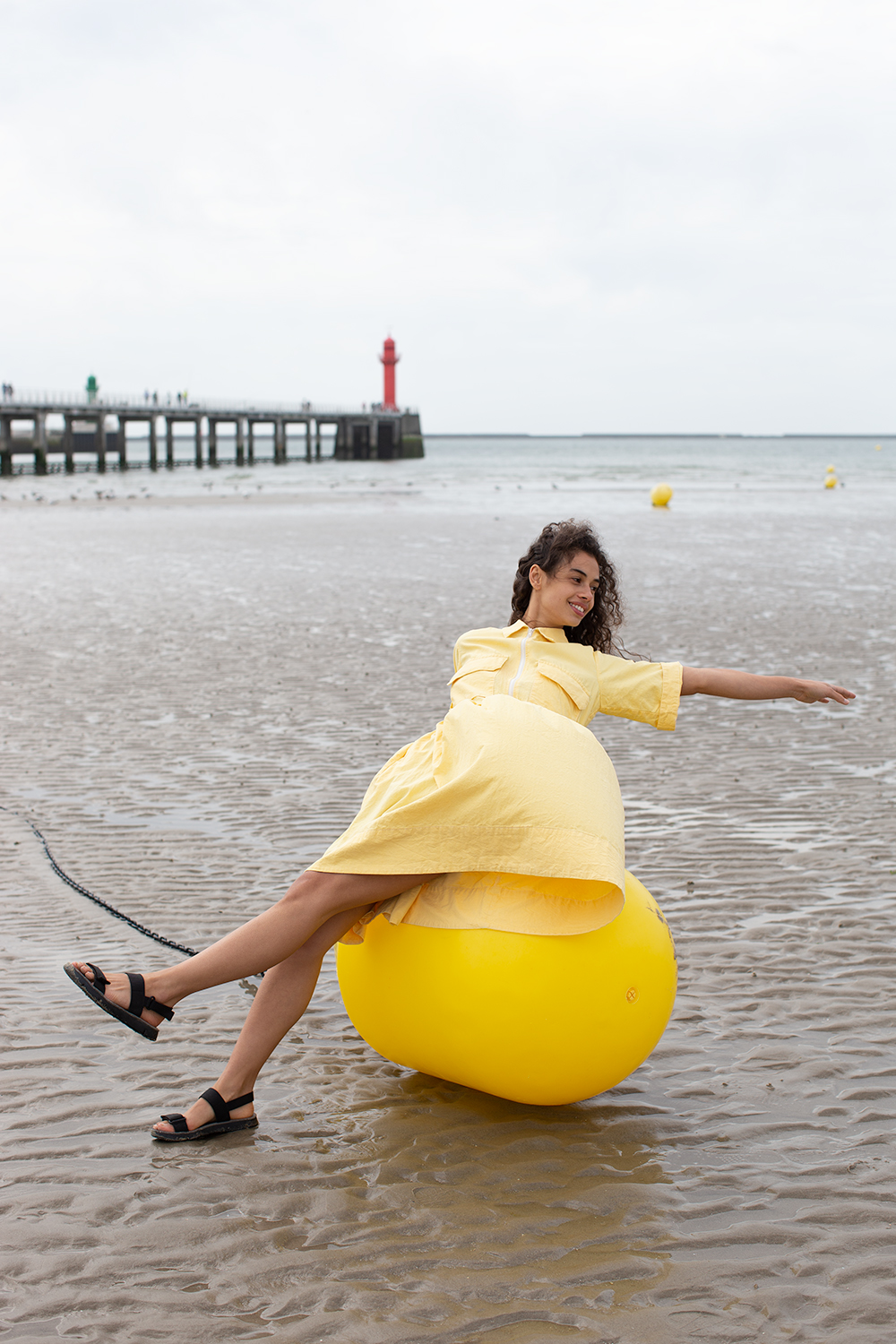
pic. 12 — W’menswear Tektite IV Spring/Summer 2020 lookbook © Lauren Yates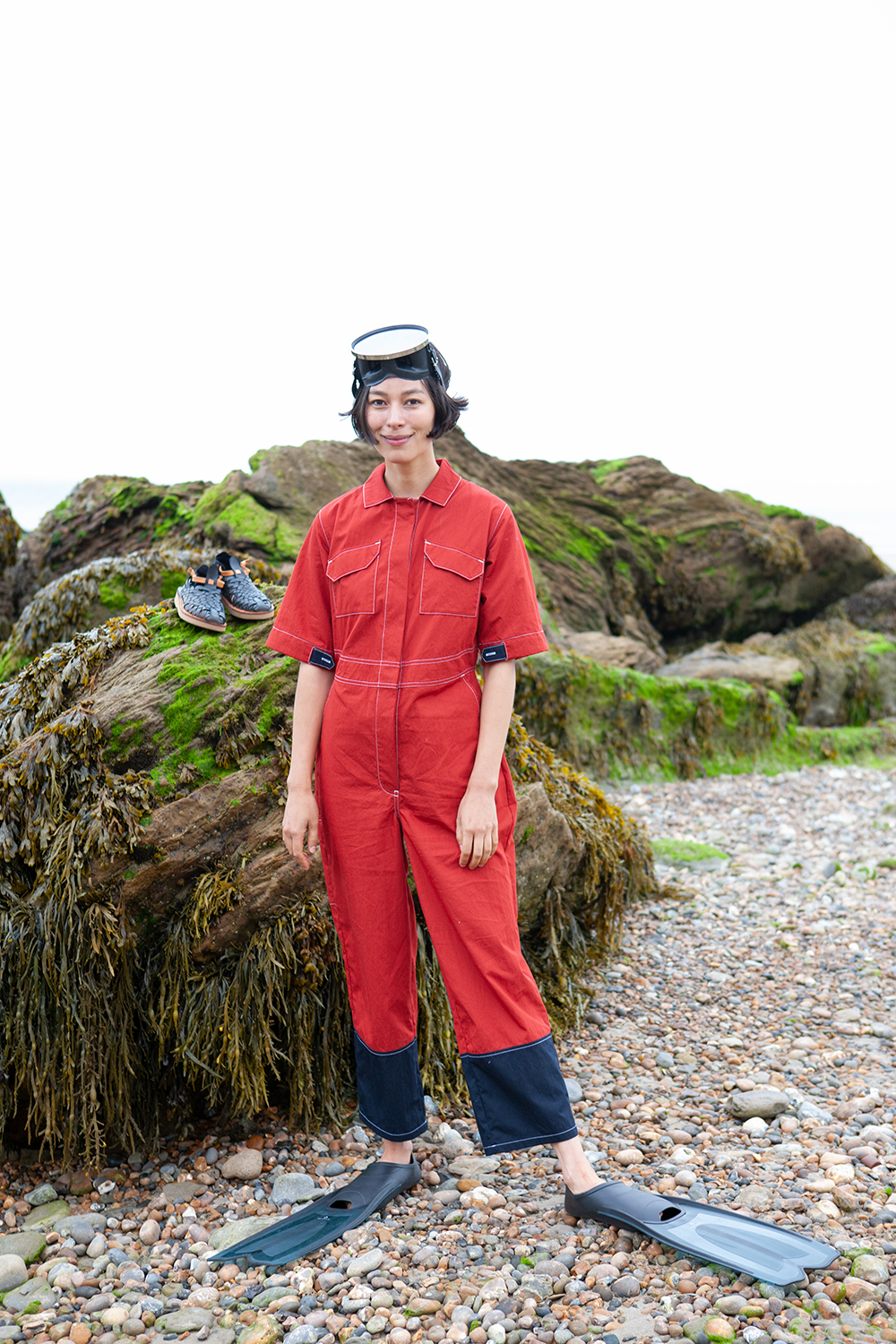
pic. 13 — W’menswear Tektite IV Spring/Summer 2020 lookbook © Lauren Yates
อุ้ง — แล้วของลอเรนล่ะ เป็นมายังไง
ลอเรน — สโลแกนของ W’menswear’s คือ ‘hard-hitting garments for hard-hitting women’ (เสื้อผ้าจริงจังสำหรับผู้หญิงจริงใจ) เราคิดว่าแบรนด์ของเราพูดถึงการหาความหมายและความเข้าใจการมีชีวิตอยู่ในปัจจุบัน เราพบว่าการมองกลับไปในประวัติศาสตร์และทำความเข้าใจว่าอะไรช่วยกรุยทางให้เรามาถึงทุกวันนี้ช่วยเราในการทำงานมากๆ ทุกๆ คอลเลกชั่น เราจะกลับไปดู ณ จุดๆ หนึ่งในประวัติศาสตร์ ที่อาจจะสะท้อนให้เห็นอะไรบางอย่างที่กำลังเกิดขึ้นตอนนี้ แล้วก็เหมือนโชน เราใช้การคอลลาจในการเชื่อมสิ่งที่เราศึกษาเข้าด้วยกัน ตัวอย่างเช่น งานคอลเลกชั่นสปริง 20 ที่เพิ่งออกมาชื่อ Tektite IV เรากลับไปดูช่วงหลังสงครามเย็น เราดูเทคโนโลยีการสงครามที่ถูกพัฒนาขึ้นในช่วงสงครามเย็น ว่ามันถูกนำไปใช้ในทางวิทยาศาสตร์อย่างไรหลังสิ้นสุดยุคสงครามเย็น มีเทคโนโลยีหนึ่งที่ใช้ในการทำแผนที่มหาสมุทรแบบที่ไม่เคยมีมาก่อน จนทำให้สามารถค้นพบจุดที่ลึกที่สุดของโลกหรือร่องลึกก้นสมุทรมาเรียน่า (the Mariana Trench) ด้วยการใช้เทคโนโลยีโซนาร์และเรือดำน้ำลึก เราค้นพบสิ่งใหม่ๆ เกี่ยวกับโลกของเรา และเราสามารถพัฒนาทางวิทยาศาสตร์ไปข้างหน้าได้ด้วยสิ่งที่โกลาหลและวุ่นวายอย่างสงคราม นี่เป็นวิธีที่เราใช้สำรวจระหว่างความเป็นระเบียบและความวุ่นวาย และการที่เราต้องอยู่บนเส้นคั่นบางๆ ระหว่างสองสิ่งนี้ ถ้าคุณเอนไปจนสุดทางไม่ว่าจะทางไหนก็ตาม มันก็อาจนำไปสู่การเสียสมดุลย์ได้ เช่น ถ้าเอนไปทางความเป็นระเบียบมากเกินไป คุณจะได้มาร์กซิสต์หรือระบอบเผด็จการแบบสตาลิน ซึ่งเป็นการกดขี่รูปแบบหนึ่งที่นำมาสู่สงครามเย็น ที่คนเป็นล้านๆ คนต้องเสียชีวิตลง มันเหมือนคุณหมุนเป็นวง เป็นสัญลักษณ์หยินหยาง หรือสัญลักษณ์โบราณที่เป็นมังกรกินหางตัวเอง เป็นวัฏจักรที่คุณเห็นในธรรมชาติ ในวิทยาศาสตร์ และในจักรวาล ตอนทีมเราศึกษาเรื่องนี้ เราได้ข้อมูลต่างๆ ที่เราพินไว้บนบอร์ดไม้คอร์กที่สตูดิโอ ไว้ดูเรื่องของวัสดุและสี แบบที่โชนเองก็คงทำเหมือนกัน จะได้เห็นภาพรวมของทุกอย่าง คุณจะเห็นแพทเทิร์น เห็นสีที่โผล่ขึ้นมาทุกครั้ง และเห็นเทคโนโลยีที่ใช้ สำหรับเรา กระบวนการสร้างงานมาจากการมองกลับเข้าไปในตัวเองและดูว่า เมื่อไหร่ที่จะเอาออกมาเป็นงาน
รูป 7 — บอร์ดไม้คอร์กคอลลาจสำหรับ W’menswear Tektite IV Spring/Summer 2020 © Lauren Yates
รูป 8 — ซิลเวียร์ เอิร์ล โชว์ตัวอย่างให้กับนักประดาน้ำภายใน Tektite ซึ่งเป็นห้องปฏิบัติการใต้น้ำ และบ้านของนักประดาน้ำในโครงการสำรวจก้นมหาสมุทรระหว่างโปรแกรม Tektite I และ Tektite II ในครั้งที่สองเป็นทีมนักประดาน้ำผู้หญิงทั้งหมดเป็นครั้งแรก นำทีมโดย ซิลเวียร์ เอิร์ล
รูป 9 — โครงการ Tektite II ประกอบด้วยนักประดาน้ำผู้หญิงทั้งหมด นำทีมโดย ซิลเวียร์ เอิร์ล
รูป 10 — ลุคบุ๊ค W’menswear Tektite IV Spring/Summer 2020 © Lauren Yates
รูป 11 — ลุคบุ๊ค W’menswear Tektite IV Spring/Summer 2020 © Lauren Yates
รูป 12 — ลุคบุ๊ค W’menswear Tektite IV Spring/Summer 2020 © Lauren Yates
รูป 13 — ลุคบุ๊ค W’menswear Tektite IV Spring/Summer 2020 © Lauren Yates
Shone — It’s difficult to explain the process. It comes intuitively when you look into resources.
Lauren — Talking about intuition, I am really interested in Jungian physiological theory that is ordering and chaos. Where chaos represents the feminine, and order represents the masculine. Every single one of us, whether it’s a tree or a person, a man or a woman. We have male-female energy inside us. That’s Yin and Yang. Intuition is chaos, a female energy, and modern culture is so power hungry that it is not listened to anymore. We see that in modern history especially around the Sixties where our culture shifted quite drastically, the focus went away from religion and morality to power, and power is a very masculine energy. While intuition, a feminine quality has been pushed under the rug. What’s interesting about art and why I’m always drawn back to art is it is a sensory experience; intuition, something you can feel and somehow try to figure out. You just know inside that the feminine spirit is being pushed as a kind of second class, subservient quality in modern society. I feel like it’s lacking, so I can totally relate to that.
โชน — มันยากเวลาให้อธิบายกระบวนการทำงาน มันเป็นไปเองตามสัญชาตญาณเวลาคุณเห็นของที่คุณมีอยู่ในมือ
ลอเรน — ถ้าพูดถึงสัญชาตญาณ เราสนใจทฤษฎีจิตวิเคราะห์ของจุง (Carl Jung) เกี่ยวกับความเป็นระเบียบและความโกลาหล ความโกลาหลเป็นตัวแทนของความเป็นหญิง ส่วนความเป็นระเบียบเป็นตัวแทนของความเป็นชาย เราทุกคน ไม่ว่าจะเป็นต้นไม้ เป็นคน เป็นผู้หญิงหรือผู้ชาย เรามีพลังความเป็นชาย-หญิงนี้อยู่ในตัว นี่คือหยินหยาง สัญชาตญาณคือความโกลาหล คือพลังความเป็นหญิงที่กระหายในอำนาจแต่ไม่ได้ถูกรับฟังในวัฒนธรรมสมัยใหม่ เราเห็นเลยว่าในประวัติศาสตร์สมัยใหม่ โดยเฉพาะอย่างยิ่งในช่วงหกศูนย์ซึ่งเป็นช่วงที่มีการเปลี่ยนแปลงทางวัฒนธรรมแบบหน้ามือเป็นหลังมือ จากศาสนาและศีลธรรมไปสู่พลังอำนาจ และพลังอำนาจนี้มีความเป็นชายสูงมาก ในขณะที่สัญชาตญาณซึ่งมีคุณสมบัติเป็นหญิงถูกผลักไปซุกไว้ใต้พรม สิ่งที่น่าสนใจเกี่ยวกับศิลปะและเหตุผลที่เราถูกดึงดูดกลับไปหาศิลปะ เป็นเพราะมันให้ประสบการณ์ทางอารมณ์ความรู้สึก เป็นสัญชาตญาณ สิ่งที่คุณรู้สึกถึงมันและพยายามขบคิดเกี่ยวกับมัน ลึกๆ ข้างในคุณรู้ว่าสปิริตความเป็นหญิงกำลังถูกกดลงไปเป็นคุณลักษณะชั้นสองในสังคมสมัยใหม่ เราคิดว่าสิ่งนี้กำลังขาดหายไป ดังนั้นเราเลยเข้าใจมันมากๆ
Ung — Yeah, it’s something I try to acknowledge everyday about suppression of feminine quality, this gentle power within all of us that is suppressed. It was one of my big drives for art as well. So I totally relate to this. I want to ask you a little bit more about this concept of Yin Yang and female male power. It must be related to your brand, right? Because the name of the brand is W’menswear. As a woman how did you become interested in workwear, menswear as inspiration? How does that address this balance you are trying to express in this world? How does it come to W’menswear?
Lauren — It’s really a good question. Like Shone, it was an intuitive process to start with. I started the brand in 2013, so it has been a bit of a journey since then. The narrative of the brand is almost like my own reflection of myself trying to find meaning in life. I was raised in a (white) privileged, tight-knit, top percentile of society. I acknowledge that and I’m here because of that. I went to a girl’s school in Australia and my family raised me to be a powerful, competitive career woman. We got the idea that women have to compete against each other, but inside I felt something wasn’t right. My narrative is a woman wearing men’s clothes because it’s a narrative that I grew up in. But when you look at how we communicate and how we depict our narrative, there’s a soft feminine spirit, because I tried to figure out where the balance is. So, when you see the look book it’s about really high-vibe feelings of cooperation. It’s about friendship, it’s about intuition, a really soft feminine spirit but we’re wearing men’s clothes. Accidentally it’s a political statement that I didn’t really intend for, but we don’t realize that everything we do is politicized.
pic. 14 — W’menswear Tektite IV Spring/Summer 2020 lookbook © Lauren Yates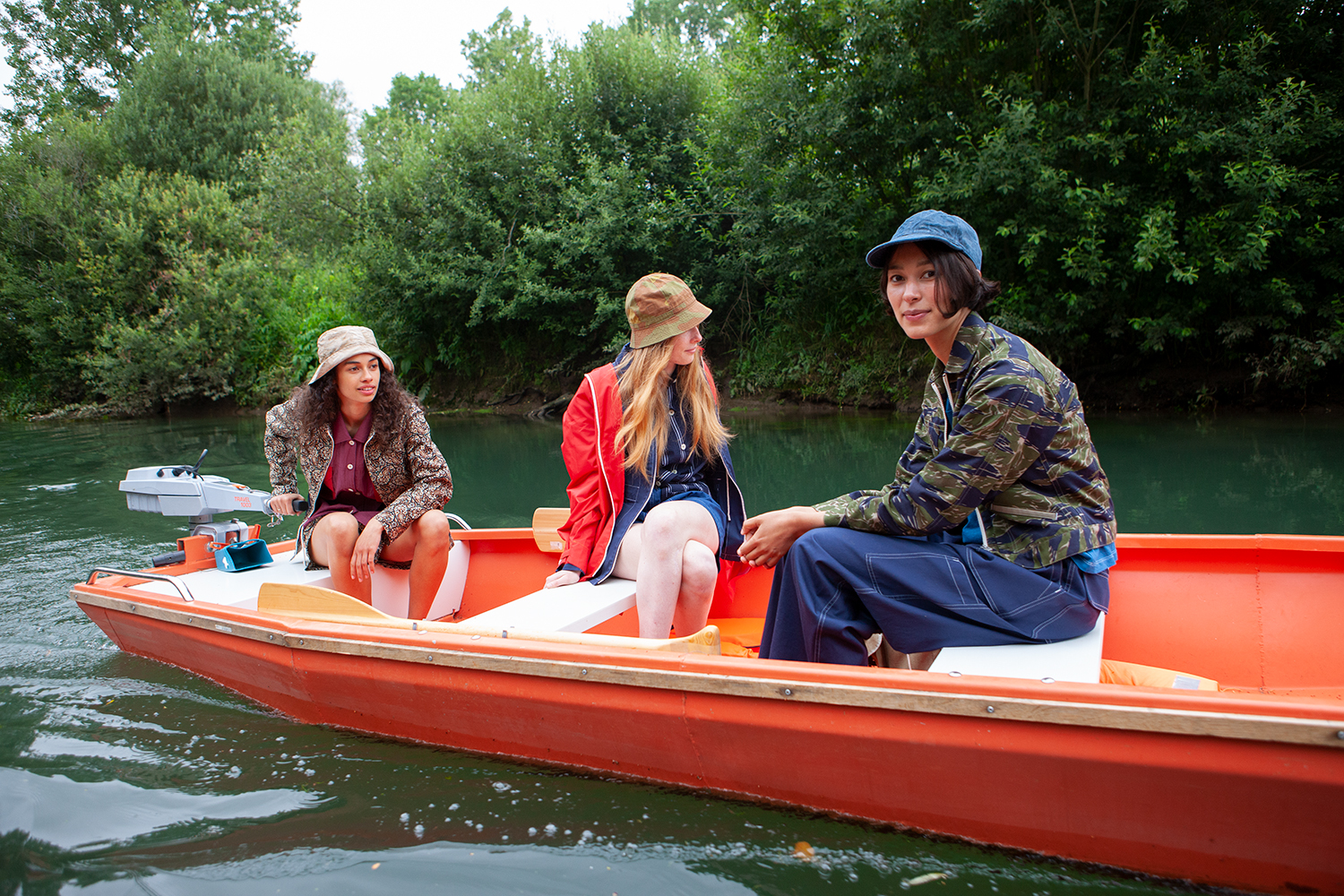
pic. 15 — W’menswear Tektite IV Spring/Summer 2020 lookbook © Lauren Yates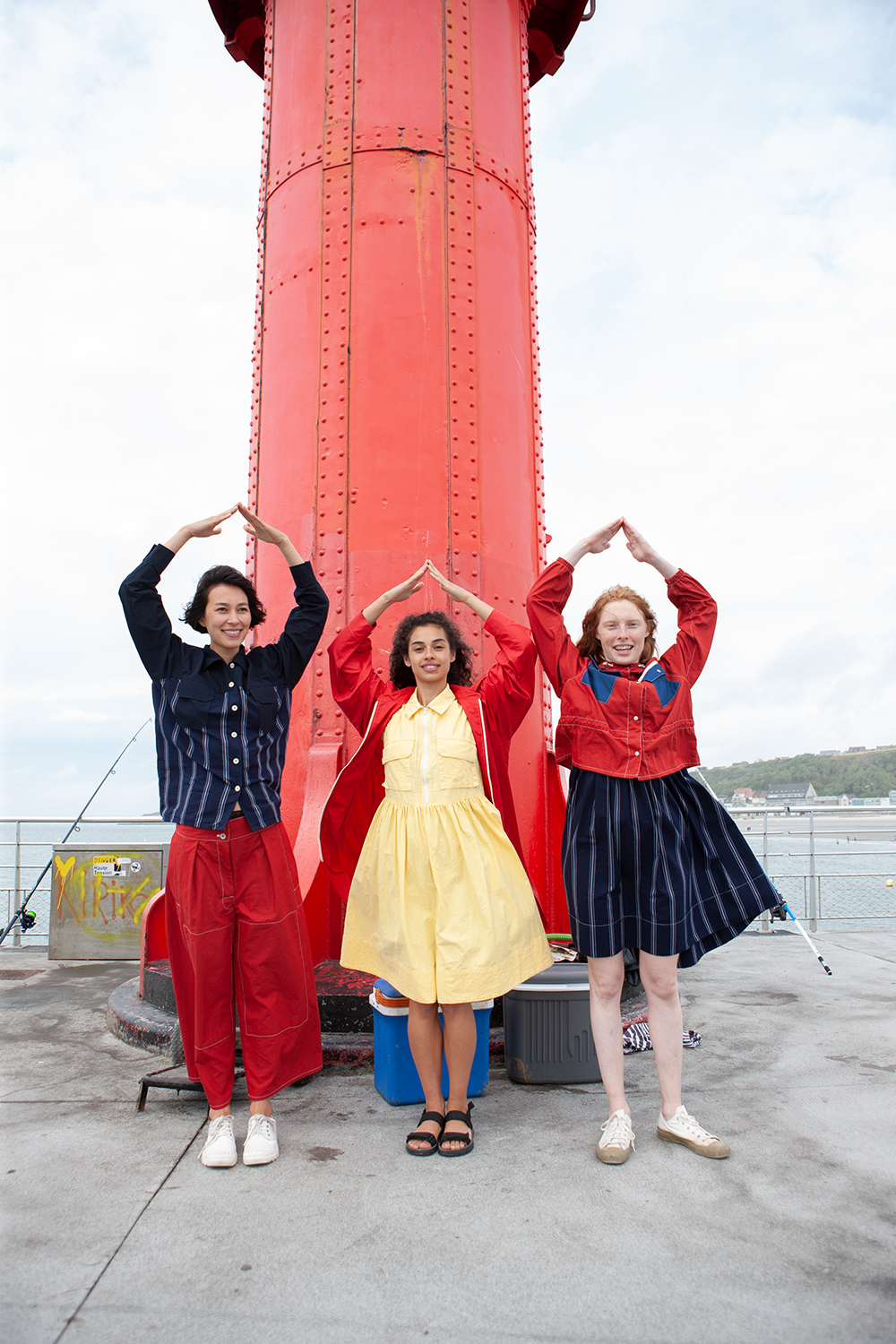
pic. 16 —W’menswear Tektite IV Spring/Summer 2020 lookbook © Lauren Yates
อุ้ง — ใช่เลย เรื่องการกดขี่คุณลักษณะความเป็นหญิงเป็นเรื่องที่เราพยายามทำให้เป็นที่ยอมรับอยู่ตอนนี้ พลังอ่อนโยนที่มีอยู่ตัวเราทุกคนนี้กำลังโดนกดไว้อยู่ เป็นหนึ่งในแรงขับใหญ่ในการทำงานศิลปะของเราเหมือนกัน เราก็เข้าใจเรื่องนี้มากๆ อยากถามต่ออีกนิดเรื่องแนวคิดของหยินหยาง และพลังแบบหญิงชาย มันเกี่ยวกับแบรนด์ของลอเรนใช่ไหม เพราะชื่อแบรนด์ก็เป็น W’menswear’s ในฐานะที่เป็นผู้หญิง ลอเรนสนใจและได้แรงบันดาลใจเสื้อผ้าสไตล์เวิร์กแวร์หรือเสื้อผ้าผู้ชายยังไง มันแสดงให้เห็นสมดุลย์ที่พยายามแสดงออกยังไง และมันกลายมาเป็นแบรนด์ W’menswear ได้ยังไง
ลอเรน — คำถามนี้ดีมากเลย ก็เหมือนโชนนะ ทุกอย่างเริ่มต้นและเป็นไปตามสัญชาตญาณ เราเริ่มทำแบรนด์ตอนปี 2556 ถ้าเป็นการเดินทาง เราก็มาไกลเหมือนกันจากตอนนั้น เรื่องเล่าของแบรนด์ของเราแทบจะเป็นเหมือนภาพสะท้อนของตัวเราเองในการหาความหมายของชีวิต เราโตมาแบบมีอภิสิทธิ์ของคนขาวในกลุ่มคนที่แทบจะมีแค่เปอร์เซ็นต์เดียวในสังคม และเรารับรู้และยอมรับว่าตัวเองมาถึงจุดนี้ได้ ก็เพราะอภิสิทธิ์ตรงนี้เหมือนกัน เราเรียนโรงเรียนหญิงล้วนตอนอยู่ออสเตรเลีย และที่บ้านก็เลี้ยงเราให้เป็นผู้หญิงแกร่งเรื่องการทำงาน เราถูกปลูกฝังความคิดที่ว่าผู้หญิงเราต้องแข่งกัน แต่ลึกๆ แล้วเราคิดว่ามีบางอย่างไม่ถูกต้อง เรื่องราวของแบรนด์เราคือผู้หญิงที่ใส่เสื้อผ้าของผู้ชาย เพราะนี่คือเรื่องเล่าในแบบที่เราโตขึ้นมา แต่ถ้าคุณดูวิธีที่เราสื่อสารและวิธีที่เราเลือกเล่าเรื่องราวของเรา จะเห็นพลังความเป็นหญิงที่เราพยายามดึงสมดุลกลับมาให้เห็น ดังนั้น ถ้าดูในลุคบุ๊คของเรา จะเห็นความรู้สึกเรื่องความร่วมมือกันนี้อยู่สูง เป็นเรื่องของมิตรภาพ ของสัญชาตญาณ สปิริตความเป็นหญิงที่อ่อนโยนทั้งๆ ที่เรากำลังสวมใส่เสื้อผ้าผู้ชาย และมันบังเอิญมากที่มันเองเป็นกลายไปเป็นสเตทเมนต์ของเราในแบบที่เราเองก็ไม่ได้ตั้งใจ เราไม่ได้คิดเลยว่าจริงๆ แล้วทุกอย่างที่เราทำเกี่ยวกับเรื่องนี้หมดเลย
รูป 14 — ลุคบุ๊ค W’menswear Tektite IV Spring/Summer 2020 © Lauren Yates
รูป 15 — ลุคบุ๊ค W’menswear Tektite IV Spring/Summer 2020 © Lauren Yates
รูป 16 — ลุคบุ๊ค W’menswear Tektite IV Spring/Summer 2020 © Lauren Yates
Ung — So what about Shone. How did you see making of women’s clothes delimited the idea of gender? Or making menswear or womenswear doesn’t exist anymore in your collection or in your vision? Does it matter to you?
Shone — Right now our collection is genderless. It’s women when I started my first collection but it sort of comes from my personal desire that I was missing out on the clothes for myself. That was when we started to land this kind of traded female-male clothing breaking down those ideas. It’s clothes for everyone. You should have fun with it. It doesn’t matter if you are boys or girls. You can wear anything and any colors. Personally when I go shopping I don’t only look into the mens department but also women. A lot of the time I find there are a lot more interesting details in womenswear and that’s when I felt lacking in the world. That’s what I try to do here now, making clothes fun again for everyone, high heels shoes for everyone whether boys or girls.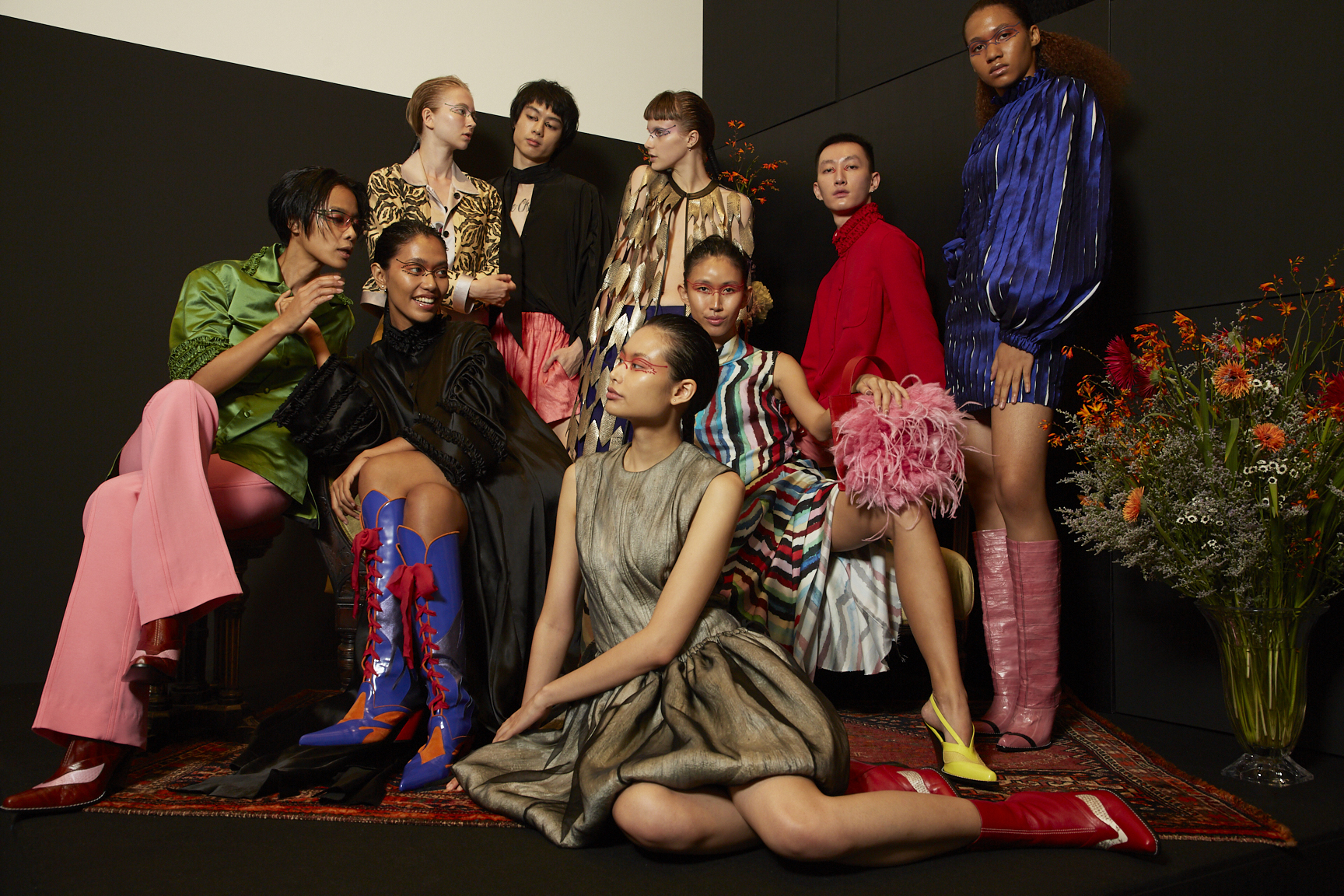
pic. 17 — The Brighter World collection 2019 © Shone Puipia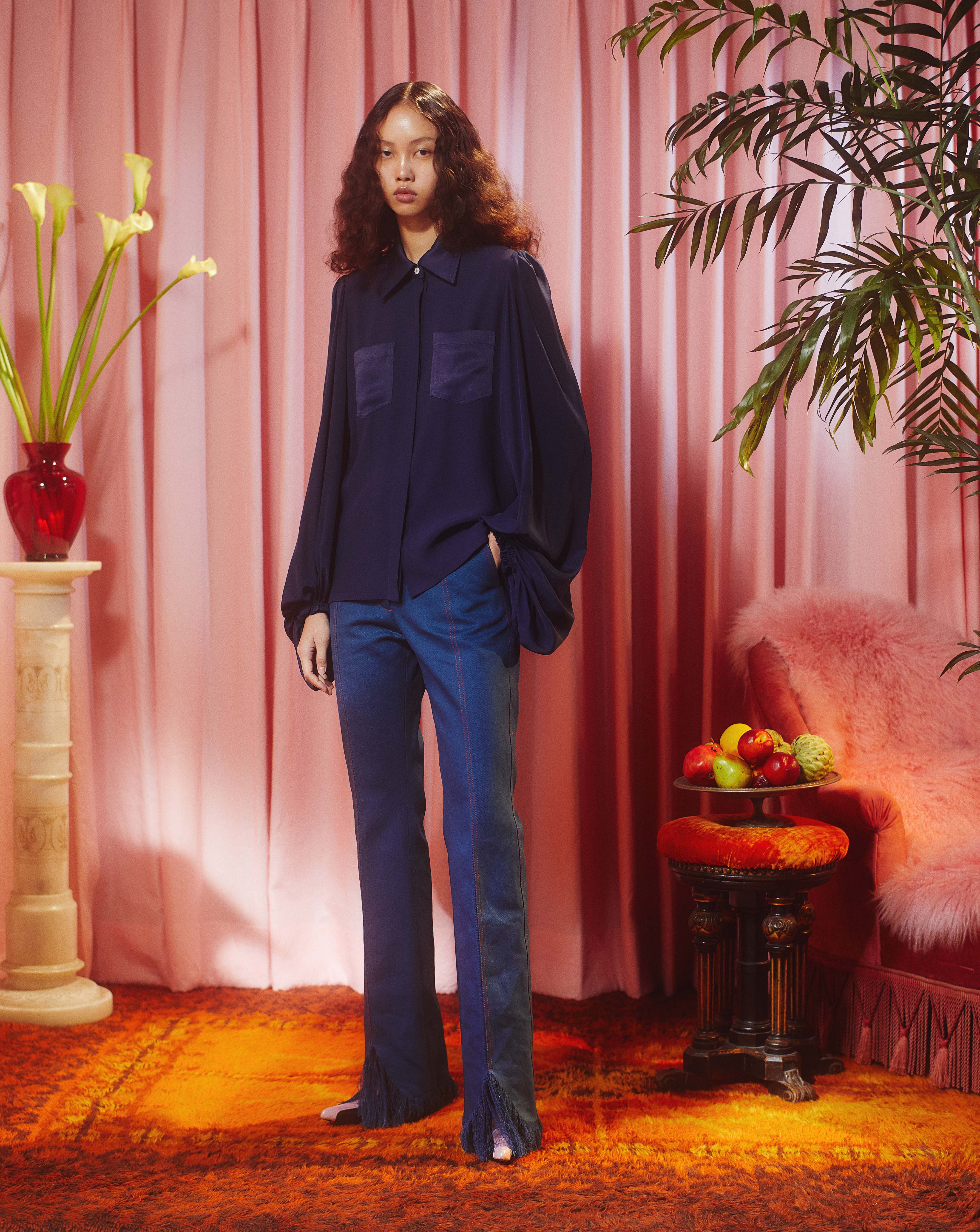
pic. 18 — Shone Puipia Cloudbusting Collection 2020 lookbook © Shone Puipia
pic. 19 — Shone Puipia Cloudbusting Collection 2020 lookbook © Shone Puipia
อุ้ง — แล้วโชนล่ะ การทำเสื้อผ้าผู้หญิงเป็นการลบข้อจำกัดทางความคิดเรื่องเพศมั้ย หรือแนวคิดการทำเสื้อผ้าผู้ชายหรือเสื้อผ้าผู้หญิงไม่อยู่ในการคอลเลกชั่นหรือในวิสัยทัศน์ของแบรนด์อยู่แล้ว หรือมันสำคัญกับโชนมั้ย?
โชน — ตอนนี้คอลเลกชั่นของเราไม่มีเพศ ตอนทำคอลเลกชั่นแรกทำเสื้อผ้าผู้หญิง แต่มันมาจากความต้องการส่วนตัวของเราที่รู้สึกว่ามันหายไปจากเสื้อผ้าสำหรับตัวเราเองด้วย นั่นคือตอนที่เราเริ่มไอเดียที่อยากจะเบรกดาวน์พื้นที่ของเสื้อผ้าแบบหญิง-ชาย ให้มันกลายเป็นเสื้อผ้าของทุกคน คุณควรสนุกกับเสื้อผ้าไม่ว่าคุณจะเป็นผู้ชายหรือผู้หญิง คุณจะใส่อะไรก็ได้ ใส่สีอะไรก็ได้ ส่วนตัวเวลาเราไปช้อปปิ้ง เราไม่ได้ดูแค่แผนกเสื้อผ้าผู้ชายแต่ดูแผนกเสื้อผ้าผู้หญิงด้วย หลายครั้งที่เห็นดีเทลเสื้อผ้าที่น่าสนใจในเสื้อผ้าผู้หญิงที่เรารู้สึกว่ามันขาดหายไปในโลกของแฟชั่นตอนนี้ นั้นเลยเป็นสิ่งที่เราพยายามทำ ทำเสื้อผ้าที่ทุกคนสนุกไปกับมันขึ้นมาอีกครั้ง ทำส้นสูงให้ทุกคนใส่ ไม่ว่าจะผู้ชายหรือผู้หญิง
รูป 17 — The Brighter World collection 2019 © Shone Puipia
รูป 18 — ลุคบุ๊ค Shone Puipia Cloudbusting Collection 2020 © Shone Puipia
รูป 19 — ลุคบุ๊ค Shone Puipia Cloudbusting Collection 2020 © Shone Puipia
Ung — When you moved back to Bangkok and started the collection based in Thailand, did the environment or the context of Bangkok change the way you work or influence you differently?
Lauren — I started my brand in Thailand. So, it started up using Thai materials and Thai labour. Without context, you have no product. So, the biggest part of the business is the Thai context, because that’s where we were making our products, and the end product is what the customer interacts with. What’s really interesting about Thailand is the revival of the cottage industries, which was a huge revival movement in the 90s and then later on again in 2005ish. I think it’s a really important narrative, a history. Thailand needs to continue to support these industries because it continues tradition and employs a lot of women who might not necessarily go into the workforce, because they need to take care of their children and they need to look after their communities. ‘Cottage industry’ is the way they can make income on their terms. We went to Roi Et where we made hand woven indigo and naturally dyed fabrics with the villagers who had been doing that for their whole life. Most of the weavers are getting old now and there are not many young people in the village who want to take over that tradition. I think any producers in Thailand or Thai designers really need to support ‘Thai made’ and traditional practices. That’s so important. It’s really important to continue our internal economy and to also show the world that Thai made is freaking awesome. This real racist kind of stigma that ‘made in Thailand’ means ‘shit’. At the trade shows, when people see my brand is from Thailand, there is some judgement. Then when they see a white face as the face of this brand, their opinion might change. That’s my white privilege that I use to educate other white people. I think the rest of the world needs to get over with this. The more we progress, the more cultures mix, the more globalized we become. The fashion industry to me is a super white industry, super racist, and a super old-school highbrow institution. I think Thai designers need to feel proud of made in Thailand, but need to be aware that the stakes are high and quality needs to be of the highest standard.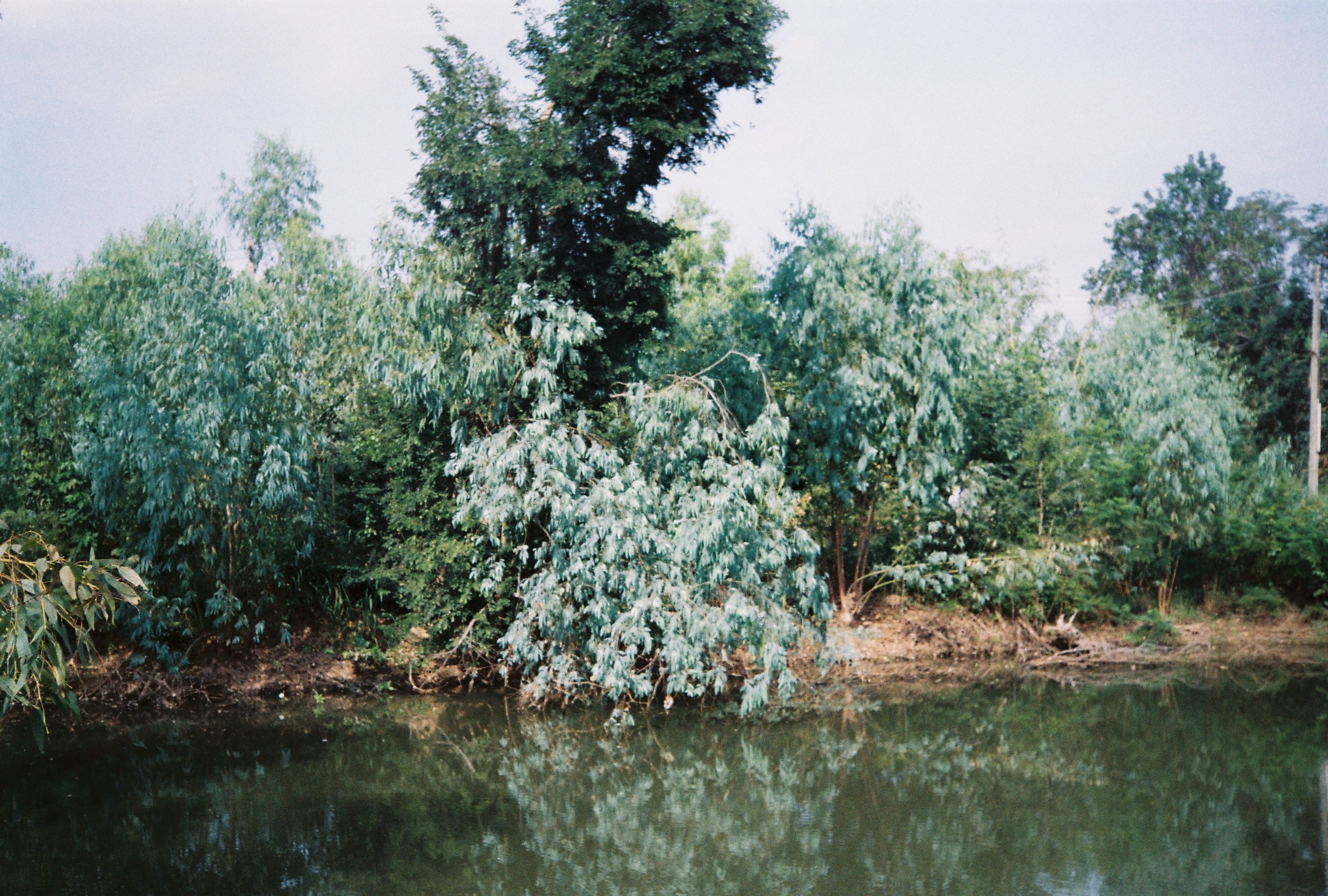
pic. 20 — A trip to Roi Et. © Lauren Yates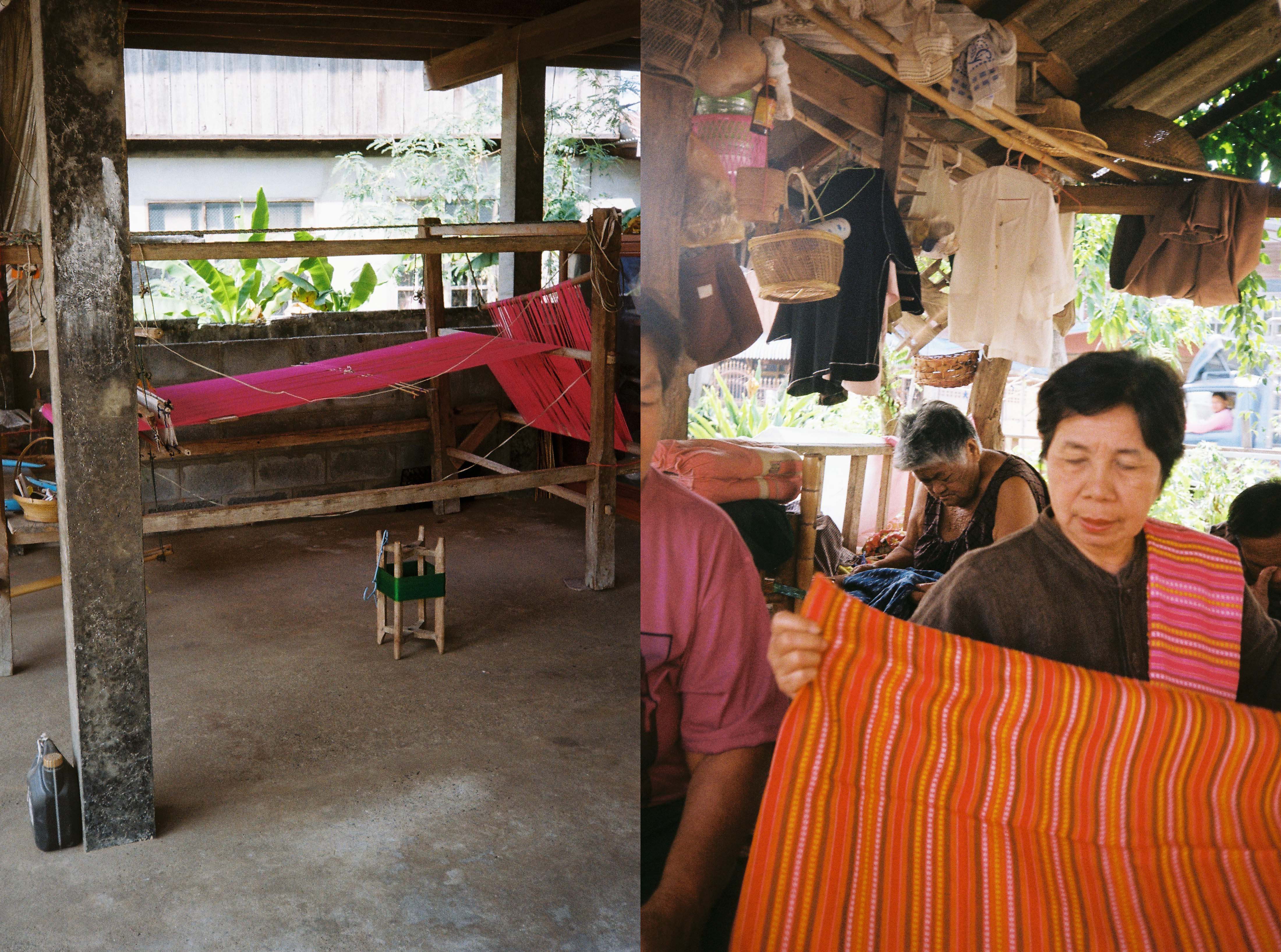
pic. 21 — Weaver community, Roi Et © Lauren Yates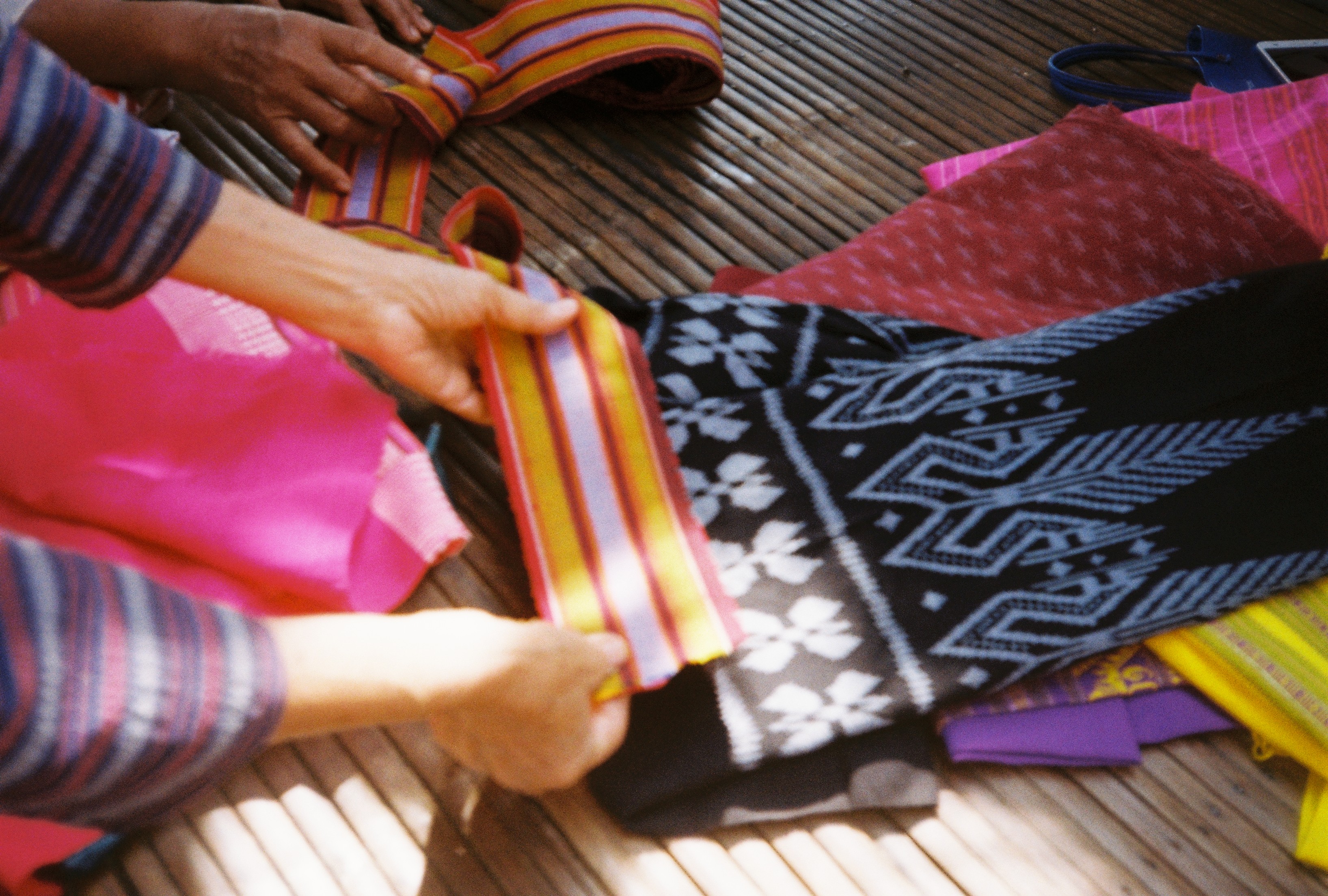
pic. 22 — Weaver community, Roi Et © Lauren Yates
อุ้ง — ตอนที่ย้ายกลับมากรุงเทพฯ และเริ่มทำคอลเลกชั่นที่เมืองไทย บริบทและสิ่งแวดล้อมที่กรุงเทพฯ เปลี่ยนวิธีที่คุณสองคนทำงานหรือมีอิทธิพลให้การทำงานเปลี่ยนไปมั้ย?
ลอเรน — เราเริ่มทำแบรนด์ที่เมืองไทย ก็เลยเริ่มจากการใช้วัสดุที่หาได้ในเมืองไทยและทำงานกับช่างไทย ถ้าไม่มีบริบท คุณก็ไม่มีสินค้า ส่วนที่ใหญ่ที่สุดของธุรกิจคือบริบทไทยนี่แหละเพราะนี่คือที่ที่เราผลิตงานของเรา และงานที่สำเร็จเป็นรูปเป็นร่างนี้เองคือสิ่งที่ลูกค้าจะได้มาสัมผัสมันในท้ายที่สุด สิ่งที่น่าสนใจมากเกี่ยวกับเมืองไทย คือการฟื้นคืนของอุตสาหกรรมในครัวเรือน ซึ่งกลับมาช่วงยุค 90 และช่วงประมาณปี 2548 เราคิดว่าเป็นเรื่องที่สำคัญมาก สำคัญในเชิงประวัติศาสตร์ด้วย เมืองไทยต้องสนับสนุนอุตสาหกรรมนี้ เพราะเป็นการสืบทอดประเพณีและช่วยให้เกิดการจ้างงานให้ผู้หญิงไม่จำเป็นต้องเข้าไปเป็นแรงงาน ให้เขายังสามารถอยู่ดูแลลูก อยู่ดูแลบ้านในหมู่บ้านได้ ‘อุตสาหกรรมในครัวเรือน’ เป็นวิธีหารายได้ที่ตรงกับเงื่อนไขในการใช้ชีวิตของพวกเขา ล่าสุดเราเพิ่งไปที่ร้อยเอ็ดกันมา ซึ่งเป็นที่ที่เราทำผ้าย้อมครามและผ้าย้อมสีธรรมชาติกับช่างทอในหมู่บ้านที่ทำผ้าทอเป็นอาชีพมาทั้งชีวิต ช่างทอส่วนใหญ่อายุมากแล้ว และไม่ค่อยมีคนหนุ่มสาวในหมู่บ้านที่อยากสืบทอดประเพณีการทอนี้ต่อ เราคิดว่าผู้ผลิตเสื้อผ้าในเมืองไทยหรือดีไซเนอร์ไทยต้องสนับสนุนการผลิตในไทยและสืบทอดประเพณีการทอนี้ต่อไป ไม่ว่าจะเพื่อตัวคุณเองหรือวัฒนธรรมของคุณเอง นี่สำคัญมากๆ ต้องสนับสนุนการสร้างเศรษฐกิจในท้องถิ่น และแสดงให้โลกเห็นว่างานที่ทำขึ้นในไทยเยี่ยมยอดแค่ไหน เรื่องเหยียดเชื้อชาติที่เคยตราหน้าสินค้าเมดอินไทยแลนด์ว่าเป็นขยะควรจะหมดไปได้แล้ว เวลาเราไปออกงานเทรดโชว์ เวลาใส่ชื่อประเทศไทยลงไปในป้ายประเทศว่าแบรนด์นี้มาจากประเทศไหน ภาพของแบรนด์เราจะถูกตัดสินไปแล้วล่วงหน้า จนเมื่อเขาเห็นว่าเราเป็นคนขาว ตอนนั้นเขาถึงอาจจะเปลี่ยนไปความคิด นั่นคืออภิสิทธิ์คนขาวที่เราพยายามจะบอกกับคนอื่นๆ เราคิดว่าโลกต้องเลิกคิดแบบนี้ได้แล้ว ยิ่งเราพัฒนาไปได้มากเท่าไหร่ วัฒนธรรมจะยิ่งผสมผสานกันมากขึ้น เป็นโลกาภิวัฒน์มากขึ้น อุตสาหกรรมแฟชั่นสำหรับเราแล้วเป็นอุตสาหกรรมคนขาวมากๆ เหยียดเชื้อชาติมากๆ มีความเป็นสถาบันแบบโอลด์สกูลมากๆ ด้วย เราคิดว่าดีไซเนอร์ไทยควรภูมิใจในงานที่เมดอินไทยแลนด์ ในขณะที่ก็ต้องตระหนักว่าการเดิมพันมันสูง และคุณภาพของผลงานจะต้องมีมาตราฐานสูงสุดด้วย
รูป 20 — ภาพจากทริปที่จังหวัดร้อยเอ็ด © Lauren Yates
รูป 21 — ชุมชนช่างทอจังหวัดร้อยเอ็ด © Lauren Yates
รูป 22 — ชุมชนช่างทอจังหวัดร้อยเอ็ด © Lauren Yates
Ung — I’m running the Fashion Revolution Thailand, you may have heard of this movement. I always host the event and discussion on the topics such as sustainability or ethical manufacturing or local weavers. Despite the growing numbers of consumers who join the conversations each year, to be honest the mainstream media or mainstream fashion magazine doesn’t really catch up with this conversation or the global conversation. Now you can see like British Vogue, Vogue America or Vogue Italia already talked about diversity and racism in their articles and really picked up the global issues like Black Lives Matter or diversity in general. So I think socio-political aspects of fashion weren’t really a big thing here just yet. But with young designers like you guys and my students at Chulalongkorn University, I see that a new generation is very ambitious about this subject and very political in everything they do.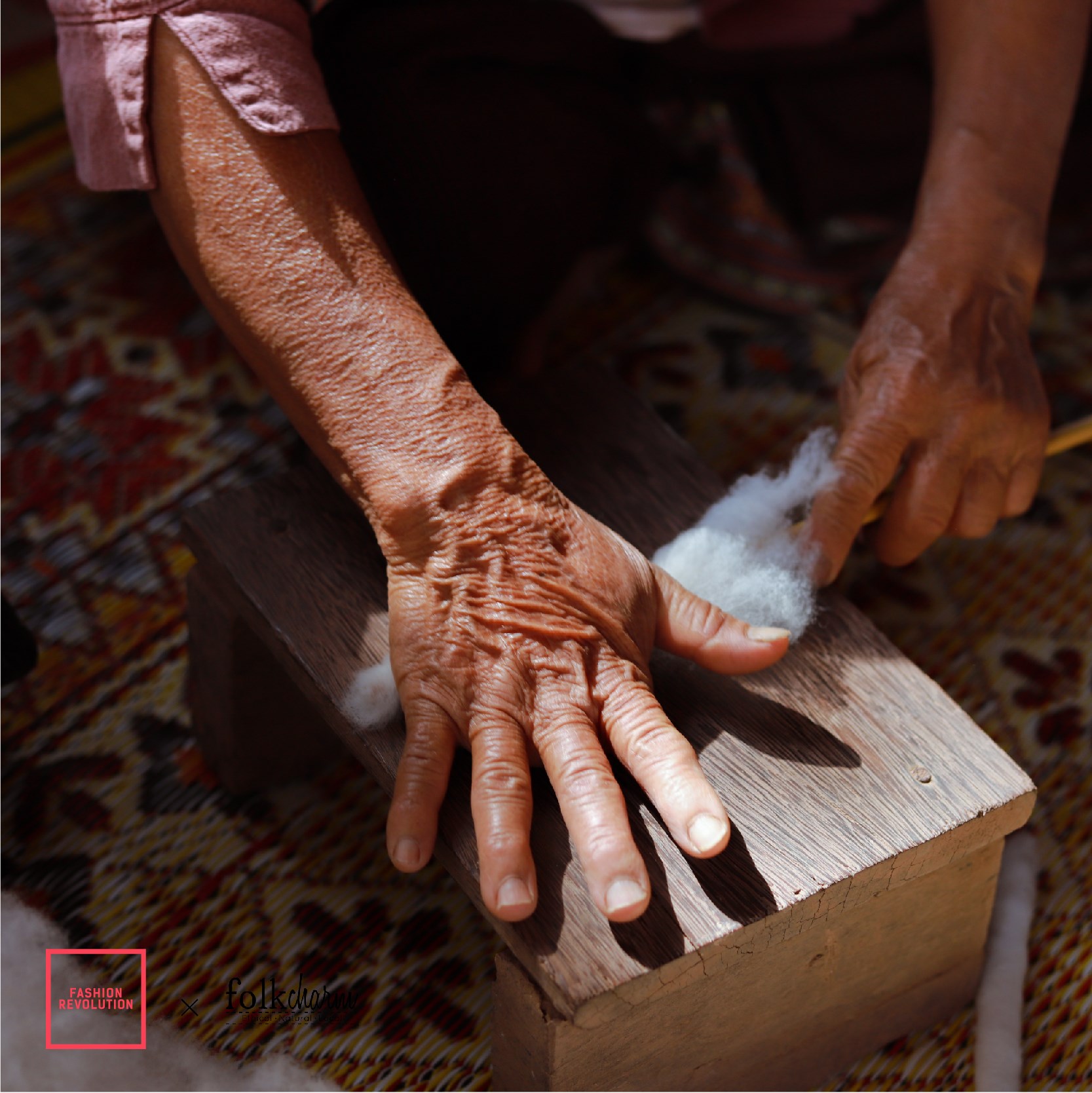
pic. 23 — Meeting the local weavers who grow and dye cotton, an activity ran by Fashion Revolution Thailand. In the picture is ‘Ken Fai’ the process of spinning cotton thread to use in fabric weaving © Fashion Revolution Thailand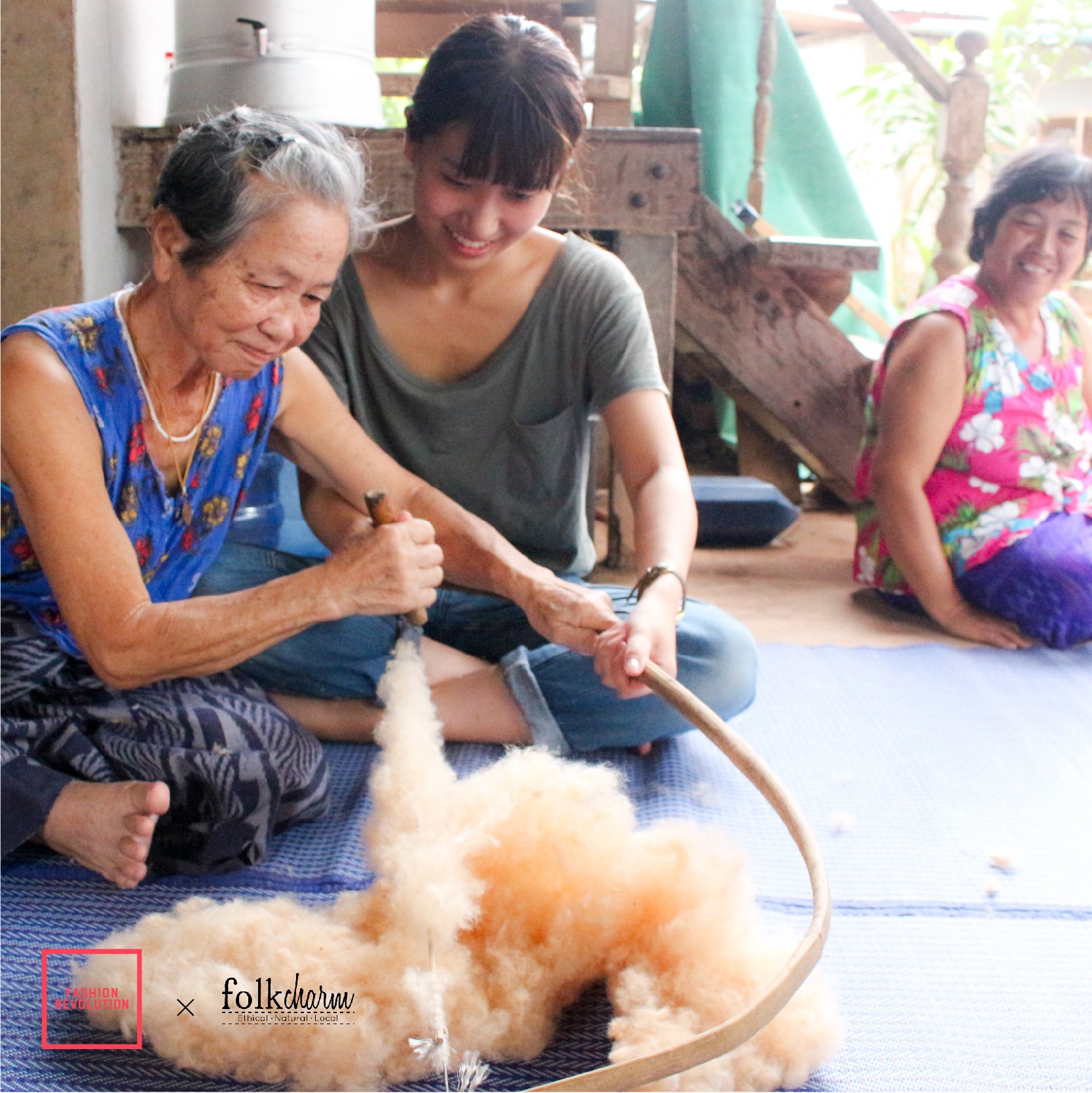
pic. 24 — Meeting the local weavers who grow and dye cotton, an activity ran by Fashion Revolution Thailand. In the picture is ‘Ken Fai’ the process of spinning cotton thread to use in fabric weaving © Fashion Revolution Thailand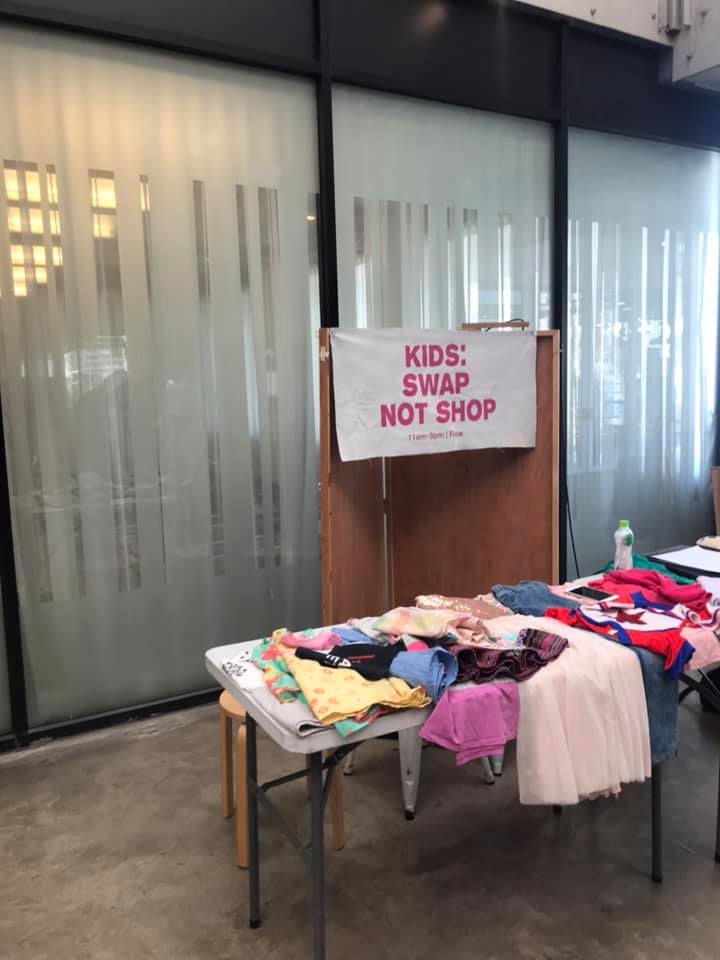
Pic. 25 — Clothing swap activity ran by Fashion Revolution Thailand © Fashion Revolution Thailand
Lauren — I have a point when you talked about the Fashion Revolution. I think in the Thai narrative right now we are following the west. I think it’s really important for the Thai narrative not to take, not to reflect, not to mirror what is politically and culturally happening in the west but to see what’s going on and make our own narrative here. I hate this idea that the west is right always, and the west knows the best – because culturally in Asia, we have such different values. You can’t apply one system to the whole world. That’s all.
อุ้ง — เราทำ Fashion Revolution Thailand ไม่แน่ใจว่าทั้งสองคนอาจจะเคยได้ยินมาบ้าง เราจัดอีเวนท์มีการคุยกันในหัวข้ออย่างความยั่งยืน หรือจรรยาบรรณในการผลิตหรือช่างทอท้องถิ่น ถึงจำนวนผู้บริโภคที่สนใจเรื่องเหล่านี้จะเพิ่มขึ้นทุกปี แต่ถ้าพูดกันแบบเปิดอก สื่อกระแสหลักหรือนิตยสารแฟชั่นกระแสหลักยังตามบทสนทนาในหัวข้อพวกนี้ หรือเรื่องที่โลกกำลังสนใจพวกนี้ไม่ทัน ตอนนี้คุณเริ่มเห็นโว้กอังกฤษ โว้กอเมริกา หรือโว้กอิตาลี พูดเรื่องความหลากหลายและการเหยียดเชื้อชาติในบทความของพวกเขา และหยิบประเด็นระดับโลกอย่างเรื่อง Black Lives Matter หรือความหลากหลายโดยทั่วไปบ้าง ดังนั้น เราคิดว่าแง่มุมทางสังคมการเมืองของแฟชั่นยังไม่ถือว่าเป็นเรื่องใหญ่ในตอนนี้ แต่เราเห็นดีไซเนอร์รุ่นใหม่ๆ อย่างโชนและลอเรน และนักศึกษาเราที่จุฬาฯ ว่าเป็นคนรุ่นใหม่ที่ใส่ใจในประเด็นพวกนี้ และมีจุดยืนเรื่องพวกนี้ในทุกอย่างที่พวกเขาทำ
รูป 23 — กิจกรรมพูดคุยทำความรู้จักช่างทอผ้าที่ปลูกและย้อมฝ้ายเอง เพื่อเข้าใจวิถีชีวิตพื้นถิ่น โดย Fashion Revolution Thailand การ ‘เข็นฝ้าย’ หรือปั่นฝ้ายจากปุยฝ้ายให้เป็นเส้นด้าย เพื่อนำมาทอผ้าของตนเอง © Fashion Revolution Thailand
รูป 24 — กิจกรรมพูดคุยทำความรู้จักช่างทอผ้าที่ปลูกและย้อมฝ้ายเอง เพื่อเข้าใจวิถีชีวิตพื้นถิ่น โดย Fashion Revolution Thailand การ ‘เข็นฝ้าย’ หรือปั่นฝ้ายจากปุยฝ้ายให้เป็นเส้นด้าย เพื่อนำมาทอผ้าของตนเอง © Fashion Revolution Thailand
รูป 25 — กิจกรรมแลกเปลี่ยนเสื้อผ้า โดย Fashion Revolution Thailand © Fashion Revolution Thailand
ลอเรน — เรามีประเด็นอยากเสริมตอนอุ้งพูดถึง Fashion Revolution เราคิดว่าเรื่องเล่าแบบไทยๆตอนนี้ เราก็ยังกำลังตามกระแสตะวันตกอยู่ เราคิดเรื่องเล่าแบบไทยไม่ควรจะตาม สะท้อน หรือแสดงให้เห็นสิ่งต่างๆ ที่กำลังเกิดขึ้นในโลกตะวันตกทั้งในเชิงวัฒนธรรมหรือการเมือง แต่ควรมองและเล่าเรื่องราวสิ่งที่กำลังเกิดขึ้นในเมืองไทยตอนนี้ เราเกลียดแนวคิดที่ว่าโลกตะวันตกถูกเสมอ ที่ตะวันตกถูกเสมอ เป็นเพราะในเอเชียเราให้คุณค่าเชิงวัฒนธรรมในแบบที่ต่างออกไปต่างหาก เราไม่สามารถประยุกต์ใช้ระบบเดียวกับโลกทั้งใบได้ ประมาณนี้ที่อยากเสริม
Ung — Yeah. I agree I feel like the whole thing that they were talking about is stemming from the west and the problem of the west as you know stemmed from colonisation like Indians and other asian countries and now they are crying for sustainability. I am always aware of that.
Shone — I see that the young Thai brand here we are trying to promote or win back to the craftsmanship of making clothes or winning back the quality. It doesn’t have to be anything mass produced, that’s what we try to do with the brand. That was also the reason we wanted to start up with everything made to order in order to keep offering that quality in our clothes. It’s also special to our clients as they can get the clothes that have been thought through and really made for them, using special techniques or handmade techniques. I feel like that’s a value that we should move towards in this time.
อุ้ง — ใช่ อันนี้เห็นด้วย เรารู้สึกว่าเรื่องทั้งหมดที่เขากำลังพูดกันอยู่ตอนนี้มีต้นทางมาจากตะวันตก และปัญหาของโลกตะวันตกอย่างที่คุณก็รู้กัน ก็มาจากการล่าอาณานิคม อย่างเรื่องอินเดียนแดงและประเทศในเอเชียอื่นๆ แล้วมาตอนนี้พวกเขากำลังเรียกร้องขอเรื่องความยั่งยืนเหรอ เราเห็นตรงจุดนี้ด้วยเหมือนกัน
โชน — เราเห็นแบรนด์ไทยใหม่ๆ กำลังโปรโมทหรือชนะใจผู้บริโภคด้วยฝีมือในการทำเสื้อผ้า หรือเรื่องคุณภาพการตัดเย็บ ที่ไม่จำเป็นต้องเป็นการผลิตในจำนวนมาก และเป็นสิ่งที่เรากำลังพยายามทำอยู่กับแบรนด์ของเรา และยังเป็นเหตุผลที่เราต้องการเริ่มทำทุกอย่างเป็นแบบสั่งตัดหรือสั่งผลิตอย่างเดียว เพื่อจะได้ยังสามารถคงคุณภาพให้กับลูกค้าผ่านเสื้อผ้าของเราได้ แถมสำหรับลูกค้าแล้ว เขายังได้เสื้อผ้าที่ผ่านการออกแบบตัดเย็บมาอย่างดีเพื่อพวกเขาโดยเฉพาะด้วยเทคนิคพิเศษหรือเทคนิคทำมือต่างๆ อีกด้วย เราคิดว่านั่นคือคุณค่าที่เราควรจะไปต่อในช่วงเวลานี้
Ung — Absolutely. Can I ask you all about your audiences? It seems like the market that dominates Thai’s fashion industry is fast fashion, mass-production and low-quality manufacturing. But what you guys work is very special and very rare among Thai designers. I think one of the main barriers for people to support this group of designers is maybe pricing but I believe they are a group of people who believe and want to support this idea of fashion and invest in this quality garments. Maybe you can explain to me more about each of your audience, and your clients. What kind of person was drawn or attracted by your works from the starting of the brand?
Lauren — I have very few customers in Thailand and I know that is because of my price point. The W’menswear customer is a socially conscious woman. The biggest market for our online store is in the US and then probably followed by Australia, Korea and then the UK. But on social media there are many Thai followers. It’s a dinosaur model of wholesale in fashion that drives my pricing up so much. My business is 75% wholesale which is crazy. That system has never adapted to the changing online market and now it’s a challenge how to readapt with Covid. Right now the trade shows will postpone to at least next year. No one wants to go to the showrooms, or to the fashion shows overseas because… no travel. So a lot of businesses are trying to figure out what the new game is, when the model of seasonal spring-summer / autumn-winter is really passé.
อุ้ง — แน่นอน ขอถามเรื่องลูกค้าของแบรนด์ทั้งสองคนได้มั้ย ตอนนี้เหมือนตลาดที่ครองอุตสาหกรรมแฟชั่นไทยอยู่คือตลาดฟาสต์แฟชั่น การผลิตแบบจำนวนมาก และการตัดเย็บที่ไม่มีคุณภาพนัก สิ่งที่โชนกับลอเรนทำอยู่ค่อนข้างพิเศษมาก และไม่ค่อยมีดีไซเนอร์ไทยทำกันเท่าไหร่ เราคิดว่ากำแพงหลักๆ เลยสำหรับคนที่อยากจะสนับสนุนดีไซเนอร์ในกลุ่มนี้น่าจะเป็นเรื่องของราคา แต่เราก็เชื่อว่ามีกลุ่มคนที่เชื่อและพร้อมสนับสนุนไอเดียแฟชั่นแบบนี้และยอมลงทุนในเสื้อผ้าที่มีคุณภาพ เลยอยากให้ช่วยอธิบายกลุ่มลูกค้าของแบรนด์หน่อย ว่าเป็นกลุ่มคนแบบไหนที่ถูกเสื้อผ้าของแบรนด์ดึงดูดมาเป็นลูกค้า ตั้งแต่ช่วงแรกๆ ที่เริ่มทำแบรนด์เลย
ลอเรน — เรามีลูกค้าในเมืองไทยไม่กี่เจ้า และเรารู้เลยว่าเป็นเพราะราคาของเรา ลูกค้าของ W’menswear เป็นกลุ่มที่มีจิตสำนึกทางสังคม ตลาดแฟชั่นออนไลน์ใหญ่ที่สุดตอนนี้คือที่สหรัฐฯ แล้วก็อาจจะเป็นออสเตรเลียที่รองลงมา ตามด้วยเกาหลีแล้วก็สหราชอาณาจักร แต่มีคนไทยตามแบรนด์ในโซเชี่ยลมีเดียเยอะอยู่นะ นี่เป็นเพราะโมเดลการขายส่งสินค้าแฟชั่นแบบเต่าล้านปีที่ทำให้ราคาเสื้อผ้าของเราต้องแพง 75 เปอร์เซ็นของธุรกิจเราคือการขายส่ง ซึ่งนั้นบ้ามาก ระบบขายส่งไม่เคยปรับตัวให้ทันกับตลาดเสื้อผ้าออนไลน์ที่เปลี่ยนแปลงอยู่เสมอเลย และจะยิ่งท้าทายไปกว่านี้อีกถ้าจะต้องปรับตามโควิด ตอนนี้งานเทรดโชว์ทั้งหมดเลื่อนไปเป็นอย่างน้อยคือปีหน้า ไม่มีใครอยากไปโชว์รูม อยากไปแฟชั่นโชว์ต่างประเทศ เพราะเดินทางไม่ได้ ธุรกิจจำนวนมากกำลังหาวิธีจัดการกับเกมการทำธุรกิจแบบใหม่ เมื่อมองว่าตอนนี้โมเดลการทำเสื้อผ้าเป็นซีซั่นแบบ สปริง/ซัมเมอร์ ออทัมน์/วินเทอร์ล้าสมัยไปแล้ว
Ung — What about you Shone? What kind of person was drawn or attracted by your works?
Shone — Because right now everything we do is by appointment and made to order. My clients are Thai. They are kind of the audience in the art world, the design world, individualistic dressers who like to have fun with their clothes. It is quite a niche market but there’s a growing number of people who like something different, special, and a little bit exclusive. When we started, it’s with friends, people we know and it’s solely through word of mouth. Then we also have Thai fashion university students who come by to see the space and talk to us. Although they might not buy it, it’s nice to see that it has an influence on young people. We rely a lot on physical meetings with the clients, to do fitting and to organize an event to show our clothes. But because of the Covid, in the beginning we were quite stressed out about what we were going to do. Now we have to build up more of the online market tools to expand audiences a bit but still without losing that personal touch to be honest. So for the new collection launch we are going to invite people for a private viewing.
อุ้ง — แล้วโชนล่ะ กลุ่มคนแบบไหนที่ถูกดึงดูดด้วยเสื้อผ้าของโชน
โชน — เพราะตอนนี้ทุกอย่างที่เราทำเป็นแบบต้องนัดเข้ามาและเป็นแบบสั่งตัดทั้งหมด ลูกค้าของเราก็เลยเป็นคนไทยเป็นหลัก เป็นกลุ่มคนจากแวดวงศิลปะ การออกแบบ และลูกค้าที่รักการแต่งตัวและสนุกกับการสวมใส่เสื้อผ้า ตลาดค่อนข้างเฉพาะกลุ่ม แต่จำนวนลูกค้าที่ชอบของที่ไม่เหมือนใคร มีความพิเศษ มีความเฉพาะ ก็เพิ่มขึ้น ตอนที่เราเริ่มทำแบรนด์ ก็ได้เพื่อน ได้คนที่เรารู้จักที่ช่วยบอกกันปากต่อปาก จากนั้นก็มีนักศึกษาด้านแฟชั่นในมหาวิทยาลัยที่เมืองไทยมีมาดูสเปซและมาคุยกับเราบ้าง แบรนด์ของเราขึ้นกับการเจอกันกับลูกค้าแบบเห็นหน้าเห็นตาค่อนข้างมาก มาลองเสื้อ และต้องจัดอีเวนท์แสดงเสื้อผ้าของเรา ทีนี้พอมีโควิด ตอนแรกๆ ก็เครียดเหมือนกันว่าจะต้องทำยังไง แต่ตอนนี้ก็ทำออนไลน์มากขึ้น ขยายฐานลูกค้าออกไปเพิ่มขึ้น แต่ก็ยังไม่ให้เสียความเป็นส่วนตัวกับลูกค้าของเรา คอลเลกชั่นใหม่ที่เรากำลังทำอยู่ก็เลยจะเป็นแบบเชิญคนมาดูแบบไพรเวท
Ung — Why do you choose to do things by appointment or private viewing in your studio instead of showing it at the fair or a fashion week in a traditional sense?
Shone — I want to break away from the past system of showing fashion. I wanted to create a space that really reflects the work and tell the story of each collection. I always decorate the space for each collection changing the artworks to go with it. It’s still like a small scale production and we don’t want to rush things. We don’t have a stock. We don’t have a huge effect directly from Covid. But we still have to figure out how to arrange the physical show to present our clothes.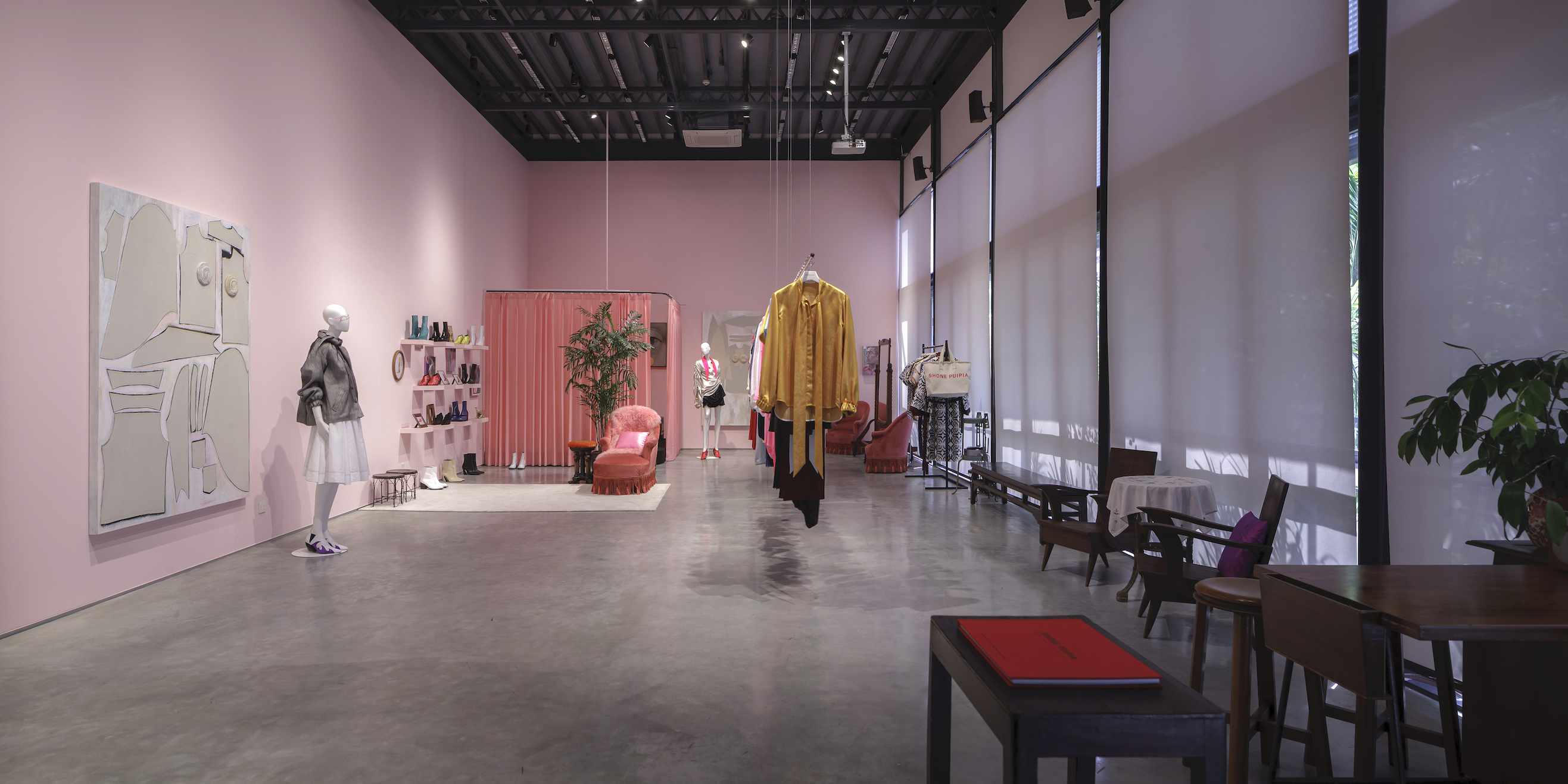

pic 26 — Cloudbusting collection 2020 exhibition view © Shone Puipia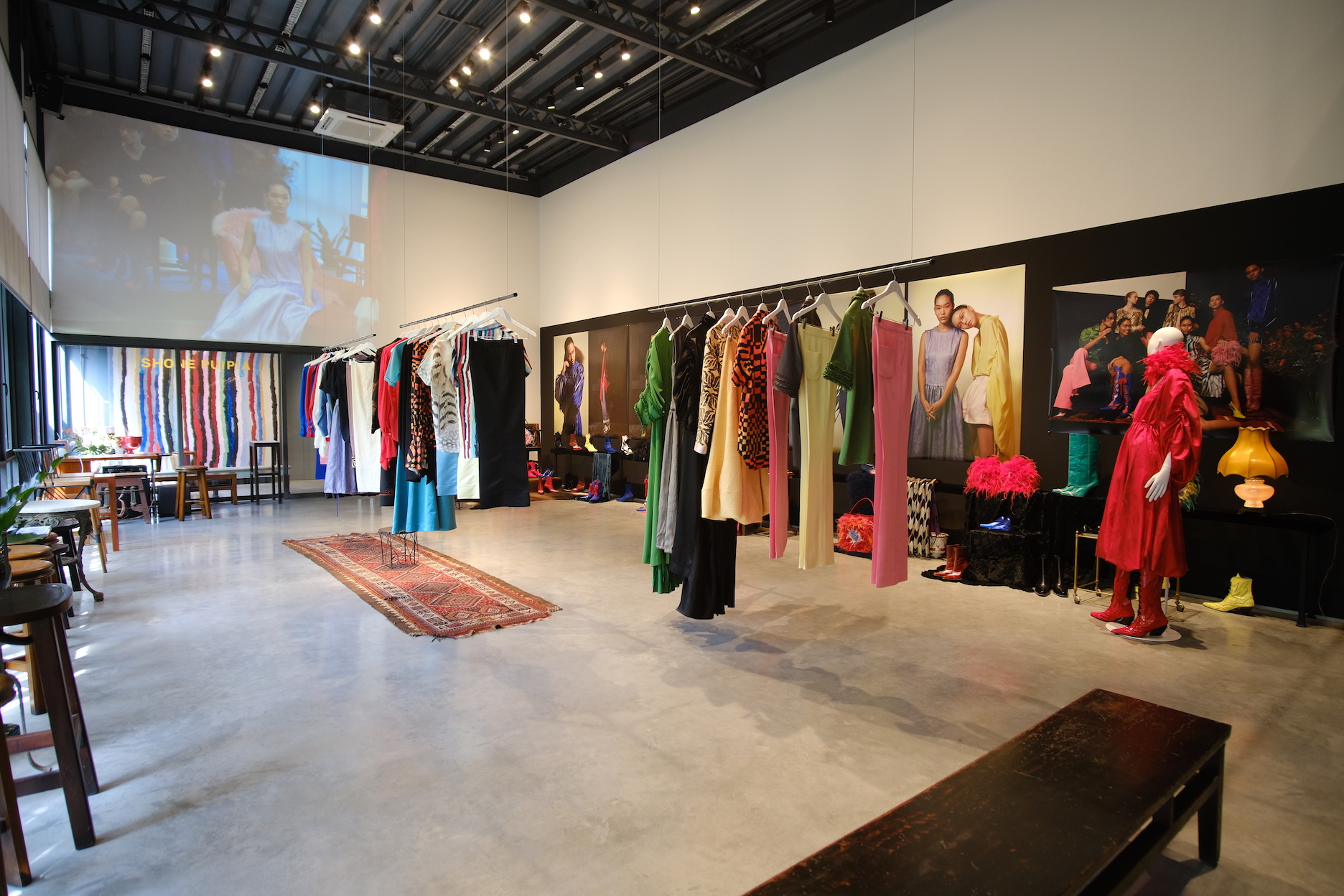
pic 27 — The Brighter World collection 2019 exhibition view © Shone Puipia
อุ้ง — ทำไมถึงเลือกทำแบรนด์แบบต้องทำนัดเข้ามาหรือเปิดให้ชมแบบไพรเวทที่สตูดิโอ แทนที่จะเลือกไปออกงานแฟร์หรือไปแฟชั่นวีคในแบบเดิมๆ?
โชน — เราอยากฉีกออกมาจากระบบการแสดงแฟชั่นที่ผ่านมาๆ เราอยากทำสเปซที่สะท้อนให้เห็นงานของเราและเล่าเรื่องราวในแต่ละคอลเลกชั่น เราตกแต่งสเปซใหม่ตามคอลเลกชั่นทุกครั้ง เปลี่ยนงานศิลปะต่างๆ ในสเปซให้ไปด้วยกัน เสื้อผ้าของเรายังเป็นการผลิตในสเกลที่ไม่ใหญ่มาก แล้วเราไม่อยากเร่งทำงานด้วย เราไม่มีสต็อคเสื้อผ้า เราไม่ได้รับผลกระทบโดยตรงมากจากโควิด แต่ก็ยังต้องคิดหาวิธีจัดการกับโชว์แสดงเสื้อผ้าที่กำลังจะเกิดขึ้น

รูป 26 — ภาพจากนิทรรศการ Cloudbusting collection 2020 © Shone Puipia
รูป 27 — ภาพจากนิทรรศการ The Brighter World collection 2019 © Shone Puipia
Ung — As we know the past fashion system, the whole fashion calendar was already dinosaur. And with Covid, it puts the pressure even more on the fashion industry to change. I just read the other day that Dries Van Noten published an open letter together with other designers from London and New York like Erdem and Proenza Schouler. Together they talked to the retailers, the wholesale retailers and the department stores, negotiating the change of fashion calendar and season, to not show the collection in a way that doesn’t reflect the real season or the real need of customers. How do you guys react to the seasonal calendar? Do you work on the season based collection?
Lauren — Yeah. We do follow a seasonal model and I try to wrap my head around how we can rework this mantle to build something better. Because there was so much economic fallout from Covid. The supply chain from factories all the way to retail outlets rely heavily on each other on this bigger framework of seasonal scale. What’s awful about this whole situation is that the retailers, mainly the big companies, have to close their doors. They just cancelled their orders from the factories and this sent so many factories to close down and put many people out of their jobs. The factory that I used in Vietnam that services my wholesale business is closing down in August. I think a lot of big businesses will close down and a lot of businesses in the US have gone bankrupt. But there are some businesses that just grew bigger from this. I want to be hopeful but I think this fast fashion model is not done yet. We are very lucky to have a really close relationship with all the wholesale retailers all over the world that are exceptional retailers, with unique spaces, that offer exceptional experience. All the mediocre retailers are going to drop like flies and people’s consumption habits are going to change. When I talk about this I’m talking about the western world because I’m more in touch with a customer base on that side. I’m not quite sure about what’s going to happen about consumer behaviour in Asia to be honest. In the west I think we will continue to work with these exceptional retailers who offer a very unique experience and do even cooler stuff, more unique stuff. A lot of our makers right now in Thailand who have a lot of time on their hands from Covid, started to ask us if we can make special things with them because they have lost a lot of their customers who ordered wholesale, and they are being able to cater that now.
อุ้ง — อย่างที่เรารู้กันว่าในระบบแฟชั่นที่ผ่านๆ มา ปฏิทินแฟชั่นทั้งหมดตอนนี้กลายเป็นเรื่องล้าสมัยไปแล้ว ยิ่งมีโควิด มันยิ่งกดดันให้อุตสาหกรรมต้องปรับตัว เราเพิ่งอ่านวันก่อนว่าดรีส ฟาน โนเทน เขียนจดหมายเปิดผนึกร่วมกับดีไซเนอร์คนอื่นๆ จากลอนดอนและนิวยอร์ก อย่างเออร์เด็ม (Erdem) และโพรเอนซ่า ชูลเลอร์ (Proenza Schouler) พวกเขาเขียนถึงกลุ่มค้าปลีก กลุ่มค้าส่ง และห้างสรรพสินค้า เพื่อต่อรองให้เกิดการปรับเปลี่ยนปฏิทินและซีซั่นของแฟชั่น เรียกร้องให้เลิกแสดงคอลเลกชั่นเสื้อผ้าที่ไม่ได้สะท้อนถึงฤดูกาลและทำขึ้นบนความต้องการของลูกค้าจริงๆ โชนกับลอเรนคิดยังไงกับปฏิทินซีซั่น ทั้งสองคนทำงานเป็นคอลเลกชั่นเบสบนซีซั่นหรือเปล่า
ลอเรน — ใช่ ของเราไปตามโมเดลซีซั่น และเราพยายามหาวิธีทำงานที่ก็ยังไปตามโมเดลนี้ แต่ทำในรูปแบบใหม่ๆ เพื่อสร้างงานที่ดีขึ้นออกมา เนื่องจากมีผลกระทบทางเศรษฐกิจเกิดขึ้นเยอะจากโควิด ห่วงโซ่อุปทานโรงงานผลิตต่างๆ ไล่ไปจนถึงร้านค้าปลีกยังต้องพึ่งพาอาศัยกันและกันในกรอบการทำงานของการทำตามซีซั่นในสเกลที่ใหญ่ขึ้น สิ่งที่แย่มากเกี่ยวกับสถานการณ์ทั้งหมดตอนนี้ คือร้านค้าปลีกซึ่งส่วนมากเป็นของบริษัทใหญ่ต้องปิดหน้าร้าน พวกเขายกเลิกออร์เดอร์จากโรงงาน ซึ่งส่งผลให้โรงงานหลายโรงงานต้องปิดตัวลง และทำให้คนงานจำนวนมากต้องตกงาน โรงงานที่เราสั่งผลิตในเวียดนามสำหรับงานขายส่งกำลังจะปิดตัวลงในเดือนสิงหาคมนี้ เราคิดว่าธุรกิจใหญ่ๆ จำนวนมากจะปิดตัวลง และมีธุรกิจจำนวนไม่น้อยเลยในสหรัฐฯ ตอนนี้ที่ล้มละลายไป แต่ก็ยังมีธุรกิจที่เติบโตขึ้นจากโควิดด้วยเหมือนกัน เราอยากมีความหวังนะ แต่เราคิดว่าฟาสต์แฟชั่นยังไม่ตายหรอก โชคดีที่เรายังมีความสัมพันธ์ที่ดีกับคู่ค้าส่งของเราทั่วโลก พวกเขาเป็นผู้ค้าที่มีพื้นที่ค้าปลีกที่พิเศษมาก มีพื้นที่เฉพาะที่ให้ประสบการณ์ที่ไม่เหมือนใครจริงๆ ร้านค้าปลีกแบบพื้นๆ ทั่วๆ ไปสิที่เราคิดว่าจะร่วงเอา และวิถีที่ผู้คนบริโภคจะเปลี่ยนไปแน่นอน เวลาเราพูดแบบนี้ เราหมายถึงในโลกตะวันตกนะ เพราะเราคลุกคลีกับผู้บริโภคทางนั้นมากกว่า จริงๆ เราไม่ค่อยแน่ใจว่าจะเกิดอะไรขึ้นกับพฤติกรรมของลูกค้าในเอเชีย ถ้าเป็นในโลกตะวันตก เราคิดว่าเราคงทำงานกับผู้ค้าปลีกที่เล่าให้ฟังไปนี้ นำเสนอประสบการณ์ที่ไม่เหมือนใครและทำสิ่งที่เจ๋งกว่าเดิม ทำของที่พิเศษที่มีเอกลักษณ์ออกมา ช่างที่เราทำงานด้วยในเมืองไทยตอนนี้มีเวลาว่างมากจากโควิด ก็เริ่มถามเราแล้วว่าอยากจะงานพิเศษๆ ด้วยกันไหม เพราะเขาเสียลูกค้าขายส่งไปเยอะ จนตอนนี้มีเวลามาลองทำงานด้วยกันกับเราแล้ว
Ung — I think in Asia the middle class market is growing a lot, so we will see fast fashion still. The fact is the pricing of fast fashion made the real price of clothing look expensive because it’s too cheap.
Lauren — It’s about market power. That pushes to produce things in high volume. The factory I was using in Vietnam is closing down because they are a small factory. The scene in Vietnam is all about servicing the world’s biggest brand. And the small factories that are continuously being bullied by the huge brands who like to squeeze down their prices for high volume. My factory wasn’t interested in that kind of customer, but they were forced to service them because that was the main kind of customer they could reach.
อุ้ง — เราคิดว่าตลาดชนชั้นกลางเอเชียเติบโตขึ้นมาก ดังนั้นเราจะยังคงเห็นงานฟาสต์แฟชั่นอยู่ จริงๆ ราคาเสื้อผ้าฟาสต์แฟชั่นทำให้ราคาเสื้อผ้าจริงๆ ดูแพงไปเลยก็เพราะว่ามันตั้งราคามาถูกเกินไปนี่แหละ
ลอเรน — มันเกี่ยวกับอำนาจของตลาดที่ผลักการผลิตสิ่งต่างๆ ให้ต้องเป็นการผลิตในจำนวนมาก โรงงานที่เราใช้ในเวียดนามกำลังจะปิดลงเพราะว่าพวกเขาเป็นโรงงานเล็กๆ คือในเวียดนาม สิ่งที่เป็นอยู่ตอนนี้คือโรงงานทั้งหมดผลิตสินค้ากับแบรนด์ใหญ่ๆ ของโลก และโรงงานเล็กๆ แบบที่เราใช้นี่ก็ถูกรังแกโดยแบรนด์ใหญ่ๆ พวกนี้ บีบราคาผลิตให้ต่ำลงด้วยการสั่งผลิตทีละมากๆ จริงๆ โรงงานที่เราร่วมงานด้วย ไม่สนใจลูกค้าแบบนี้ แต่พวกเขาถูกบังคับให้ต้องผลิตให้แบรนด์พวกนี้ เพราะเป็นลูกค้าหลักแบบเดียวที่จะให้ออร์เดอร์ป้อนโรงงานได้
Ung — That’s crazy. I hope that we turn to creativity rather than market power. For Shone, you work with a seasonless model, right?
Shone — Yes, we don’t work with the season. It was one main collection for each show. And like I said everything’s made to order. Customers can even look to the archive to get an old piece made again or using old fabric. I’m increasingly seeing my works as one whole wardrobe for all the collections. Each new collection builds on what we have done previously. What changes are my current interests or what I’m feeling at the moment of the design process. One maybe focused on solid colors and the next can be about clashing prints. But you will always see an identity that runs through every piece. I like this idea more than defining the collection by season to opening rooms for customization, adding more special details or special techniques. We also kept working with an in-house team.
I’m not in a rush of growing too big or too fast. I’m happy with them being able to sustain creativity and keeping uniqueness in the collection.
อุ้ง — นี่มันบ้าไปแล้ว เราหวังว่าเราทุกคนจะหันไปหาความคิดสร้างสรรค์มากกว่าอำนาจของตลาด แล้วโชนล่ะ โชนทำงานแบบไม่ตามซีซั่นใช่มั้ย?
โชน — ใช่ เราไม่ทำงานเป็นซีซั่น มีคอลเลกชั่นหลักคอลเลกชั่นเดียวในแต่ละโชว์ และเหมือนที่เราเล่าไปก่อนหน้านี้ ทุกอย่างเป็นงานสั่งตัดทั้งหมด ลูกค้าสามารถย้อนดูคอลเลกชั่นของเราเพื่อสั่งตัดงานก่อนๆ หรือใช้ผ้าจากงานก่อนๆ ก็ได้ ยิ่งทำ เรายิ่งมองงานตัวเองเป็นเหมือนตู้เสื้อผ้าใบใหญ่ๆ ข้างในมีทุกคอลเลกชั่น คอลเลกชั่นใหม่ๆ ที่เติมเข้าไปจะเสริมเติมจากคอลเลกชั่นที่เราเคยทำก่อนหน้านี้ สิ่งที่เปลี่ยนไปในแต่ละคอลเลกชั่น คือสิ่งที่เราสนใจตอนนั้นๆ หรือกระบวนการที่ใช้ในการออกแบบ บางคอลเลกชั่นอาจะเน้นไปที่การใช้สีสด ในขณะที่คอลเลกชั่นถัดมาอาจจะเล่นกับผ้าพิมพ์ลาย แต่คุณจะเห็นตัวตนของเราที่อยู่ในงานทุกชิ้น เราชอบคิดถึงเสื้อผ้าเราแบบนี้มากกว่านิยามมันเป็นซีซั่น เพราะมันเปิดกว่า ให้เราทำคอลเลกชั่นแบบคัสตอมได้ ใส่รายละเอียดพิเศษหรือเทคนิคพิเศษลงไป เรายังทำงานกับทีมอินเฮาส์ของเราเองด้วย คือเราไม่ได้รู้สึกว่าต้องรีบปั้นแบรนด์ให้โตหรือไปเร็วไป เรามีความสุขกับแบรนด์เราตอนนี้ ที่ยังหล่อเลี้ยงความคิดสร้างสรรค์ของเราไว้และยังคงเอกลักษณ์ของแบรนด์ในทุกคอลเลกชั่น
Ung — That’s great. Very rare mideset in this crazy world. Lauren, how do you see the context shaping and shifting the meaning of luxury? Compared to ten years ago, the meaning of luxury would be a lot different than today.
Lauren — I think you’re right. The meaning of luxury shifts every time there’s a cultural shift because people value different things according to their contexts. I have been talking to a lot of people in different fields on my podcast The Ponytail Show like a climate change activist from Australia to a photographer in New York. All the things that I picked up from all of them is that people value the outdoors. They didn’t realise how much they needed it and loved it until the Covid took it away from them. So I think space, and the outdoors, and having time to do those things, is like a new luxury in both eastern and western world. In Asia for sure air quality is a luxury, so these are all to do with nature.![]()
pic. 28 — The Ponytail Show © Lauren Yates
อุ้ง — นั่นเยี่ยมมาก เป็นวิธีคิดที่หายากในโลกบ้าๆ ตอนนี้ กลับมาถามลอเรนว่า บริบทตอนนี้ปรับเปลี่ยนความหมายของคำว่าหรูหราไปยังไงบ้าง ถ้าเทียบกับเมื่อสิบปีที่แล้ว ความหมายของความหรูหราน่าจะต่างไปจากตอนนี้มาก
ลอเรน — เราคิดว่าอุ้งพูดถูกนะ ความหมายของความหรูหราเปลี่ยนไปทุกครั้งที่มีการเปลี่ยนแปลงทางวัฒนธรรม เพราะคนให้ค่าของต่างกันไปตามบริบทของพวกเขา เราคุยกับคนทำงานในสาขาต่างๆ เยอะมากในพอดคาสต์ The Ponytail Show ของเรา ตั้งแต่นักรณรงค์เรื่องการเปลี่ยนแปลงของสภาพภูมิอากาศจากออสเตรเลียไปจนถึงช่างภาพจากนิวยอร์ก สิ่งที่เราได้จากทุกคนที่ได้พูดคุยด้วย คือผู้คนให้ค่าแก่โลกภายนอก พวกเขารู้แล้วว่าพวกเขาต้องการมันและรักมันแค่ไหนเมื่อโควิดพรากมันไป ดังนั้น เราคิดว่าพื้นที่และโลกภายนอกหรือการได้ออกไปทำอะไรข้างนอกจะเป็นความหรูหราใหม่ทั้งในโลกตะวันออกและโลกตะวันตก ในเอเชีย อากาศดีคือความหรูหราซึ่งแน่นอนว่าเกี่ยวกับธรรมชาติ![]()
รูป 28 — โลโก้จากรายการ The Ponytail Show © Lauren Yates
Lauren — I think luxury is going to have to find a new meaning and I think luxury is going to be focused on nature, and it has to be socially conscious. We see that now people finally have time to figure out their own bad habits and see what’s going on in the world. They are starting to see, for example, racism is a problem, equality of opportunity is important. Therefore I think unique, niche business is going to be a new luxury and people are going to push a lot more pressure on brands to be authentic. And when I say authentic I don’t mean let’s post ‘Black Lives Matter’ in a square because we tick that box. Now we don’t call our customer ‘consumers’ anymore, we call them ‘followers’. That’s the big shift. Our followers put us all under a microscope and they are asking really necessary questions. So, the new luxury is niche, it is beautiful, and it has integrity.
Shone — Yeah I totally agree. People are going to be more careful on what they are spending now. They’re going to value these traits much more such as craftsmanship, transparency, not getting a lot of things but getting quality things.
ลอเรน — เราคิดว่าความหรูหรากำลังต้องหานิยามใหม่ และเราคิดว่านิยามใหม่นี้จะเกี่ยวกับธรรมชาติและสำนึกทางสังคม เราเห็นแล้วว่าตอนนี้คนมีเวลาคิดถึงพฤติกรรมที่ไม่ดีของตัวเองและเห็นว่ากำลังเกิดอะไรขึ้นบ้างในโลก พวกเขาเริ่มเห็นเองแล้วว่าอะไรคือปัญหา ยกตัวอย่าง พวกเขาเห็นแล้วว่าการเหยียดเชื้อชาติเป็นปัญหา เห็นว่าความเท่าเทียมและโอกาสคือสิ่งสำคัญ ดังนั้นเราคิดว่าธุรกิจที่นิชมากๆ จะเป็นความหรูหราใหม่ และคนจะยิ่งกดดันให้แบรนด์เก่าๆ ต้องแสดงความจริงใจออกมามากขึ้น เวลาเราพูดถึงคำนี้ เราไม่ได้หมายถึงว่าทุกคนต้องโพสต์เรื่อง Black Lives Matter ในพื้นที่อินสตาแกรมเพราะนั่นคือสิ่งที่ต้องทำนะ ตอนนี้เราไม่ได้เรียกลูกค้าของเราว่าผู้บริโภคแล้ว พวกเขาคือผู้ติดตาม ซึ่งนั่นก็เป็นการเปลี่ยนแปลงครั้งใหญ่ ผู้ติดตามของเราใช้แว่นขยายมองเราทุกอณูและถามคำถามที่จำเป็นมากๆ กลับมาหาเราด้วย ดังนั้น นิชคือความหรูหราใหม่ คือความงามที่ซื่อตรงจริงใจ
โชน — ใช่ เราเห็นด้วยกับลอเรน คนระมัดระวังมากขึ้นว่าจะใช้จ่ายไปกับอะไร เขาจะให้ค่ากับเรื่องพวกนี้มากๆ อย่าง งานฝีมือ ความโปร่งใสตรวจสอบได้ คือไม่ได้ต้องมีเยอะแต่ต้องมีคุณภาพ
Ung — We talked a lot about socially conscious and consumer trends. How do you guys think about using fashion as a platform to address these social causes like gender diversity or Black Lives Matter to help put pressure on social transformation? The urgency of shift that we need in order to move into the new world. The 21th century where the dinosaurs are already not working but the power is still there. In fashion the power may not be intentional but it always reflects the zeitgeist of the society. It’s political in a way that people dress and express. How do you see creative and fashion designers could address this shift?
Lauren — This is a really controversial and complex question because it has really serious implications. As an artist I moved toward making works that make you ‘feel’ something, rather than being political, because I felt that art became way too political in the postmodern era. That’s the problem I had with my art school. To me what the postmodern university does to students is it burns everything down without constructively building something with them. The purpose of university is to break down what you think you know and challenge the worst part of yourself to build something constructively and rebuild yourself. I think what we need to do as a socially conscious brand, if you want to call yourself one, is take responsibility. I think those responsible in every single brand need to hold the hand of their followers to question the worst part of themselves. I don’t think a lot of brands are equipped to do that because they are not asking the right questions. It’s a very dangerous political area to go into and I think if we think that’s the responsibility of a brand, that it should teach culture, then we’ve got it wrong. Art and culture is more a reflection of what is happening and how people are questioning. I think it’s wrong to demand brands to voice a specific political agenda just because they are a brand. So there’s a big difference there. It often gets very confusing, because nowadays we are bombarded with so much information, people don’t often properly read things or watch full videos. The content presents us with short sound bites, the meaning gets lost and it’s very confusing for people. As a brand I think you need to be authentic about your voice, and you voice things that you feel very strongly about. That’s your agenda. But you need to do your research. You need to look into both sides of the story, you need to have a debate and open to conversation. I think there is a lot of rage in the world right now, and what we really need is a constructive conversation on both sides of the scale to move forward. It’s a very complicated issue.
อุ้ง — เราคุยกันเยอะมากเรื่องจิตสำนึกทางสังคมและเทรนด์ผู้บริโภค โชนและลอเรนเคยคิดจะใช้แฟชั่นเป็นแพลตฟอร์มเพื่อพูดถึงประเด็นทางสังคมอย่างความหลากหลายทางเพศ หรือ Black Lives Matter เพื่อกดดันให้เกิดความเปลี่ยนแปลงทางสังคมบ้างมั้ย เราต้องการการเปลี่ยนแปลงนี้อย่างเร่งด่วนเพื่อไปต่อในโลกใหม่ พวกไดโนเสาร์เต่าล้านปีไม่ทำงานแล้วในศตวรรษที่ 21 นี้ แต่อำนาจของพวกเขายังอยู่ ในโลกแฟชั่น อำนาจที่ครอบงำอยู่นี้อาจจะไม่ได้เป็นไปแบบตั้งใจ แต่มันก็สะท้อนให้เห็นความคิดร่วมสมัยของสังคมตอนนี้ การแต่งกายและการแสดงออกก็มีความเป็นการเมืองอยู่ในตัว ทั้งสองคนเห็นว่าความคิดสร้างสรรค์และดีไซเนอร์แฟชั่นจะเปิดประเด็นความเปลี่ยนแปลงนี้ยังไงได้บ้าง
ลอเรน — คำถามนี้ค่อนข้างเปิดให้ถกเถียงและซับซ้อนมาก เพราะเกี่ยวพันกับหลายๆ เรื่อง ในฐานะศิลปิน เราอินกับการทำงานที่ทำให้คุณรู้สึกอะไรบางอย่างมากกว่าแค่ทำเป็นเรื่องเชิงการเมือง เพราะเรารู้สึกว่าศิลปะในโลกยุคหลังสมัยใหม่เป็นเรื่องการเมืองมากเกินไป นั่นเป็นปัญหาที่เรามีตอนเรียนโรงเรียนศิลปะ สำหรับเราเอง สิ่งที่มหาวิทยาลัยยุคหลังสมัยใหม่ทำกับนักเรียน ก็คือการเผาทำลายทุกสิ่งทุกอย่างลงโดยไม่ได้สร้างอะไรขึ้นมาใหม่แบบสร้างสรรค์จากการทำลายนั้น จริงๆ จุดประสงค์ของมหาวิทยาลัยคือการทำลายทุกอย่างที่คุณคิดว่าคุณรู้ และท้าทายส่วนแย่ที่สุดของคุณออกมาเพื่อสร้างเป็นสิ่งใหม่อย่างสร้างสรรค์ สร้างตัวตนของคุณขึ้นมาใหม่ เราคิดว่าสิ่งที่เราต้องทำในฐานะแบรนด์ที่มีสำนึกทางสังคม ถ้าคุณอยากเรียกตัวเองอย่างนั้นและมีความรับผิดชอบในการทำสิ่งนั้น เราคิดว่าความรับผิดชอบในแบรนด์ทุกแบรนด์คือการจับมือกับผู้ติดตามของพวกเขาในการตั้งคำถามว่า สิ่งที่แย่สุดของแบรนด์คืออะไร เราไม่คิดว่ามีแบรนด์จำนวนมากเท่าไหร่ที่พร้อมจะทำสิ่งนี้ เพราะว่าพวกเขากำลังถามคำถามที่ไม่ถูกต้อง การเมืองเป็นพื้นที่อันตรายถ้าจะเข้าไป และเราคิดว่า ถ้าสมมุติเราคิดว่าความรับผิดชอบของแบรนด์คือแบรนด์ต้องให้ความรู้ในเชิงวัฒนธรรมด้วย ถ้างั้นนั่นก็ผิดแล้ว ศิลปะและวัฒนธรรมเป็นภาพสะท้อนของสิ่งที่กำลังเกิดขึ้น และวิธีที่ผู้คนตั้งคำถามกับสิ่งที่กำลังเกิดขึ้น เราคิดว่ามันไม่ถูกต้องที่เรียกร้องให้แบรนด์ต่างๆ มีเสียงหรือมีวาระทางการเมืองบางอย่างอย่างเฉพาะเจาะจง เพียงเพราะว่าเป็นแบรนด์ มีข้อแตกต่างที่ใหญ่มากอยู่ตรงนี้ หลายครั้งที่มันดูสับสน เพราะตอนนี้เราถูกถาโถมด้วยข้อมูลมากมาย คนไม่ค่อยอ่านอะไรละเอียดถี่ถ้วน หรือดูคลิปวิดีโอตั้งแต่ต้นจนจบ เนื้อหานำเสนอผ่านเสียงสั้นๆ ความหมายหายไปและนั่นทำให้คนสับสน ในฐานะแบรนด์ เราคิดว่าคุณต้องจริงใจกับเสียงของแบรนด์ของคุณ และพูดถึงสิ่งที่คุณรู้สึกกับมันจริงๆ นั่นต่างหากคือวาระของคุณ แต่คุณต้องศึกษาด้วยนะ ต้องฟังความจากทั้งสองด้าน ต้องมีการถกเถียงและเปิดกว้างพร้อมพูดคุย เราคิดว่ามีความโกรธแค้นมากมายในโลกตอนนี้ และเราต้องการการพูดคุยแบบสร้างสรรค์ทั้งสองฝั่งของตาชั่งเพื่อไปต่อ นี่เป็นประเด็นที่ซับซ้อนมาก
Ung — One example I saw from a British Vogue the July issue they put frontline workers on the front page of their magazines. They put London overground riders on the front cover instead of a model, HS worker and Waitrose cashier workers. It’s the first time for Vogue magazine to celebrate the frontline people who are not necessary from a highly regarded fashion industry. That’s one way the fashion industry starts to show the diversity, new value in their own term. I think this action is already radical in itself when Vogue Italia put the white cover like the blank page cover in the front. I think it sparks the questions for readers or consumers to be more in tune with culture and the shifting and social change.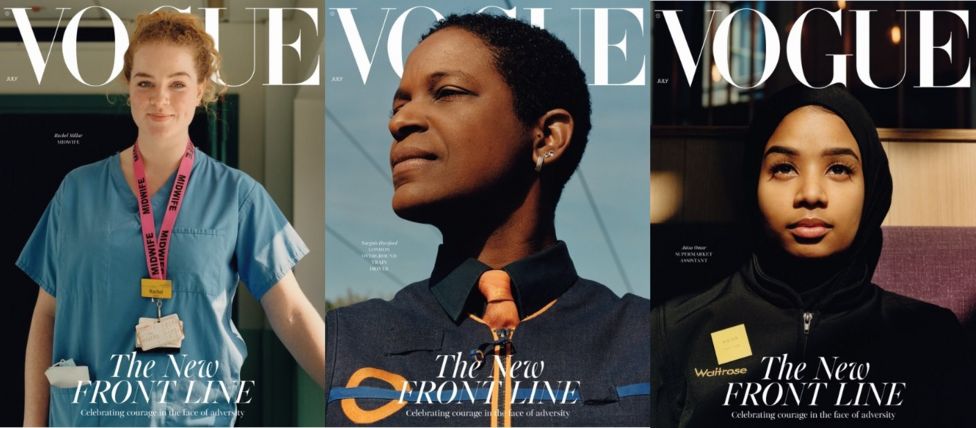
pic. 29 — Frontline workers on the front page of July British Vogue 2020. (A Day in The Life Of 3 Key Workers)
Shone — This week we were talking a lot about this with my colleague how we would communicate about this social issue. I feel that social media puts pressure a lot on us to say something about it. Through our work we are not actively being political but it’s through our belief in the beauty of the art and the idea of fluidity, being a minority person ourselves. It’s already saying something about it. That’s how we saw our place within this issue.
อุ้ง — ตัวอย่างหนึ่งที่เราได้เห็นจากโว้กอังกฤษเล่มเดือนกรกฎา คือเขาเอาแรงงานแนวหน้ามาขึ้นปกแมกกาซีน เอาคนขับรถไฟรางบนดินลอนดอน ผู้ผดุงครรภ์ในโรงพยาบาล และแคชเชียร์ของเวทโรสมาขึ้นปกแทนนางแบบ เป็นครั้งแรกที่โว้กแมกกาซีนสดุดีแรงงานในแนวหน้าที่ไม่ได้มาจากอุตสาหกรรมแฟชั่นที่มักได้รับความเคารพ นี่คือวิธีหนึ่งที่อุตสาหกรรมแฟชั่นเริ่มจะแสดงความหลากหลาย แสดงคุณค่าแบบใหม่ในเงื่อนไขของเขา เราคิดว่าการกระทำนี้ค่อนข้างสุดโต่งในตัวของมันเองเมื่อโว้กอิตาลีทำหน้าปกเป็นปกขาวเปล่าๆ เราคิดว่ามันจุดประกายคำถามกลับไปยังคนอ่านหรือผู้บริโภคให้ไปกับทำนองของวัฒนธรรมและการเปลี่ยนแปลงทางสังคม
รูป 29 — แรงงานแนวหน้าบนปกนิตยสารโว้กอังกฤษ ฉบับเดือนกรกฎาคม 2563 (A Day in The Life Of 3 Key Workers)
โชน — อาทิตย์นี้เราคุยเรื่องนี้เยอะมากกับที่ทำงาน ว่าเราจะสื่อสารประเด็นทางสังคมเหล่านี้ออกมาอย่างไรได้บ้าง เราคิดว่าโซเชี่ยลมีเดียกดดันเรามาก ให้ออกมาพูดอะไรบางอย่างเกี่ยวกับเรื่องต่างๆ เหล่านี้ งานของเราอาจจะไม่ได้เกี่ยวกับการเมืองเท่าไหร่ แต่ถ้าผ่านความเชื่อในความงามของศิลปะและแนวคิดเรื่องความเลื่อนไหล และการเป็นชนกลุ่มน้อยในสังคมของตัวเราเอง มันก็พูดอะไรบางอย่างอยู่แล้ว นี่คือวิธีที่เรามองที่ทางของเราในประเด็นนี้
Ung — It’s like already in your principle of work.
Lauren — One thing that my husband actually pointed out which is really interesting. It’s, ‘who is your audience?’ My husband makes music and he has a record label that represents black musicians. His audience is mostly black, while my audience would be mostly white… next would be asian and then minority groups follow. He said that he doesn’t need to repost about protests because his audience is black and it’s already triggering for them. They don’t need someone retelling something that is so painful to them. They don’t need to be educated about what they are living everyday. But my audience is a white audience, and as a socially conscious brand I have a responsibility to share a different perspective with my white audience who might not have known what being followed around in the store would feel like because people think you are always going to steal something. I was aware of the difference since I was a young kid, and that my skin when people kept thinking my mom was my nanny. White people have no idea what that feels like and how painful that can be for a mother. I think it’s really important to know your audience as well.
อุ้ง — เหมือนมันอยู่ในหลักการของงานโชนอยู่แล้ว
ลอเรน — เรื่องหนึ่งที่สามีของเราชี้ให้เห็นซึ่งน่าสนใจมากๆ คือ ใครคือผู้ชมของคุณ สามีเราทำดนตรี ทำดนตรีคนดำ ทำค่ายเพลง มีนักดนตรีคนดำในสังกัด ผู้ชมของเขาส่วนใหญ่จะเป็นคนดำในขณะที่ผู้ชมของแบรนด์เราเป็นคนขาว ตามมาด้วยคนเอเชีย แล้วถึงค่อยเป็นกลุ่มอื่นๆ ตามมา สามีเราบอกว่าเขาไม่จำเป็นต้องมารีโพสต์เรื่องราวที่จะกระตุ้นให้รู้สึกต่างๆ นาๆ เพราะผู้ชมของเขาเป็นคนดำอยู่แล้ว และพวกเขารู้สึกกับเรื่องราวที่กำลังเกิดขึ้นพวกนี้อยู่แล้วแน่นอน พวกเขาไม่ต้องการให้ใครมาเล่าเรื่องที่มันเจ็บปวดพวกนี้ซ้ำอีกแล้ว พวกเขาไม่ต้องเรียนรู้ในสิ่งที่พวกเขาใช้ชีวิตอยู่ทุกวัน แต่ผู้ชมของเราเป็นคนขาว และในฐานะแบรนด์ที่มีสำนึกทางสังคม เรามีความรับผิดชอบที่ต้องแชร์มุมมมองที่ต่างออกไปกับผู้ชมคนขาวของเรา ที่อาจไม่รู้เลยว่ามันรู้สึกยังไงเวลาถูกเดินตามทั่วร้านเพราะคนคิดว่าคุณกำลังจะขโมยของ หรือ สมัยเราเด็กๆ ที่เรารู้สึกว่าสีผิวเราต่างไป และคนชอบคิดว่าแม่เราเป็นพี่เลี้ยงเรา คนขาวไม่มีทางเข้าใจว่านั่นรู้สึกยังไงและมันเจ็บปวดยังไง เราคิดว่าการรู้จักกลุ่มผู้ชมของตัวเองนั้นสำคัญมากเหมือนกัน
Ung — I’m a textile designer and I’m quite interested in the way textiles are related to fashion and culture. Lauren uses handwoven fabric from Roi Et or sometimes a vintage fabric and Shone also experiments a lot with creating new fabric, special techniques for your collection. As a fashion designer how do you see textiles or materials as an essence in your work? To what degree is it important in your collection?
Shone — I work both ways from designing the whole outfit first and finding the suitable materials later. Then I also get inspiration from the other way around from handling materials, treating them with special techniques which then influenced the design of the piece. For me it’s an interesting area to work on developing fabric. It’s difficult now to do something really new in fashion and that’s the aspect that could give a new twist from what things we’ve seen before promoting local techniques or local materials.
อุ้ง — เราเป็นดีไซเนอร์ออกแบบสิ่งทอ และเราค่อนข้างสนใจวิธีที่สิ่งทอเชื่อมโยงเข้ากับแฟชั่นและวัฒนธรรม ลอเรนใช้ผ้าทอมือจากร้อยเอ็ด และบางทีก็ใช้ผ้าวินเทจ โชนทดลองทำผ้าขึ้นเอง ใช้เทคนิคต่างๆ ในการทำเสื้อผ้าแต่ละคอลเลกชั่น ในฐานะดีไซเนอร์แฟชั่น ทั้งสองคนเห็นสิ่งทอหรือวัสดุเป็นแก่นในการทำงานไหม มันสำคัญมากแค่ไหนในการทำงานในแต่ละคอลเลกชั่น
โชน — เราทำทั้งสองแบบ ทั้งแบบที่เริ่มจากออกแบบชุดทั้งหมดก่อนแล้วค่อยกลับมาหาวัสดุที่เหมาะสมทีหลัง และมีที่เราได้แรงบันดาลใจจากการสัมผัสวัสดุ ได้หยิบจับมาลองสร้างเป็นเสื้อผ้าด้วยเทคนิคต่างๆ ที่กำหนดหน้าตาของชุดว่าจะออกมาแบบไหน สำหรับเรา การออกแบบพัฒนาผ้าเป็นศาสตร์ที่น่าสนใจมาก ตอนนี้ยากมากที่จะทำอะไรใหม่ๆ ในโลกแฟชั่น และนั่นอาจจะเป็นแง่มุมที่ให้ลูกเล่นใหม่ๆ จากสิ่งที่เราเคยเห็นกันมาแล้วได้ นอกเหนือจากการโปรโมทเทคนิคท้องถิ่นหรือวัสดุในท้องถิ่น
Shone — Since 2015 when I was completing my Masters at the Royal Academy of Fine Arts Antwerp, I have been working a lot with Jim Thompson The Thai Silk Company to develop new textiles for my own collections and most recently as a capsule collection for Jim Thompson as well. For my masters collection, we developed hand-woven warp-printed silks depicting a surreal floral collage. It was very special to be able to include and showcase an aspect of Thai craftsmanship within a European context.
Playing with materials, prints, and hand-crafted techniques have always been an important part in my work. In The Brighter World, there were pieces made from a double-face cotton silk satin that I hand-painted with bleach in a floral pattern. Digital prints were created from original paper collages. Recently, we’ve been developing fringe dresses that are made by hand-knotting Thai silk and rayon threads on a macramé net base.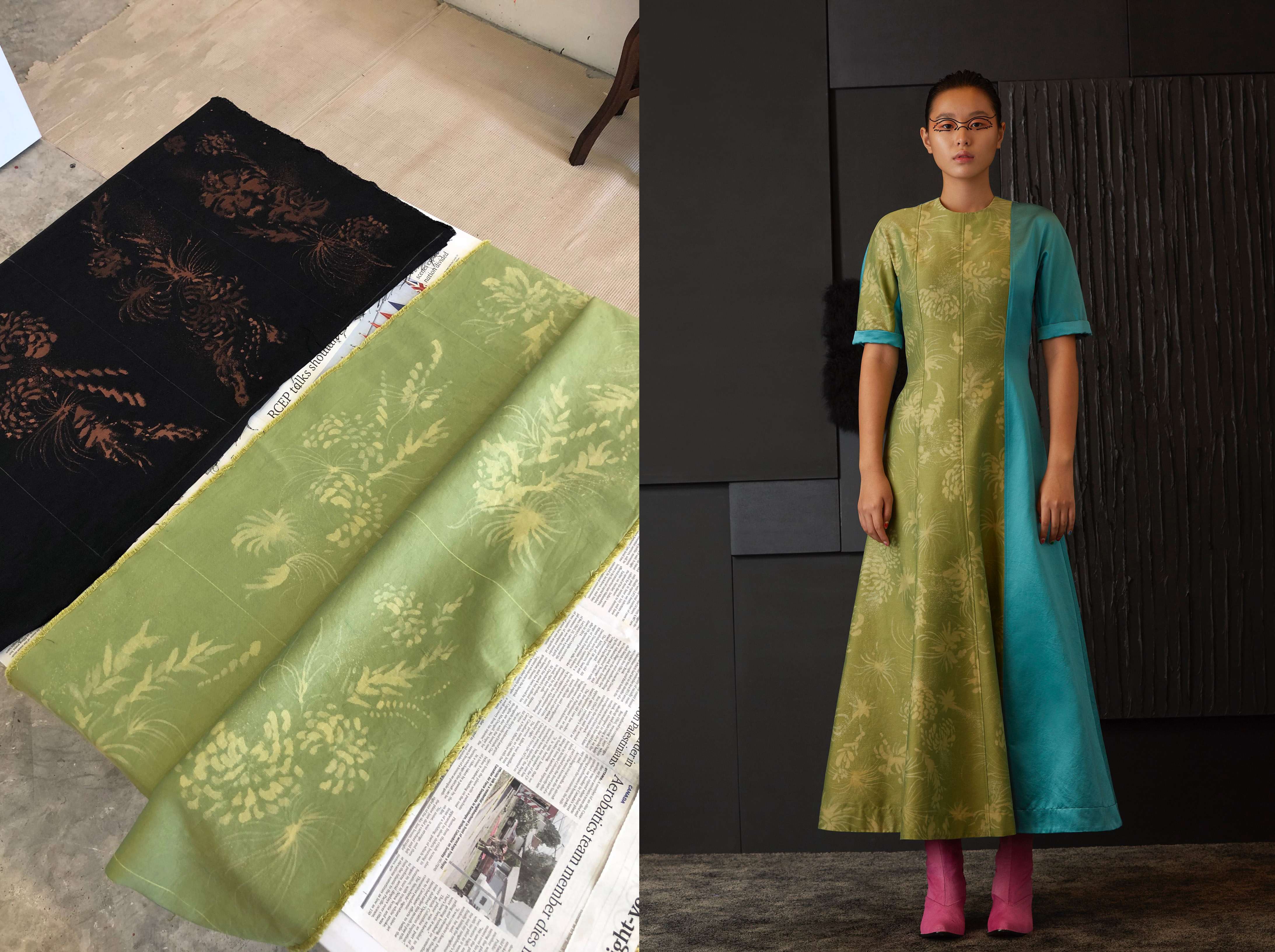
pic. 30 — A double-face cotton silk satin, hand-painted with bleach in a floral pattern from The Brighter World collection 2019 © Shone Puipia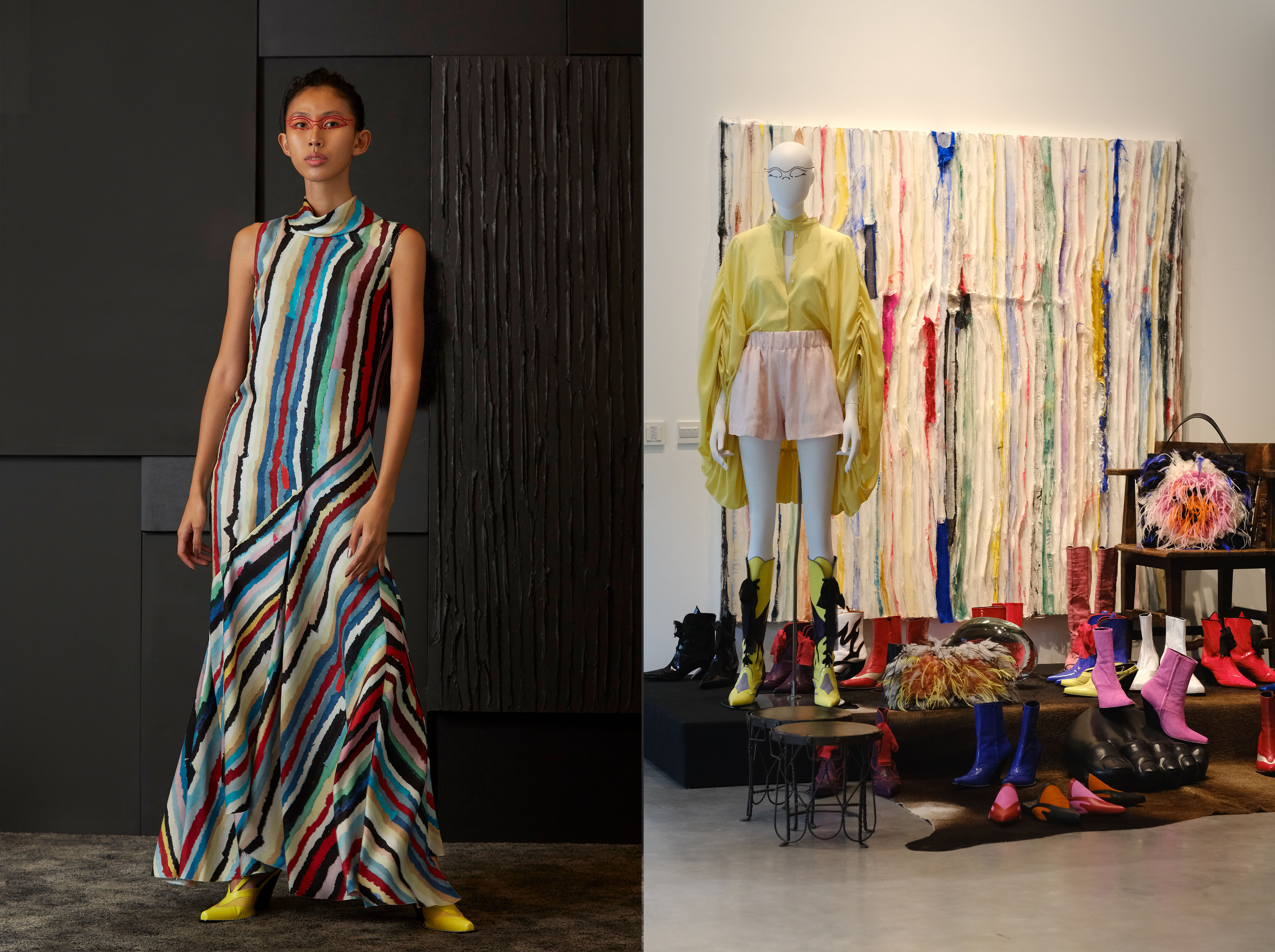
pic. 31 — A print from collage technique from The Brighter World collection 2019 © Shone Puipia
Lauren: I couldn’t agree more with Shone. Fabric to a fashion designer is like a paint to a painter. You can’t make a beautiful garment unless the fabric is beautiful. Fabric is everything. The way I work is when we have done the conceptual research and we see the moodboard, and the technology, and the colors together, we look for authentic fabrics that are correct for that time period …and sometimes we use modern technology when we think it’s appropriate. We did a collection about the women who paved the way to space. That was fun because I was able to play with some new Italian developments from a supplier called Majocchi who, I think, are doing the most interesting things with technical fabric right now. They make interesting resin coated and heat responsive fabrics that change color with your body heat, or fabrics that have been developed for industry… like industrial use for explorations and research like for scientists. I think it’s interesting to look at what’s new and what’s old and what informs us about where we are now. We also work with a lot of small heritage mills in Japan and a couple of heritage mills in Scotland because they often make the kind of fabric that is authentic for the time period where we were looking into. Like authentic denim. A lot of denim mills in Japan are actually using old machinery that was shipped from the US after World War II. We make knitwear fabrics from small old Japanese mills who used really old machines as well. What I like about these machines is that they can use slubby yarns, and that makes the fabric interesting. Industrial machines can’t knit with these slubby yarns because they are built for mass production. There’s one knitting factory in Bangkok that I’m working with to try and make pure cotton, weird, slubby knitwear jerseys and stuff. They wonder why we don’t use polyester, but they do make it for us. They are a family owned business in the Thonburi area. This is a local business that is willing to try out these ideas, which is cool. I do travel a lot. It’s something that I have to reevaluate. I think to move forward I need to keep as much of it in Thailand.
pic. 32 — W’menswear Autumn/Winter 2020 collection research board © Lauren Yates
pic. 33 — Behind the scene at a factory © Lauren Yates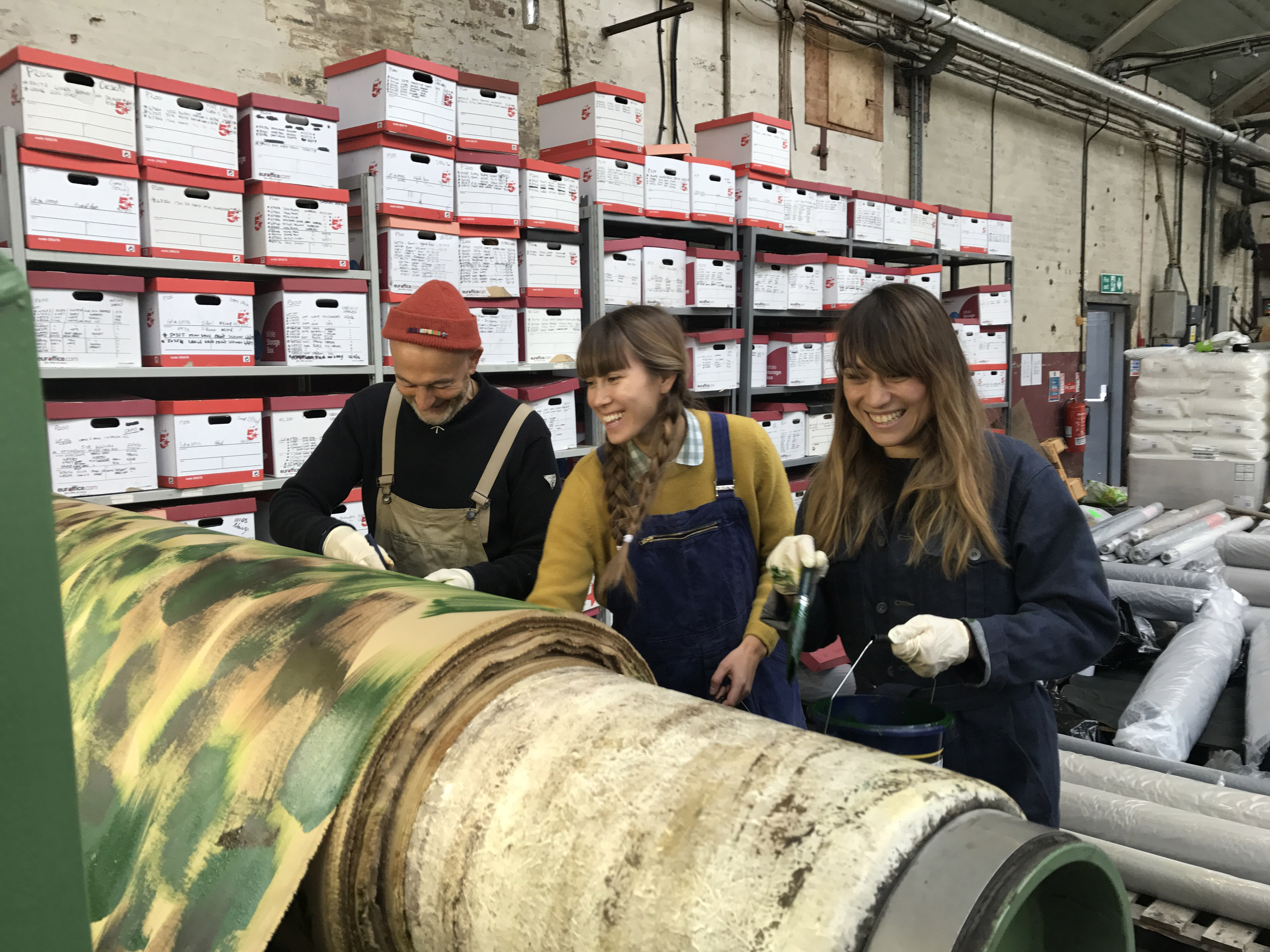
pic. 34 — Behind the scene at a factory © Lauren Yates
pic. 35 — Behind the scene of an outdoor shooting © Lauren Yates
โชน — ตั้งแต่ปี 2558 ตอนกำลังทำโปรเจกต์จบปริญญาโทที่อันท์เวิร์ปอะคาเดมี่ เราทำงานเยอะมากกับที่จิม ทอมป์สัน พัฒนาผ้าใหม่ๆ สำหรับคอลเลกชั่นงานของเรา และล่าสุดมีทำคอลเลกชั่นฉพาะกิจให้กับที่จิม ทอมป์สันด้วย ตอนที่ทำคอลเลกชั่นงานปริญญาโท เราร่วมกันพัฒนาผ้าไหมทอมือเส้นยืนพิมพ์ลายเป็นลายคอลลาจดอกไม้ใบหญ้าแบบเซอร์รีล ตอนนั้นโชคดีมากที่มีโอกาสได้แสดงงานช่างฝีมือไทยในบริบทที่ยุโรป การเล่นกับวัสดุ การพิมพ์ และเทคนิคทำมือต่างๆ เป็นส่วนสำคัญมากงานของเรามาตลอด ในคอลเลกชั่น “The Brighter World” มีชุดที่ทำจากผ้าซาตินไหมผสมฝ้ายทอสองหน้า ที่เราเขียนลายกัดสีด้วยมือเป็นลายดอก มีทำลายผ้าพิมพ์ดิจิทัลจากงานคอลลาจบนกระดาษ ตอนนี้กำลังทดลองทำชุดเดรสระบายจากผ้าไหมไทยถักมือและด้ายเรยองบนโครงชุดเชือกถักเมคราเม่ (macramé)
รูป 30 — ผ้าซาตินไหมผสมฝ้ายทอสองหน้า เขียนลายกัดสีด้วยมือเป็นลายดอก จาก The Brighter World collection 2019 © Shone Puipia
รูป 31 — ลายพิมพ์ผ้าจากเทคนิคคอลลาจ จาก The Brighter World collection 2019 © Shone Puipia
ลอเรน — เราเห็นด้วยกับที่โชนพูดเลย ผ้าสำหรับดีไซเนอร์เสื้อผ้าก็เหมือนสีสำหรับจิตรกร คุณทำเสื้อผ้าสวยๆ ขึ้นมาไม่ได้ถ้าผ้ามันไม่สวยจริงๆ ผ้าคือหัวใจของทุกอย่าง วิธีที่เราทำงานคือหลังจากจบช่วงทำการศึกษาข้อมูลแนวคิดแล้ว มีมู้ดบอร์ดที่มีเทคโนโลยีการตัดเย็บและสีเรียบร้อย เราจะเริ่มขั้นตอนการหาผ้าที่ถูกต้องสำหรับช่วงเวลานั้นๆ บางทีเราต้องใช้เทคโนโลยีใหม่ๆ ในส่วนที่เราคิดว่าต้องใช้ เราเคยทำคอลเลกชั่นผู้หญิงที่ช่วยกรุยทางสู่อวกาศ และคอลเลกชั่นนั้นสนุกมาก เพราะเราได้ทดลองกับผ้าอิตาเลียนชนิดใหม่จากซัพพลายเออร์ชื่อมาร์ยอกคิ (Majocchi) ซึ่งเราคิดว่าตอนนี้มีเทคนิคการทอที่น่าสนใจที่สุด มีทั้งใช้เรซินเคลือบพื้นผิวผ้า และผ้าที่ตอบสนองกับความร้อนโดยจะเปลี่ยนสีไปตามอุณหภูมิร่างกาย หรือผ้าที่พัฒนาขึ้นสำหรับอุตสาหกรรม เช่น ในการสำรวจ หรือการทำวิจัยของนักวิทยาศาสตร์ เราคิดว่ามันน่าสนใจเวลามองว่ามีอะไรใหม่ อะไรที่มีอยู่แล้ว และอะไรที่บอกถึงจุดที่เราอยู่ในตอนนี้ได้บ้าง เรายังทำงานกับโรงทอเล็กๆ แบบดั้งเดิมในญี่ปุ่นและในสก็อตแลนด์ พวกเขายังคงทอผ้าของยุคสมัยที่เรากำลังตามหาอยู่ เช่น ยังทอผ้าเดนิมแบบดั้งเดิม เครื่องทอผ้าเดนิมในญี่ปุ่นส่วนมากเป็นเครื่องเก่าที่นำเข้ามาจากอเมริกาหลังสงครามโลกครั้งที่ 2 เราเคยทำผ้าถักจากโรงทอเก่าแก่เล็กๆ แห่งหนึ่งในญี่ปุ่นที่มีเครื่องทอเก่าเหมือนกัน สิ่งที่เราชอบในเครื่องทอพวกนี้คือมันทอผ้าจากเส้นใยเนื้อหยาบได้ ทำให้ผ้าที่เสร็จออกมามีความน่าสนใจ เครื่องทอในระบบอุตสาหกรรมทอผ้าด้ายหยาบแบบนี้ไม่ได้ เพราะถูกสร้างมาเพื่อการทอแบบจำนวนมาก ตอนนี้มีโรงทอผ้าในกรุงเทพฯ อยู่ที่หนึ่งที่เรากำลังทำงานด้วย กำลังทดลองทำเสื้อถักผ้าฝ้ายล้วนและงานผ้าฝ้ายต่างๆ พวกเขางงมากว่าทำไมเราไม่ใช้ด้ายโพลีเอสเตอร์ แต่ก็ลองทอให้เรา โรงทอนี้เป็นธุรกิจในครอบครัวอยู่ฝั่งธนบุรี นี่เป็นธุรกิจท้องถิ่นที่เต็มใจจะทดลองไปกับเราซึ่งถือว่าเยี่ยมมากๆ ก่อนหน้านี้เราเดินทางเยอะมาก และเราต้องกลับมาประเมินใหม่เหมือนกันเพื่อลดการเดินทางตรงนี้ลง ถ้าจะไปต่อ เราต้องผลิตในเมืองไทยให้เยอะกว่านี้
รูป 32 — รีเสิร์ชบอร์ดของ Autumn/Winter 2020 collection © Lauren Yates
รูป 33 — เบื้องหลังการเยี่ยมชมโรงงาน © Lauren Yates
รูป 34 — เบื้องหลังการเยี่ยมชมโรงงาน © Lauren Yates
รูป 35 — เบื้องหลังการถ่ายภาพ© Lauren Yates
Ung — Ultimately how do you guys see the creation of your clothes? What is your ultimate goal that you want to see your clothes become in terms of both the functionality or a cultural wise? What are your hopes and dreams in terms of business?
Lauren — I hope that there will be a lot more small businesses, or people inspired to start their own small businesses that have integrity. I am really interested in the idea that small businesses are the most important countervailing force of the economy. Back in the 60s or 70s small businesses balanced out corporations, but right now corporations are way too big and powerful. Small businesses are swimming upstream. I hope to inspire more people to start small businesses and also to inspire people to start to support small businesses. It’s better that we can make more balance to the economy. Basically, the economy is not all about money, it’s about people. Without people you have no economy. The market will be much more rich and diverse. It would be much more sustainable because you have a lot more small scale businesses, and they are much more in touch with the community than a corporation can be. I think when things get too big they just grow out of control.
อุ้ง — ท้ายที่สุดแล้ว ทั้งสองคนมองการสร้างสรรค์เสื้อผ้าของตัวเองยังไง เป้าหมายสุดท้ายที่อยากเห็นเสื้อผ้าของตัวเองไปให้ถึงเป็นยังไง ทั้งในแง่ของประโยชน์ใช้สอยหรือในเชิงวัฒนธรรม ความหวังหรือความฝันในแง่ธุรกิจของคุณคืออะไร
ลอเรน — เราหวังว่าจะเกิดธุรกิจขนาดเล็กเพิ่มขึ้น หรือมีแรงบันดาลใจที่จะทำธุรกิจขนาดเล็กที่มีความซื่อสัตย์และจริงใจ เราสนใจในแนวคิดว่าธุรกิจขนาดเล็กนั้นสำคัญที่สุด เป็นแรงผลักสำคัญในเศรษฐกิจ ย้อนกลับไปในยุค 60 หรือ 70 จำนวนธุรกิจขนาดเล็กยังสัมพันธ์กับจำนวนบรรษัทขนาดใหญ่ แต่ตอนนี้บรรษัทมีขนาดใหญ่เกินไปและมีอำนาจเกินไปมาก ธุรกิจขนาดเล็กเหมือนกำลังต้องว่ายทวนกระแส เราหวังจะเป็นแรงบันดาลใจให้คนสร้างธุรกิจขนาดเล็กของตัวเองและให้หันมาสนับสนุนธุรกิจขนาดเล็ก ดีกว่าที่เราทุกคนสามารถสร้างสมดุลในเศรษฐกิจได้ โดยพื้นฐานแล้วเศรษฐกิจไม่ได้เกี่ยวกับเงิน แต่มันเกี่ยวกับผู้คน หากไม่มีผู้คน คุณก็ไม่มีเศรษฐกิจ ตลาดจะร่ำรวยกว่านี้และหลากหลายกว่านี้ได้ และยั่งยืนมากกว่าด้วย เพราะคุณมีธุรกิจขนาดเล็กและพวกเขาใกล้ชิดกับชุมชนมากกว่าที่บรรษัทขนาดใหญ่จะทำได้ เราคิดว่าเวลาสิ่งต่างๆ เติบโตมากเกินไปมันก็จะเริ่มคุมไม่อยู่
Shone — I want to inspire people to make more pure beauty or untainted, that’s a core value. I hope we all lead the way. Clothes are very personal, it’s something when you see it and you get excited. I’m hopeful about the future.
Ung — These values that are very important are being less prioritised nowadays. It’s our time to diminish fast fashion and inspire people to support more small businesses and enjoy more beauty. Ultimately we all aim for freedom. That’s embedding in both of your work. It’s a relief for me as well. I always crave for this kind of creativity but I find it’s hard to balance this out in the context right now where there is a lot of pressure and power is dominating.
โชน — เราอยากเป็นแรงบันดาลใจให้คนทำงานที่สวยบริสุทธิ์หรือไม่แปดเปื้อน เป็นหัวใจหลักของงาน เราหวังว่าพวกเราทุกคนจะไปทางนั้น เสื้อผ้าเป็นเรื่องส่วนตัวมาก เป็นของที่คุณตื่นเต้นเวลาคุณเห็น และเราก็ค่อนข้างมีความหวังกับอนาคต
อุ้ง — คุณค่าสำคัญๆ เหล่านี้ไม่ได้ถูกจัดลำดับไว้เป็นต้นๆ เลย ถึงเวลาแล้วที่เราต้องลดการบริโภคฟาสต์แฟชั่นลงและสร้างแรงบันดาลใจให้คนหันมาสนับสนุนธุรกิจขนาดเล็กและสนุกไปกับความงามมากขึ้น ท้ายที่สุดแล้ว เราทุกคนมุ่งหวังในอิสรภาพ และแนวคิดนี้ฝังลงในงานของทั้งสองคน ซึ่งทำให้เราค่อนข้างโล่งใจที่ได้เห็น เพราะเราหาความคิดสร้างสรรค์แบบนี้มาโดยตลอด แต่พบว่ายากมากเลยที่จะสมดุลย์มันออกมาให้ดีในบริบทปัจจุบัน ที่มีแรงกดดันมากมายและมีอำนาจกำลังครอบงำอยู่ตอนนี้
Image credits
pic. 1, 2, 5, 6, 7, 8, 17, 18, 19, 26, 27, 30, 31 — Image courtesy of Shone Puipia
pic. 7, 10, 11, 12, 13, 14, 15, 16, 20, 21, 22, 28, 32, 33, 34, 35 — Image courtesy of Lauren Yates
pic. 23, 24, 25 — Image coutersy of Fashion Revolution Thailand
pic. 3 — Artemisia Gentileschi “public domain in the US”
pic. 4 — Portia Wounding Her Thigh “public domain in the US”
pic. 8 — Sylvia Earle “public domain in the US”
pic. 9 — Sylvia Earle “public domain in the US”
pic. 29 — British Vogue Frontline Workers
เครดิตภาพ
รูป 1, 2, 5, 6, 7, 8, 17, 18, 19, 26, 27, 30, 31 — ภาพโดยความอนุเคราะห์จากโชน ปุยเปีย
รูป 7, 10, 11, 12, 13, 14, 15, 16, 20, 21, 22, 28, 32, 33, 34, 35 — ภาพโดยความอนุเคราะห์จากลอเรน เยทส์
รูป 23, 24, 25 — ภาพโดยความอนุเคราะห์จาก Fashion Revolution Thailand
รูป 3 — Artemisia Gentileschi “public domain in the US”
รูป 4 — Portia Wounding Her Thigh “public domain in the US”
รูป 8 — Sylvia Earle “public domain in the US”
รูป 9 — Sylvia Earle “public domain in the US”
รูป 29 — British Vogue Frontline Workers
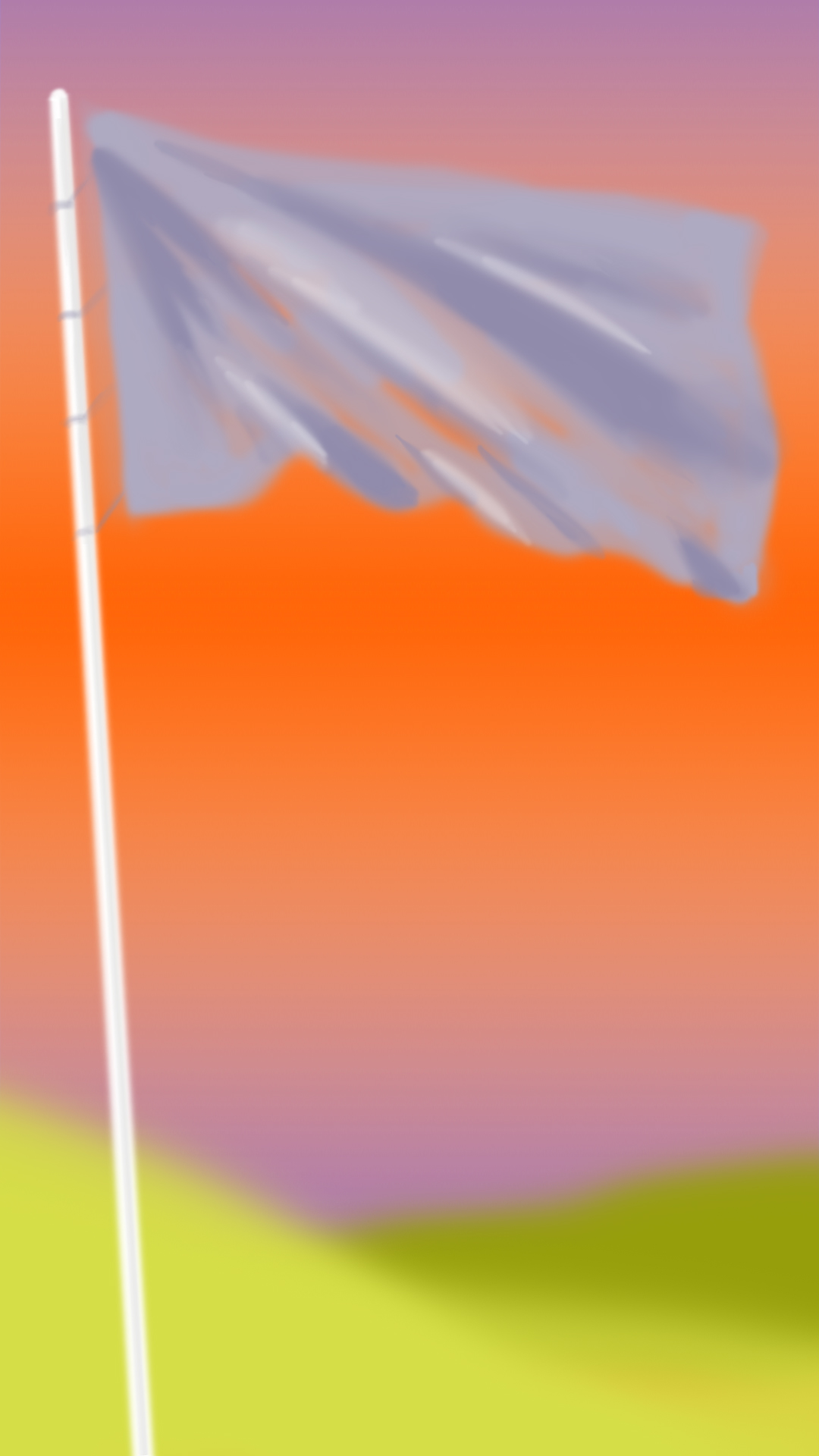
Kamonnart Ongwandee (Ung) is a textile designer with interests in local craftsmanship and their applications to contemporary products. She is also a coordinator of Fashion Revolution Thailand, a coordination unit on the promotion of sustainable fashion production and consumption through series of activities, talks, exhibitions, with an aim for better living of both fashion producers and consumers.
Shone Puipia (Shone) is a fashion designer with his own made-to-order fashion studio and showroom, Shone Puipia. His love of art is influenced by his upbringing in a family where both parents are artists. He takes making clothes as the same as making sculptures from fabrics, filling in his imagined wardrobe while telling his unique stories through each collection he designs.
Lauren Yates (Lauren) is the founder of an online diary Ponytail Journal that explores lifestyle, history, clothes, food and travel which later on extended to a fashion brand she founded called W’menswear. W’menswear is workwear inspired clothing for women with a slogan ‘Hard hitting garments for hard hitting women’.
กมลนาถ องค์วรรณดี (อุ้ง) นักออกแบบสิ่งทอ ที่สนใจงานหัตถกรรมท้องถิ่นและการนำมันมาใช้อย่างร่วมสมัย อุ้งเป็นผู้ประสานงานกลุ่มขับเคลื่อนทางสังคม Fashion Revolution ประเทศไทย จัดกิจกรรมสื่อสาร และชวนตั้งคำถามถึงความยั่งยืนของการผลิตและการบริโภคสินค้าแฟชั่น เพื่อความเป็นอยู่ที่ดีของทั้งผู้ผลิตและผู้บริโภค
โชน ปุยเปีย (โชน) นักออกแบบเสื้อผ้าที่เปิดห้องเสื้อเป็นของตัวเองในชื่อ Shone Puipia และตัดเย็บเสื้อผ้าแบบตามสั่ง โชนสนใจในศิลปะเพราะเติบโตมาในครอบครัวของศิลปิน ทำให้มองการสร้างเสื้อผ้าเหมือนกับการสร้างงานประติมากรรมด้วยผ้า และเล่าเรื่องที่เขาสนใจผ่านการออกแบบเสื้อผ้า เพื่อทยอยเติมลงสู่ตู้เสื้อผ้าในจินตนาการ ที่ค่อยๆ ช่วยร้อยเรียงเรื่องเล่าของเขา
ลอเรน เยทส์ (ลอเรน) เจ้าของไดอารี่ออนไลน์ Ponytail Journal ที่สำรวจเกี่ยวกับไลฟ์สไตล์ ประวัติศาสตร์ เสื้อผ้า อาหาร และการท่องเที่ยว ซึ่งต่อยอดออกมาเป็นแบรนด์เสื้อผ้าในชื่อ W’menswear เสื้อผ้าแนวเวิร์คแวร์สำหรับผู้หญิง ด้วยแนวคิดที่ใส่ใจวัสดุ ขั้นตอนการผลิต ผู้ผลิต และผู้บริโภค โดยมีสโลแกนว่า ‘Hard hitting garments for hard hitting women’ (เสื้อผ้าจริงจัง สำหรับผู้หญิงจริงใจ)
An illustration by Napisa Leelasuphapong derived from her interpretation of the change in production and consumption values that people today hold onto into a flag as a sign for a group of persons with the shared ideology, uniting to form a nation or a revolution to a better future.
ภาพประกอบบทความโดย นภิษา ลีละศุภพงษ์ เกิดจากการตีความคุณค่าที่เปลี่ยนไปของการผลิตและการบริโภคของผู้คนร่วมสมัยยึดถึอ ออกมาเป็นธง ในฐานะที่เป็นสัญลักษณ์ของการรวมกลุ่มของผู้คนที่มีความเชื่อร่วมกัน ที่รวมตัวกันเพื่อสร้างชาติ หรือทำการปฏิวัติไปสู่สิ่งที่ดีกว่า
Proofread by Supamas Phahulo, Nunnaree Panichkul, and Napisa Leelasuphapong
พิสูจน์อักษรโดย ศุภมาศ พะหุโล, นันท์นรี พานิชกุล, นภิษา ลีละศุภพงษ์
ถอดความเป็นภาษาไทยโดย นันท์นรี พานิชกุล